Magazines about Robert Wise, The Haunting or Shirley Jackson † Books about RW, The Haunting or SJ † Homage
Magazines & books about Robert Wise, The Haunting or Shirley Jackson
Magazines about Robert Wise, The Haunting or Shirley Jackson
'Famous Monsters of Filmland' (USA)
Mar., 1962 - No. 16
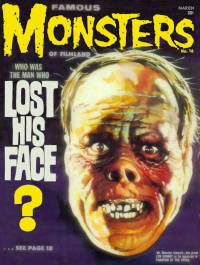

Issue: Mar., 1962 - No. 16
Language: English
Country: USA
Content: A 2-line mention of the film's cast.
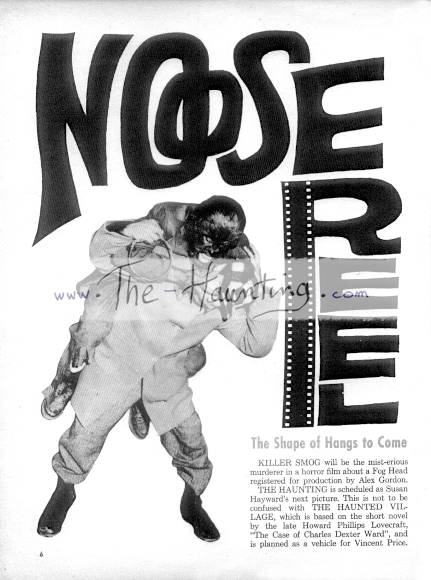
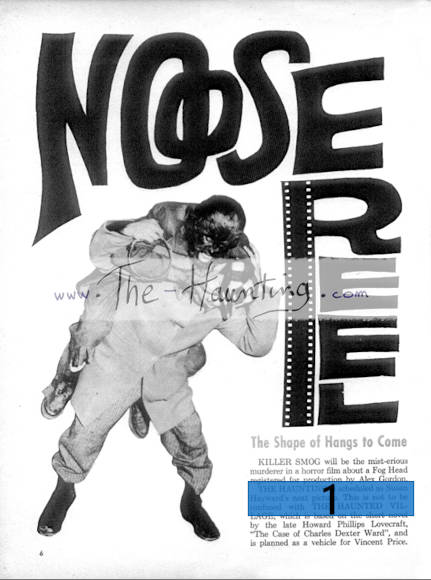
Page 6
The Haunting is scheduled as Susan Hayward's next picture.
Aug., 1963 - No. 24
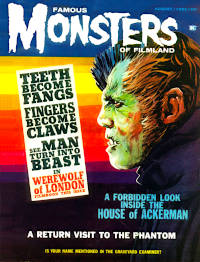

Issue: Aug., 1963 - No. 24
Language: English
Country: USA
Content: One third of a column, very short report about the movie. A few words about the American actors chosen for the cast.

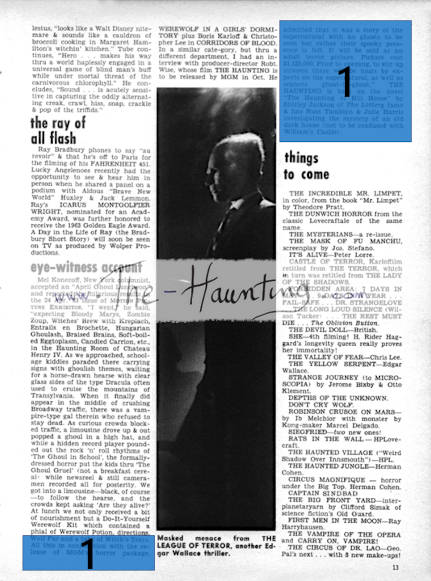
Page 13
"[...] All this in conjunction with the release of MGM's horror package, admitted tht it was a story of the supernatural with no ghosts to be seen but rather their spooky presence is felt. It will be sold as an adult terror picture. Picture cost $1,125,000. Prior to opening, to stir up interest there will be tours by experts on the supernatural, as well as seances ghost-to-ghost."
The Haunting is based on the novel "The Haunting of Hill House" by Shirley Jackson of The Lottery fame & has Russ Tamblyn & Julie Harris investigating the mystery of an old dark house (not to be confused with William's Castle).
Nov., 1972 - No. 94
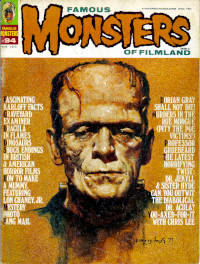

Issue: Nov., 1972 - No. 94
Language: English
Country: USA
Content: Eleven full pages, all in black & white, with pictures, with 4 lines about The Haunting.
They feature an article titled "Shock-a-bye Baby! — A fright film list of American & British horror flicks with shock and surprise endings. It is the screaming end!", by Thomas Rogers.
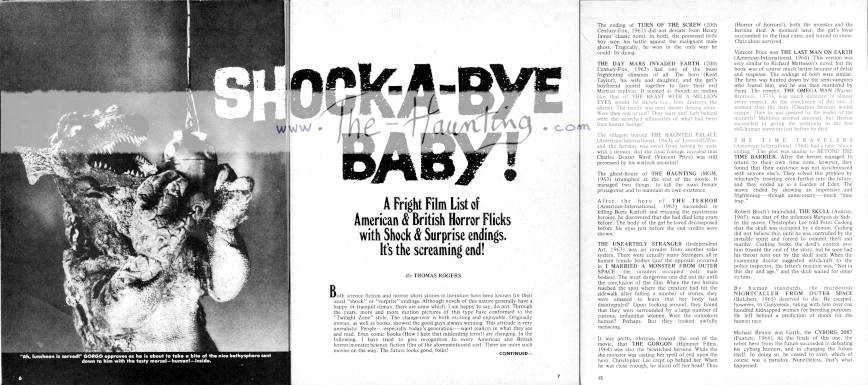

Page 12
The ghost-house of The Haunting (MGM, 1963) triumphed at the end of the movie. It managed two things: to kill the main female protagonist and to maintain its own existence.
Jul.-Aug., 2015 - No. 280



Issue: Jul.-Aug., 2015 - No. 280
Language: English
Country: USA
Content: Four full pages, all in colour, with pictures.
They feature an article titled "Born bad: the legacy of Robert Wise's The Haunting", by Alexandra West.

Page 26, very short excerpt
As many have explored in academic writings, the haunted house or "traumatized house" represents a fear of the American ideal, offering the notion that the very goals prescribed to us are nothing more than a trap and something to be feared. THE HAUNTING presents Hill House, a house "born bad" that exploits the fears and psychologies of its inhabitants and our history. Hill House represents a holdover from the New World with Puritan ideologies, a clinging vestige to our collective past. As horror master Stephen King writes of THE HAUNTING in his treaties on tenor DANSE MACABRE: "The interesting thing lies in the fact that we never actually see whatever it is that haunts Hill House. Something is there, all right. Something knocks on the wall with a sound like a cannon fire... this same thing causes a door to bulge grotesquely inwards until it looks like a great convex bubble... but it is a door Wise elects never to open." Had Wise elected to open that door, so much of what haunts THE HAUNTING would have been taken away. We would see the man working the controls who would have clearly explained Nell's psychosis or the terrifying ghosts that are waiting around every turn in Hill House. THE HAUNTING never provides us with answers — only terrifying darkness.
'Kine Weekly' (UK)
Nov. 15, 1962 - Vol. 546, No. 2876
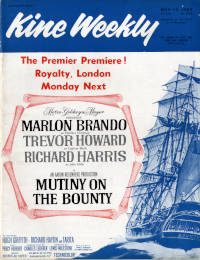

Issue: Nov. 15, 1962 - Vol. 546, No. 2876
Language: English
Country: UK
Content: One page (black & white) discussing various productions contains an article with picture about the movie.
Page 18
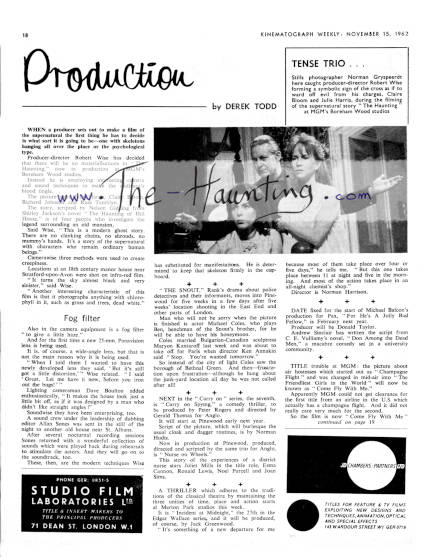
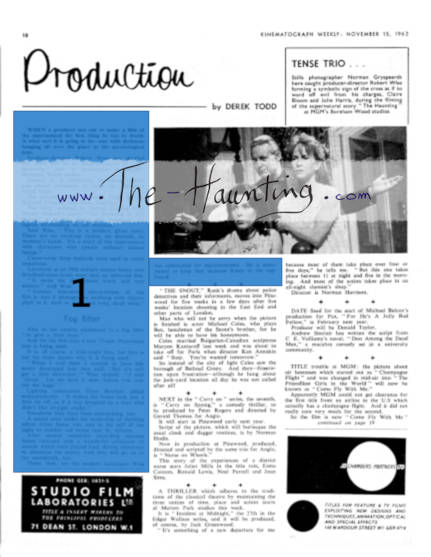
When a producer sets out to make a film of the supernatural the first thing he has to decide is what sort it is going to be — one with skeletons banging all over the place or the psychological type.
Producer-director Robert Wise has decided that there will be no materialisations in "The Haunting," now in production at MGM's Boreham Wood studios. Instead he is employing interesting camera and sound techniques to make the audience's blood tingle.
The picture stars Julie Harris, Claire Bloom. Richard Johnson and Russ Tamblyn. The story, scripted by Nelson Gidding from Shirley Jackson's novel "The Haunting of Hill House," is of four people who investigate the legend surrounding an old mansion.
Said Wise, "This is a modern ghost story. There are no clanking chains, no shrouds, no mummy's hands. It is a story of the supernatural with characters who remain ordinary human beings."
Camera-wise three methods were used to create creepiness. Locations at an 18th century manor house near Stratford-upon-Avon were shot on infra-red film. "It turns the sky almost black and very sinister," said Wise. "Another interesting characteristic of this film is that it photographs anything with chlorophyll in it, such as grass and trees, dead white." Also, in the camera equipment is a fog filter "to give a little haze." And for the first time a new 25-mm. Panavision lens is being used. It is, of course, a wide-angle lens, but that is not the main reason why it is being used. "When I told them I wanted to have this newly developed lens they said, 'But it has still got a little distortion,' " Wise related. "I said 'Great. Let me have it now, before you iron out the bugs! ' " Lighting cameraman Dave Boulton added enthusiastically, "It makes the house look just a little bit off, as if it was designed by a man who didn't like straight angles"
Sound-wise they have been enterprising, too. A sound crew under the leadership of dubbing editor Allan Sones was sent in the still of the night to another old house near St. Albans. After several nocturnal recording sessions Sones returned with a wonderful collection of sounds which were played back during rehearsals to stimulate the actors. And they will go on to the soundtrack, too.
These, then, are the modern techniques Wise has substituted for manifestations. He is determined to keep that skeleton firmly in the cupboard.
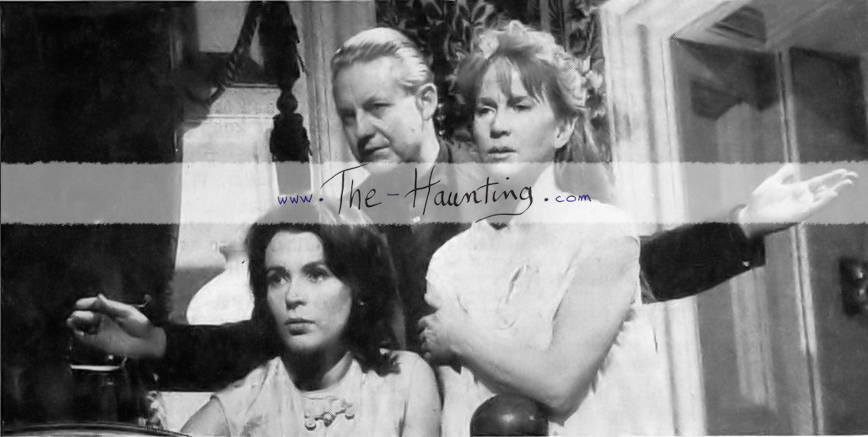
Connoisseurs will notice that this is a quite rare promotional picture. I own nearly a hundred of them but not this one.
Dec. 13, 1962 - Vol. 547, No. 2880
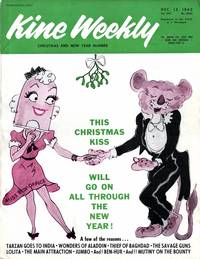

Issue: Dec. 13, 1962 - Vol. 547, No. 2880
Language: English
Country: UK
Content: One page (p109, black & white) fully describes the technical capabilities of the British MGM studio. See the page dedicated to the house for all details. Another page (p152, black & white) mentions the wrap up for Julie Harris.
Page 109, article by Maurice Foster (See the page dedicated to the house for all details.)
Page 152, production by Derek Todd
After completing her starring role in "The Haunting" at MGM's Boreham Wood studio on Christmas Eve, Julie Harris will fly to New-York for an important television commitment.
She is to play Eliza Doolittle in Bernard Shaw's "Pygmalion."
With Julie Harris in "The Haunting," produced and directed by Robert Wise for MGM, are Claire Bloom, Richard Johnson and Russ Tamblyn.
'Life' (USA)
Sep. 22, 1947
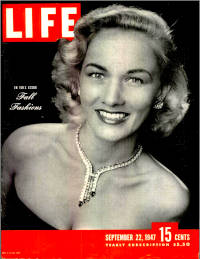

Issue: Sep. 22, 1947
Language: English
Country: USA
Content: Two full pages, then seven half pages, all in black & white, with pictures.
They feature an article titled "A Who's Who of English ghosts", by Noel F. Busch.
I mention this article because it was mentioned a decade later in the Oct. 28, 1957 article (see below).
You might be intrigued to read what was considered in 1947 the must-have kit for any well-appointed British ghost-hunter:
- Pair soft felt overshoes
- Steel measuring tape
- Screw eyes
- Lead seals and sealing tool
- White tape
- Toolbox and nails
- Hank of flax
- Small electric bells
- Dry batteries and switches
- Camera, films and flash bulbs
- Notebook
- Red, blue and black pencils
- Sketching block and case of drawing instruments
- Bandages
- Iodine
- Surgical adhesive tape
- Ball of string
- Stick of chalk
- Matches
- Electric torch and candle
- Bowl of mercury to detect tremors in room or passage (ghosts like passages)
- Cinematograph camera with electrical release
- Flask of brandy
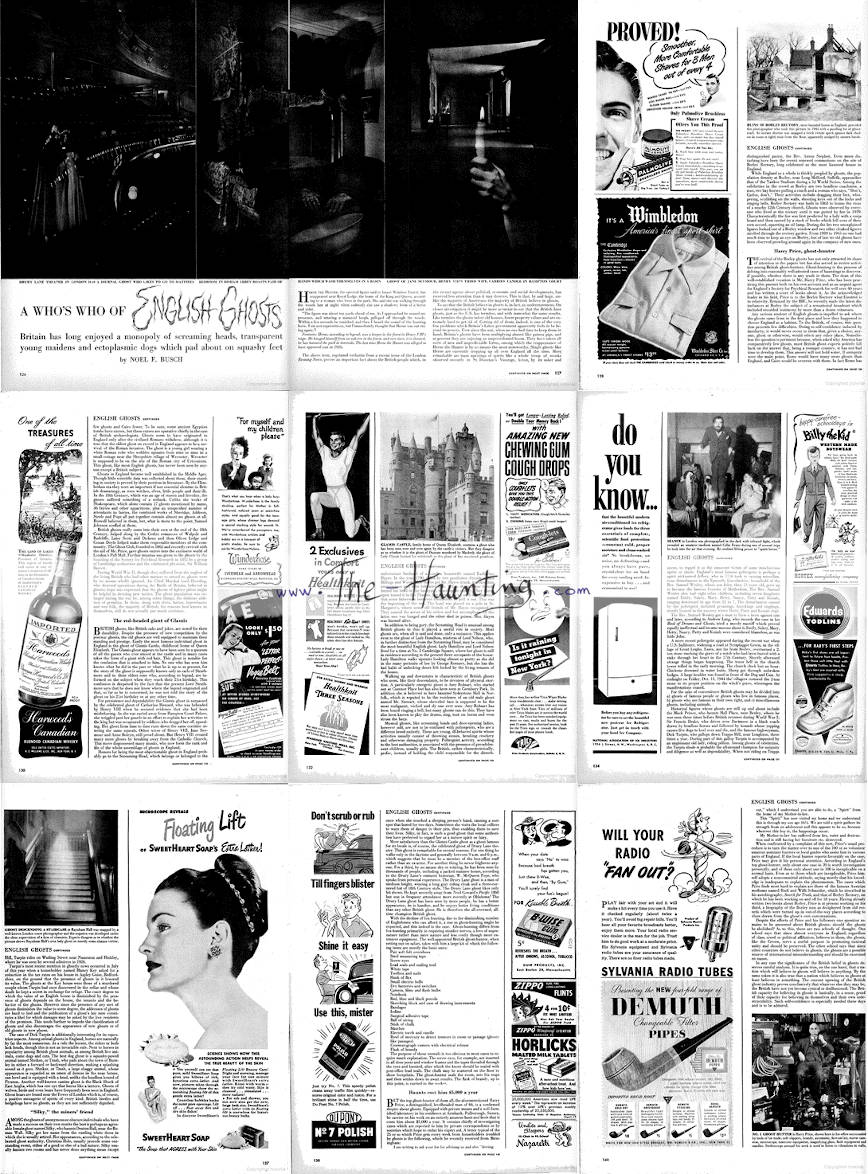
The magazine was scanned by Google and is available here.
Jan. 11, 1954
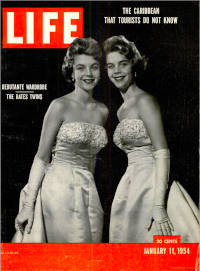

Issue: Jan. 11, 1954
Language: English
Country: USA
Content: Two full pages, then seven half pages, all in black & white, with pictures.
They feature an article titled "A case for ESP, PK and PSI", by Aldous Huxley.
I mention this article because it was mentioned in the Mar. 17, 1958 article (see below).
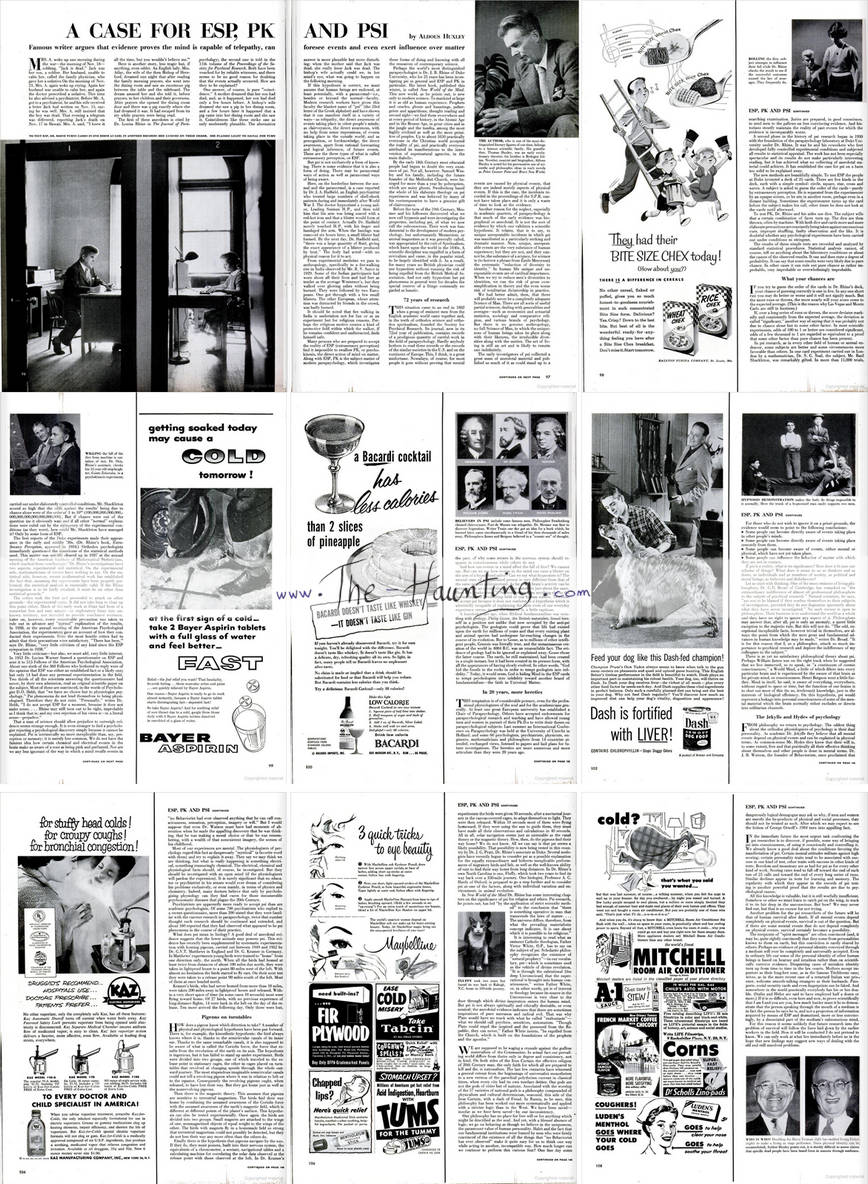
The magazine was scanned by Google and is available here.
Oct. 28, 1957
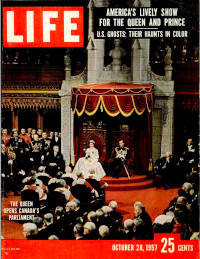

Issue: Oct. 28, 1957
Language: English
Country: USA
Content: Twelve full colour pages, with pictures.
They feature a collection of short stories titled "Ghostly american legends", illustrated by pictures taken by Nina Leen.
According to a well-informed expert fan, Robert Wise had 6 copies of this magazine in his "The Haunting" file. They were probably used for ideas, inspiration or research.
The list of short stories of the article includes:
- A lovelorn lass
- The Baldwin lights
- An irascible old aunt
- A cry of death
- Ominous hoofbeats
- The bell witch of Tennessee
- A pirate's caretaker
- The welcome guest
- By moonlight burned

The magazine was scanned by Google and is available here.
Mar. 17, 1958
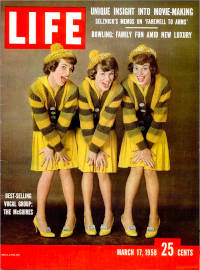

Issue: Mar. 17, 1958
Language: English
Country: USA
Content: One full page, then five half pages, all in black & white, with pictures.
They feature an article titled "House of flying objects", by Robert Wallace.
I mention this article because it describes a New-York based poltergeist case, investigated by both the police and by Dr. Rhine's assistant, Dr. J. Gaither Pratt.
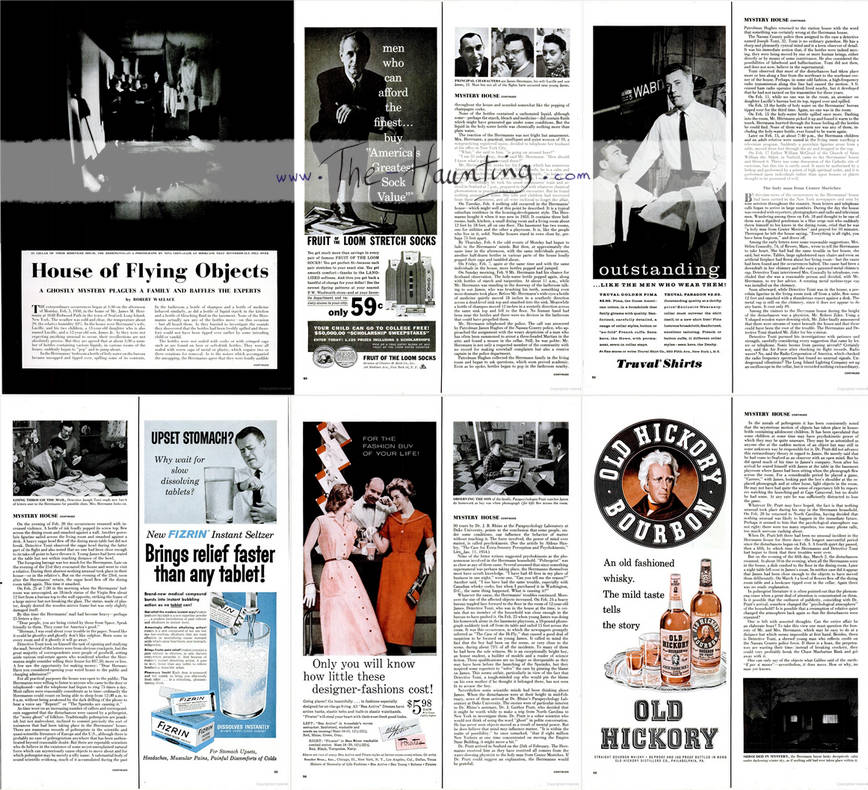
The magazine was scanned by Google and is available here.
Aug. 30, 1963
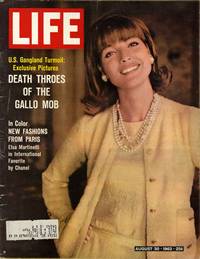

Issue: Aug. 30, 1963
Language: English
Country: USA
Content: All black & white: one full page, three half-pages (2 with pictures, 1 with essay). They feature a short article titled "Great new scary film", followed by an essay by Dora Jane Hamblin titled "Go on, frighten us to death, we love it!"

Child ages in 20 seconds. Great new scary film. [Full text]
Everybody who has brooded over the way life speeds — and who hasn't? — will get goose-pimples from the sequence here in a wonderfully scary movie called "The Haunting", as convincing and chilling as "The turn of the screw", based on Shirley Jackson's novel "The Haunting of Hill House", it begins as a little girl goes to live in an isolated monstrosity of a house built by her father. As the family carriage approaches the house, the horses rear in terror at some aura of evil, and the girl's mother is killed. The child goes to live in the house's nursery and there grows old in a 20-second photographic trick, and dies crying out futilely for help. The terror mounts as a professor brings an odd pair of researchers to help him check the house for supernatural influences. One is a woman with extrasensory perception, the other is near-hysteric. The women, brilliantly acted by Julie Harris and Claire Bloom, find they can't sleep nights, in that house. Audiences will find they can't sleep afterwards either.
Kept awake by hideous noises, two researchers, Claire Bloom and Julie Harris, are too scared to scream.
Terror becomes hysterical laughter as the professor, who hasn't heard a thing, asks the girls what happened.
Setting for shudders in "The Haunting" is a real haunted house — an 18th century manor in England — chosen by producer-director Robert Wise. Legend says a ghost stalks the turrets — the ghost of a girl who threw herself from a balcony one Friday because she couldn't marry her lover. "We didn't film on Fridays," says Wise.
Go on, frighten us to death, we love it! [Excerpt]
[...] The truth is, most people love to be scared. Some friends of mine went to see "The Haunting", taking along their purses and their white gloves, their glasses and their cigarets. During the course of the movie they jumped in and out of their seats and each other's laps so many times out of sheer terror that it took 15 minutes after the lights went on to sort their belongings, all of which had landed in a heap on the floor and had, in fact, rather impeded their own movements as they tried to crawl under the seats. When they all had their own gloves and glasses back, they judged the film "wonderful". [...]
The magazine was scanned by Google and is available here.
'Positif' (France)
Dec. 1963, No. 57
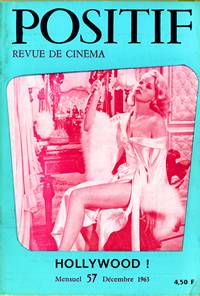

Issue: Dec. 1963, No. 57
Language: French
Country: France
Content: Half a page, in black & white. The movie is reviewed by Robert Benayoun.
I can't show you the inside of the magazine without destroying the binding: it prevents from scanning the magazine flat.
Page 46 (Original French)
Pourquoi Robert Wise, après une comédie musicale trépidante, s'est-il perdu dans le film d'horreur ? demandera l'historien en peine d'étiquettes. Question que le laisserai délibérément sans réponse, puisqu'aussi bien "The Haunting" est un triomphe de Wise sur l'Hitchcock de "Psycho", pour ne prendre qu'un seul exemple, et échappe du même tout à toutes les catégories un peu hâtives.
C'est plus qu'autre chose un film sur la peur, la peur irrationnelle, panique et presque obscène, que rien ne rationalise. Dans cette maison hantée que visitent deux médiums et un parapsychologue éminent, rien sans doute n'existe, que les fantômes de notre subconscient. Mais si la peur est transférable, si elle s'agglutine autour du moindre noyau d'ombre et de refoulement, elle peut assumer les proportions d'un cataclysme hurlant, d'une régression vers l'inhumain. Robert Wise fuit, ici, toute explication, mais il déchaine sur nous un sabbat immatériel, qui est l'expérience la plus terrifiante du genre. Car si aucun monstre ne nous apparaît, si nul crime n'est commis, ce n'est pas au profit d'une sobriété, d'une discrétion ascétiques, visant à la stéréotypie. Non, l'hystérie, la démesure bouleversent notre attente, et nous enlèvent tout contrôle critique. La machinerie hitchcockienne, à base de petites observations, de gradations subtiles et de calculs savants est rejetée en faveur d'un mouvement lyrique tortueux et irrésistible. L'art de Wise éclate d'autant mieux qu'il défie le sujet, domine jusqu'à l'interprétation hors pair de Julie Harris, Claire Bloom, Richard Johnson. Je ne connais rien (à l'exception peut-être des "Innocents") qui se rapproche autant de la magie.
Page 46 (English translation)
Why did Robert Wise, after a hectic musical, get lost in the horror film? asks the historian in need of labels. A question that he would deliberately leave unanswered, since "The Haunting" is a triumph of Wise over the Hitchcock of "Psycho", to take just one example, and escapes all the somewhat hasty categories.
It is more than anything else a film about fear, irrational, panicky and almost obscene fear, which nothing rationalises. In this haunted house visited by two mediums and an eminent parapsychologist, nothing undoubtedly exists but the ghosts of our subconscious. But if fear is transferable, if it agglutinates around the slightest nucleus of shadow and repression, it can assume the proportions of a screaming cataclysm, of a regression towards the inhuman. Here Robert Wise avoids any explanation, but he unleashes upon us an immaterial Sabbath, which is the most terrifying experience of the genre. For if no monster appears to us, if no crime is committed, it is not for the benefit of ascetic sobriety, ascetic discretion, aiming at stereotyping. No, hysteria and excessiveness upset our expectations and take away all critical control. The Hitchcockian machinery, based on small observations, subtle gradations and learned calculations, is rejected in favour of a tortuous and irresistible lyrical movement. Wise's art explodes all the more as it defies the subject, dominating even to the unparalleled interpretations of Julie Harris, Claire Bloom, Richard Johnson. I don't know anything (with the possible exception of the "Innocents") that comes so close to magic.
'Les cahiers du cinéma' (France)
Dec. 1963-Jan. 1964, No. 150-151
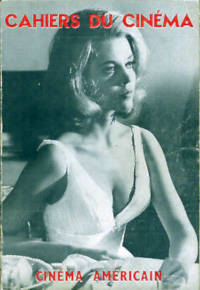

Issue: Dec. 1963-Jan. 1964, No. 150-151
Language: French
Country: France
Content: Two full pages, in black & white. Robert Wise gives an update about his forthcoming projects ("The sound of Music" & "The sand peebles"). He briefly mentions "The Haunting" as his last movie.
Apr. 1964, No. 154
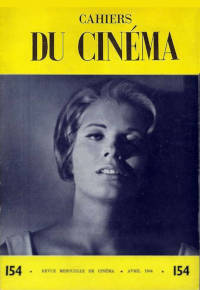

Issue: Apr. 1964, No. 154
Language: French
Country: France
Content: Listing of movies released in Paris, France between Feb. 12 - March 10, 1964. Four lines about "The Haunting".
Page 77 (Original French)
The Haunting (La Maison du Diable), film en Scope de Robert Wise, avec Julie Harris, Claire Bloom, Richard Johnson, Russ Tamblyn. — Un château hanté ; si l'on voulait vraiment nous faire peur, il fallait plus nettement choisir entre la convention (mais le script essaie d'y échapper) ou la rigueur (que la mise en scène fuit obstinément).
Page 77 (English translation)
The Haunting (La Maison du Diable, literally The Devil's House), film in Scope by Robert Wise, with Julie Harris, Claire Bloom, Richard Johnson, Russ Tamblyn. — A haunted castle; if they really wanted to scare us, they had to choose more clearly between convention (but the script tries to escape it) or rigour (which the director stubbornly avoids).
May 1964, No. 155
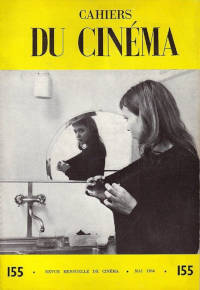

Issue: May 1964, No. 155
Language: French
Country: France
Content: Two pages and a half, in black & white, including one picture. They feature an article by Michel Mardore titled "Les folles du logis", which is a double review: "The Haunting" & "The Fall of the House of Usher"
Remark: You might be puzzled by the English translation, because it makes no sense. Don't worry. It is because the original in French also makes no sense and I strongly disagree with almost all of it.
Page 50 to 52 (Original French), excerpt:
The Haunting (La Maison du Diable), film américain en Panavision de Robert Wise. Scénario : Nelson Gigging, d'après le roman de Shirley Jackson. Images : David Boulton. Musique : Humphrey Searle. Montage : Ernest Walter. Interprétation : Julie Harris, Claire Bloom, Richard Johnson, Russ Tamblyn, Lois Maxwell, Rosalie Crutchley, Fay Compton, Valentine Dyall. Production : Robert Wise, Argyle Enterprises. 1963. Distribution : M.G.M.
L'argument qui conduit à réunir ces films, de conception assez différentes, dans la même analyse, pourra sembler superficiel : la clé, esthétique et morale, des deux entreprises est l'idée de capture, d'une possession réciproque de l'inanimé et du vivant. Comme, dans les deux cas, une maison (avec toute la force psychanalytique attachée à ce symbole) est le lieu où la fusion entre l'être et l'objet s'opère, le décor devenu agent et sujet, le rapprochement s'impose : il aboutit à un double constat de faillite.
L'impression de vie autonome et d'omnipotence maléfique, dont ces demeures devraient nous convaincre, n'est jamais véritablement communiquée au spectateur. Pour The Haunting, la gravité de l'échec est plus évidente, Robert Wise ne cachant pas son ambition. Alors qu'il annonce comme un postulat, et répète durant tout le film, que Hill House est vivante, jamais ses images ne parviennent à nous révéler cette existence supranormale et ce pouvoir de la matière filmée. D'autre part, les temps de repos ne trahissent aucun mystère latent, et la réalisation renchérit sur l'insignifiance et l'inexpressivité des êtres et des choses ; d'autre part, les temps forts, où se manifeste la puissance occulte, servent de prétexte à un festival technique d'une pauvreté qui inspire davantage de tristesse que d'effroi. Toute la terreur de l'inconnu tiendrait donc dans ces travelings, ces contreplongées naïves, ces distorsions caligaresques de l'image (par utilisation, pour la première fois à notre connaissance, d'objectifs à court foyer couplés avec les anamorphoseurs du Scope), sans parler des cris d'épouvante que poussent les personnages, ni du tonitruant appoint musical ? Enfin, lorsque le bric-à-brac visuel ne peut évoquer, même de façon caricarturale, un sentiment trop subtil, on recourt au dialogue et au commentaire : les personnages occupent leur temps libre à dire : "Il se passe telle et telle chose ... Je ressens ceci et cela ..." A défaut de ces explications, de ces tentatives de suggestion, nous serions bien incapables de détecter une ombre d'activité ou de simple influence émanant de la fameuse maison. Sans accabler Robert Wise, car la cinématographie de l'invisible est une gageure, on doit rappeler que d'autres cinéastes ont jadis relevé le même défit — à commencer par Murnau et Dreyer — et ne se sont pas mal tirés de l'épreuve. Le véritable problème de la "métaphysique" au cinéma tient dans ce genre de pari, et celui qui joue avoue son incapacité de créateur.
Il est vrai qu'à partir de cet escamotage du fantastique, on infère à loisir une ambigüité troublante des intentions. Wise ne croirait guère aux maisons hantées : pour lui, l'angoisse ressentie au contact de phénomènes étrangers et inexpliqués cristalliserait nos obsessions et nos névroses, jusqu'à l'exécution des événements désirés en secret par notre subconscient (ici, Julie Harris meurt pour satisfaire le voeu d'autopunition né d'un complexe de culpabilité). L'idée n'est pas nouvelle, et la science-fiction a déjà envisagé l'utilisation de véritables champs de forces magnétiques issus de notre activité mentale. Cette arrière-pensée des auteurs justifierait l'attitude aberrante de ce psychiatre, qui introduit comme médiums, dans cette maison inquiétante, deux femmes hyperémotives et douées d'une très forte polarisation sexuelle, ce qui ne constitue pas une fameuse garantie d'exactitude scientifique, mais promet une extrême concentration de potentiel psychique. A la limite, avec de tels sujets, les thèses physiques avancées par les spécialistes de la parapsychologie suffiraient à la compréhension des rares phénomènes "anormaux" décrits au cours du film. Quand on sait que le personnage incarné par Julie Harris a provoqué, lors de sa puberté, des faits de "poltergeist" absolument classiques, il ne faut pas s'étonner des bruits violents et des mouvements de boutons de portes qui se produisent en sa présence : le réveil brutal de sa sexualité, amorcé par la disparition de sa mère, est accru par son penchant pour le psychiatre et par son attitude d'attraction-répulsion envers la lesbienne. Exemple caractéristique : après la déception que cause à Julie Harris l'arrivée de la femme du psychiatre, elle se rapproche de Claire Bloom. Aussitôt commence la scène terrifiante où les panneaux de la porte du salon cèdent presque sous la pression d'une "masse" mystérieuse. Julie Harris, pas plus que les autres personnages, ne soupçonne que loin d'attirer à elle cette force, elle en est au contraire l'émettrice, la source vivante.
Dès lors, à quoi rime toute cette mise en scène sur le thème de la maison "animale et perverse" ? Ce genre de phénomène, dont est victime la jeune femme, peut se produire dans le plus riant cottage, sans aucune emprise extérieure, puisqu'il dépend de la personne et non du décor. Wise invoque tout un background correspondant au film fantastique, dont nous ne trouvons pas de trace dans sa réalisation. Pourquoi ce cadre relevant du romantisme noir, et pourquoi les suicides et l'architecture décentrée par un misanthrope imbu de puritanisme morbide ? Le contexte et le traitement ne cessent de jouer sur ces contradictions. Mais une partie sur deux tableaux ne prouve pas toujours une habileté extrême : elle dénote plutôt faiblesse ou confusion de pensée. Affolé par les outrances du fantastique, indécis en face des thèses de la parapsychologie, Wise a cherché un compromis absurde, en espérant que chacun y trouverait son compte. Mauvais calcul : on ne transforme pas un manoir hanté en auberge espagnole. Les tenants du réalisme, comme ceux du fantastique (parfois les mêmes, et cela donne le réalisme fantastique, tellement à la mode), risquent de n'y découvrir qu'aliments à critiques.
Un sujet peu commun, d'ordinaire esquivé par le cinéma (surtout par le cinéma dit fantastique), est donc simplement effleuré, faute de compétence, d'information, et peut-être de courage. Reste un scénario agrémenté de trouvailles littéraires remarquables : nous n'oublierons pas (au hasard) la scène de la main serrée par ..., ni le point glacial lovecraftien, ni la bibliothèque assassine, et quelques autres délicieux frissons.
Page 50 to 52 (English translation), excerpt:
The Haunting (La Maison du Diable), an American film in Panavision by Robert Wise. Screenplay: Nelson Gigging, based on the novel by Shirley Jackson. Pictures: David Boulton. Music: Humphrey Searle. Editing: Ernest Walter. Cast: Julie Harris, Claire Bloom, Richard Johnson, Russ Tamblyn, Lois Maxwell, Rosalie Crutchley, Fay Compton, Valentine Dyall. Production: Robert Wise, Argyle Enterprises. 1963. Distribution: M.G.M.
The argument that leads to bring together these films, of quite different conception, in the same analysis, may seem superficial: the key, aesthetic and moral, of both enterprises is the idea of capture, of a reciprocal possession of the inanimate and the living. Since, in both cases, a house (with all the psychoanalytical force attached to this symbol) is the place where the fusion between being and object takes place, the décor becoming agent and subject, the rapprochement is essential: it leads to a double acknowledgement of bankruptcy.
The impression of independent living and evil omnipotence, which these homes should convince us of, is never really communicated to the viewer. For The Haunting, the seriousness of the failure is more obvious, Robert Wise making no secret of his ambition. While he announces as a postulate, and repeats throughout the film, that Hill House is alive, his images never manage to reveal to us this supranormal existence and this power of the filmed material. On the other hand, the times of rest do not betray any latent mystery, and the filming adds to the insignificance and inexpressiveness of beings and things; on the other hand, the high points, where the occult power manifests itself, serve as a pretext for a technical festival of a poverty that inspires more sadness than dread. All the terror of the unknown would thus fit into these travelings, these naive counter-dips, these caligresque distortions of the image (by using, for the first time to our knowledge, short focus lenses coupled with the anamorphic lenses of the Scope), not to mention the cries of terror that the characters utter, nor the thunderous musical accompaniment? Finally, when the visual bric-a-brac cannot evoke, even in a caricatured way, a feeling that is too subtle, we resort to dialogue and commentary: the characters spend their free time saying: "Such and such a thing is happening ...". I feel this and that ...". Without these explanations, these attempts at suggestion, we would be quite incapable of detecting a shadow of activity or simple influence emanating from the famous house. Without overwhelming Robert Wise, because the cinematography of the invisible is a challenge, we must remember that other filmmakers have taken up the same challenge in the past — starting with Murnau and Dreyer — and did not fare badly. The real problem of "metaphysics" in cinema lies in this kind of gamble, and the gambler admits his inability to create.
It is true that from this evasion of the fantastic, one can infer at leisure a disturbing ambiguity of intentions. Wise would hardly believe in haunted houses: for him, the anguish felt in contact with strange and unexplained phenomena would crystallize our obsessions and neuroses, until the execution of the events desired in secret by our subconscious (here, Julie Harris dies to satisfy the vow of self-punishment born of a guilt complex). The idea is not new, and science fiction has already envisaged the use of real magnetic force fields resulting from our mental activity. This ulterior motive of the authors would justify the aberrant attitude of this psychiatrist, who introduces as mediums, in this worrying house, two hyper-emotional women endowed with a very strong sexual polarisation, which is not a famous guarantee of scientific accuracy, but promises an extreme concentration of psychic potential. At the limit, with such subjects, the physical theses put forward by the specialists of parapsychology would suffice to understand the rare "abnormal" phenomena described in the course of the film. When we know that the character played by Julie Harris provoked, during her puberty, absolutely classic "poltergeist" acts, we should not be surprised by the violent noises and the movements of door knobs that occur in her presence: the brutal awakening of her sexuality, initiated by the disappearance of her mother, is increased by her penchant for psychiatry and by her attraction-repulsion attitude towards the lesbian. A typical example: after Julie Harris' disappointment with the psychiatrist's wife's arrival, she moves closer to Claire Bloom. Immediately begins the terrifying scene where the panels of the living room door almost give way under the pressure of a mysterious "mass". Julie Harris, like the other characters, does not suspect that far from attracting this force to her, she is, on the contrary, the emitter, the living source of it.
So what is the point of all this staging on the theme of the "animal and perverse" house? This kind of phenomenon, of which the young woman is a victim, can occur in the most laughable cottage, without any outside influence, since it depends on the person and not on the decor. Wise invokes a whole background corresponding to the fantasy film, of which we find no trace in his making. Why this setting of dark romanticism, and why the suicides and off-centre architecture by a misanthrope imbued with morbid puritanism? The context and the treatment keep playing on these contradictions. But one part in two paintings does not always prove extreme skill: it rather denotes weakness or confusion of thought. Distraught by the excesses of the fantastic, indecisive in the face of the theses of parapsychology, Wise sought an absurd compromise, hoping that everyone would find something to their liking. Miscalculation: a haunted mansion is not transformed into a Spanish inn. The proponents of realism, like those of fantasy (sometimes the same ones, and that gives fantastic realism, so fashionable), risk discovering only food for criticism.
An uncommon subject, usually avoided by cinema (especially by so-called fantastic cinema), is therefore simply brushed aside, due to a lack of skill, information and perhaps courage. What remains is a scenario embellished with remarkable literary discoveries: we will not forget (at random) the scene of the hand shaking by ..., nor the icy Lóvecraftian point, nor the murdering library, and a few other delicious shivers.
'Monthly Film Bulletin', published by the British Film Institute (UK)
Jan. 1964, Vol. 31, No. 360
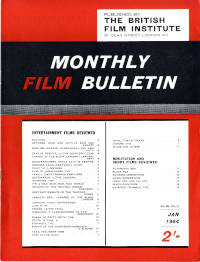

Publisher: The British Film Institute
Issue: Jan. 1964, Vol. 31, No. 360
Language: English
Country: UK
Content: A review. Spreading over a little more than just a column in the magazine, in black & white. The movie is reviewed by T.M..
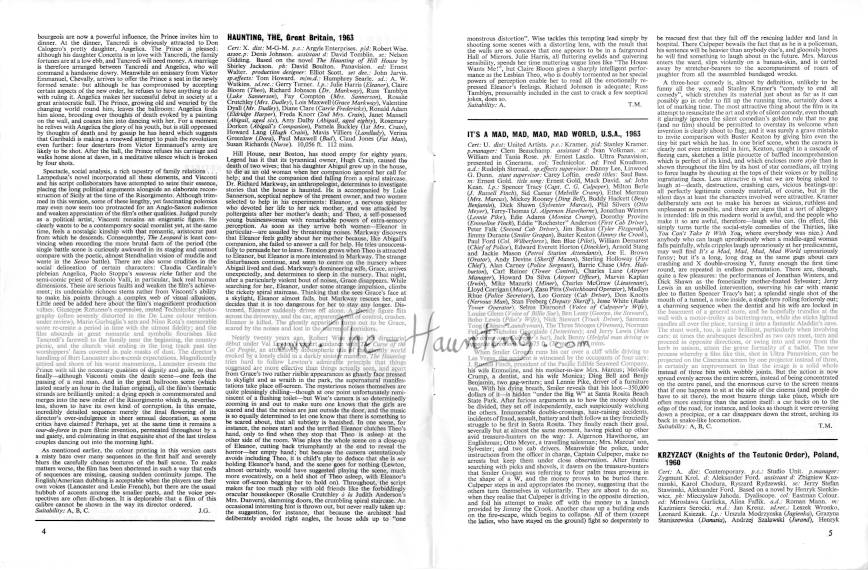
Page 4 to 5
Hill House, near Boston, has stood empty for eighty years. Legend has it that its tyrannical owner, Hugh Crain, caused the death of two wives; that his daughter Abigail grew up in the house, to die as an old woman when her companion ignored her call for help; and that the companion died falling from a spiral staircase. Dr. Richard Markway, an anthropologist, determines to investigate stories that the house is haunted. He is accompanied by Luke Sannerson, sceptical nephew of the present owner, and two women selected to help in his experiments: Eleanor, a nervous spinster who devoted her life to her sick mother, and was attacked by poltergeists after her mother's death; and Theo, a self-possessed young businesswoman with remarkable powers of extra-sensory perception. As soon as they arrive both women — Eleanor in particular — are assailed by threatening noises. Markway discovers that Eleanor feels guilty about her mother because, like Abigail's companion, she failed to answer a call for help. He tries unsuccessfully to persuade her to leave. Tension grows when Theo is attracted to Eleanor, but Eleanor is more interested in Markway. The strange disturbances continue, and seem to centre on the nursery where Abigail lived and died. Markway's domineering wife, Grace, arrives unexpectedly, and determines to sleep in the nursery. That night, after a particularly violent bout of noises, Grace disappears. While searching for her, Eleanor, under some strange impulsion, climbs the rickety spiral staircase. Thinking that she sees Grace's face at a skylight, Eleanor almost falls, but Markway rescues her, and decides that it is too dangerous for her to stay any longer. Distressed, Eleanor suddenly drives off alone. A ghostly figure flits across the driveway, and the car, apparently out of control, crashes. Eleanor is killed. The ghostly apparition turns out to be Grace, scared by the noises and lost in the warren of corridors.
Nearly twenty years ago, Robert Wise made his directorial debut under Val Lewton's expert guidance with The Curse of the Cat People, an attractively atmospheric tale of the ghostly world evoked by a lonely child in a darkly sinister mansion. The Haunting tries hard to follow Lewton's admirable principle that things suggested are more effective than things actually seen, and apart from Grace's two rather risible appearances as ghastly face pressed to skylight and as wraith in the park, the supernatural manifestations take place off-screen. The mysterious noises themselves are quite pleasingly chilling — though at one point unfortunately reminiscent of a flushing toilet — but Wise's camera is so determinedly zooming in and out to make sure one knows that the girls are scared and that the noises are just outside the door, and the music is so equally determined to let one know that there is something to be scared about, that all subtlety is banished. In one scene, for instance, the noises start and the terrified Eleanor clutches Theo's hand, only to find when they stop that Theo is asleep at the other side of the room. Wise plays the whole scene on a close-up of Eleanor, cutting back triumphantly at the end to reveal the horror — her empty hand; but because the camera ostentatiously avoids including Theo, it is child's play to deduce that she is not holding Eleanor's hand, and the scene goes for nothing (Lewton, almost certainly, would have suggested playing the scene, much more evocatively, on a held shot of Theo asleep, with Eleanor's voice off-screen begging her to hold on). Throughout, the script makes far too much play with old friends like the forbiddingly oracular housekeeper (Rosalie Crutchley à la Judith Anderson's Mrs. Danvers), slamming doors, the crumbling spiral staircase. An occasional interesting hint is thrown out, but never really taken up: the suggestion, for instance, that because the architect had deliberately avoided right angles, the house adds up to "one monstrous distortion". Wise tackles this tempting lead simply by shooting some scenes with a distorting lens, with the result that the walls are so concave that one appears to be in a fairground Hall of Mirrors. Julie Harris, all fluttering eyelids and quivering sensibility, spends her time muttering vague lines like "The House Wants Me!", but Claire Bloom gives a sharply intelligent performance as the Lesbian Theo, who is doubly tormented as her special powers of perception enable her to read all the emotionally repressed Eleanor's feelings. Richard Johnson is adequate; Russ Tamblyn, presumably included in the cast to crack a few sceptical jokes, does so.
'ABC Film Review' (UK)
Jan. 1964, Vol. 14, No. 1
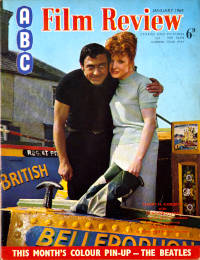

Issue: Jan. 1964, Vol. 14, No. 1
Language: English
Country: UK
Content: A full page advertisement for the movie, plus one double page, in black & white. The movie is reviewed by Elizabeth Hardie.

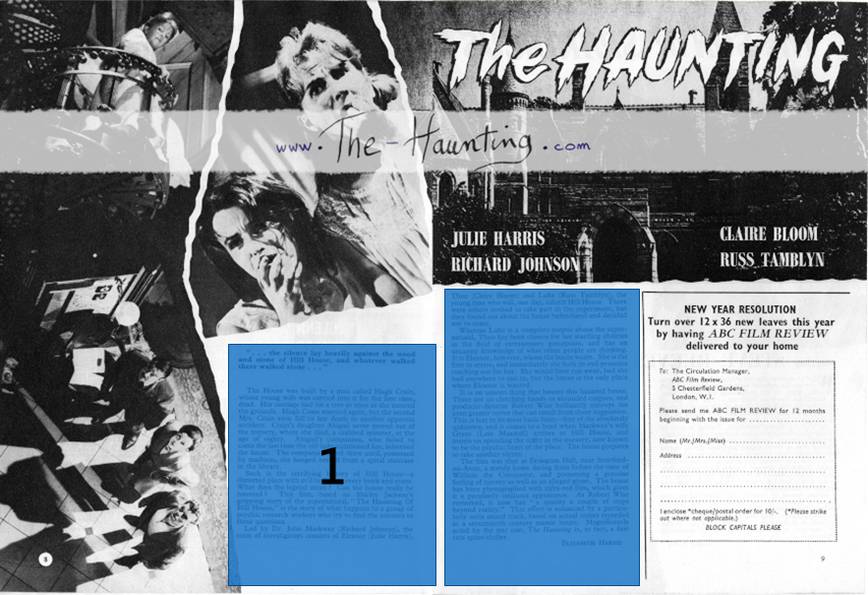
Page 8 to 9
The House was built by a man called Hugh Crain, whose young wife was carried into it for the first time, dead. Her carriage had hit a tree as soon as she entered the grounds. Hugh Crain married again, but the second Mrs. Crain soon fell to her death in another apparent accident. Crain's daughter Abigail never moved out of the nursery, where she died, a crabbed spinster, at the age of eighty. Abigail's companion, who failed to come the last time the old lady summoned her, inherited the house. The companion lived there until, possessed by madness, she hanged herself from a spiral staircase in the library.
Such is the terrifying history of Hill House — a distorted place with evil built into every brick and stone. What does the legend mean? Can the house really be haunted? This film, based on Shirley Jackson's gripping story of the supernatural, "The Haunting Of Hill House," is the story of what happens to a group of psychic research workers who try to find the answers to these questions.
Led by Dr. John Markway (Richard Johnson), the team of investigators consists of Eleanor (Julie Harris), Theo (Claire Bloom) and Luke (Russ Tamblyn), the young man who will, one day, inherit Hill House. There were others invited to take part in the experiment, but they found out about the house beforehand and decided not to come.
Whereas Luke is a complete sceptic about the supernatural, Theo has been chosen for her startling abilities in the field of extrasensory perception, and has an uncanny knowledge of what other people are thinking. It is Eleanor, however, whom the house wants. She is the first to arrive, and immediately she feels its evil presence reaching out for her. She would have run away, had she had anywhere to run to, but the house is the only place where Eleanor is wanted.
It is an unseen thing that haunts this haunted house. There are no clutching hands or shrouded corpses, and producer-director Robert Wise brilliantly conveys the even greater terror that can result from sheer suggestion. This is fear in its most basic form — fear of the absolutely unknown, and it comes to a head when Markway's wife Grace (Lois Maxwell) arrives at Hill House, and insists on spending the night in the nursery, now known to be the psychic heart of the place. The house prepares to take another victim...
The film was shot at Ettington Hall, near Stratford-on-Avon, a stately home dating from before the time of William the Conqueror, and possessing a genuine feeling of history as well as an alleged ghost. The house has been photographed with infra-red film, which gives it a peculiarly ominous appearance. As Robert Wise remarked, it now has "a quality a couple of steps beyond reality." This effect is enhanced by a particularly eerie sound track, based on actual noises recorded in a seventeenth century manor house. Magnificently acted by the star cast, The Haunting is, in fact, a first-rate spine-chiller.
'Cinéma 64' (France)
Apr. 1964, No. 85
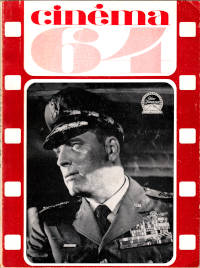

Issue: Apr. 1964, No. 85
Language: French
Country: France
Content: One page, in black & white. The movie is reviewed by Yves Boisset.
I can't show you the inside of the magazine without destroying the binding: it prevents from scanning the magazine flat.
Page 122 (Original French), excerpt:
L'une des plus désastreuses conséquences de la crise terrible que vient de traverser le cinéma américain fut la suspension presque radicale des productions de série B (westerns, thrillers, films d'action, films de guerre et films de terreur, pour l'essentiel) au profit de grosses machines prétentieuses, laborieusement fabriquées avec beaucoup de milliards et très peu d'idées. Le succès triomphal d'un film simplement intéressant comme Johnny Cool provient certainement en grande partie de cette nostalgie du public pour les séries B d'antan. Il semble pourtant que la production ait repris d'une façon normale à Hollywood, et il est assez significatif qu'un réalisateur aussi important que Robert Wise ait eu envie de traiter un genre mineur, comme le film de terreur, en réalisant La Maison du Diable.
Renouant avec un genre qu'il avait déjà traité avec brio à ses débuts dans des films comme Curse of the Cat People ou The Body Snatchers, Wise a visiblement voulu faire de The Haunting un film exemplaire. Un professeur de philosophie passionné de surnaturel a réuni dans une maison que l'on dit hantée deux jeunes femmes névrosées, qui furent déjà auparavant témoins de manifestations de l'au-delà, et le très jeune propriétaire de la maison, qui ne croit pas plus en le diable qu'en Dieu. Pourtant, dès l'arrivée des quatre volontaires dans la maison maudite, d'étranges manifestations se produisent : des coups sourds ébranlent les murs, des ricanements et des gémissements épouvantables retentissent dans les longs couloirs déserts, et des présences indicibles rôdent autour des deux femmes dès qu'elles se trouvent seules. La plus fragile d'entre elles trouvera la mort au cours d'un étrange accident, qui survient exactement à l'endroit où s'était tuée près d'un siècle auparavant la première propriétaire. Terrifiés, les trois survivants abandonneront leur dangereuse expérience et quitteront la maison qui gardera inviolés ses horribles secrets.
Avec un sujet de ce genre, l'équilibre est subtil et le choix difficile entre l'admission pure et simple des phénomènes surnaturels (Terence Fisher), et la justification logique d'événements tout à fait irrationnels (Castle ou tradition Val Lewton). Or le récit de Wise hésite constamment entre ces deux partis-pris. Et si certaines scènes constituent de véritables morceaux d'anthologie du cinéma fantastique (les premières manifestations surnaturelles dans la maison endormie, l'ascension de l'escalier en spirale), le manque de rigueur du scénario réduit considérablement l'adhésion du spectateur. D'autre part, les quatre personnages pour lesquels on est censé frissonner sont si peu attachants et si peu vraisemblables, que l'on se désintéresse assez vite de leur sort : Julie Harris est, en particulier, si exaspérante dans son emploi habituel de vierge mythomane et racornie que l'on se prend vite à espérer sa défloration immédiate par quelque audacieux succube. Seule, Claire Bloom, de plus en plus troublante depuis qu'elle travaille à Hollywood, impose avec beaucoup d'autorité son personnage de lesbienne névrosée en prise directe avec les manifestations de l'au-delà.
De toute évidence, Robert Wise est un très grand metteur en scène, sinon un auteur. Il y a dans son film des moments qui sont parmi les plus grands moments de l'histoire du cinéma fantastique. Mais il manque peut-être à ce film trop bien fait une vertu essentielle, c'est-à-dire au-delà des intentions dialectiques, le lyrisme de la sincérité.
Page 122 (English translation), excerpt:
One of the most disastrous consequences of the terrible crisis that American cinema has just gone through was the almost radical suspension of B-series productions (westerns, thrillers, action films, war films and terror films, for the most part) in favour of big pretentious machines, laboriously manufactured with many billions and very few ideas. The triumphant success of a simply interesting film like Johnny Cool certainly stems in large part from this nostalgia of audiences for the B-series of yesteryear. It seems, however, that production has resumed in a normal way in Hollywood, and it is quite significant that a director as important as Robert Wise wanted to deal with a minor genre, such as the terror film, by directing La Maison du Diable [The Haunting].
Returning to a genre that he had already dealt with brilliantly in his early days in films such as Curse of the Cat People or The Body Snatchers, Wise obviously wanted to make The Haunting an exemplary film. A philosophy professor with a passion for the supernatural has brought together two neurotic young women, who had already witnessed manifestations of the afterlife before, and the very young owner of the house, who believes no more in the devil than in God, in a house that is said to be haunted. However, as soon as the four volunteers arrive in the cursed house, strange manifestations occur: muffled blows shake the walls, appalling sneers and groans resound in the long deserted corridors, and unspeakable presences lurk around the two women as soon as they are alone. The most fragile of them will die in a strange accident, which occurs exactly where the first owner was killed almost a century ago. Terrified, the three survivors will abandon their dangerous experience and leave the house, which will keep its horrible secrets safe.
With a subject of this kind, the balance is subtle and the choice is difficult between outright admission of supernatural phenomena (Terence Fisher), and the logical justification of completely irrational events (Castle or the Val Lewton tradition). Yet Wise's narrative is constantly wavering between these two sides. And while some scenes are veritable pieces of fantasy cinema anthology (the first supernatural manifestations in the sleeping house, the ascent of the spiral staircase), the lack of rigour in the script considerably reduces the viewer's adherence. On the other hand, the four characters for whom one is supposed to shudder are so unlovable and unlikely that one quickly loses interest in their fate: Julie Harris, in particular, is so exasperating in her usual job as a shrivelled, mythomaniacal virgin that one quickly begins to hope for her immediate defloration by some daring succubus. Alone, Claire Bloom, more and more disturbing since she has been working in Hollywood, imposes with great authority her character of neurotic lesbian in direct contact with the manifestations of the afterlife.
Clearly, Robert Wise is a very great director, if not an author. There are moments in his film that are among the greatest moments in the history of fantasy cinema. But perhaps this film, too well made, lacks an essential virtue, that is to say, beyond dialectical intentions, the lyricism of sincerity.
'Midi-Minuit Fantastique' (France)
Jul. 1964, No. 9
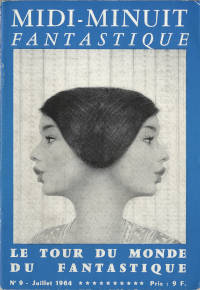

Issue: Jul. 1964, No. 9
Language: French
Country: France
Content: Three pages, in black & white, with French artwork. The movie is reviewed by Michel Caen.
I can't show you the inside of the magazine without destroying the binding: it prevents from scanning the magazine flat.
Page 116 to 118 (Original French), excerpt:
La renommée de Wise, pourtant confirmée par le succès de "West Side Story", et la grande mode que connaissent actuellement les esprits frappeurs et la parapsychologie n'empêchèrent pas "La Maison du Diable" d'effectuer une sortie peu remarquée, pour le moins, et de connaître une exclusivité très brève, rivalisant ainsi avec "La Chute de la Maison Usher" qui, malgré sa récente reprise au Studio Parnasse, fut victime d'une exploitation particulièrement peu efficace.
Malgré les apparences, "The Haunting" ne met en scène ni un véritable cas de maison hantée — au sens traditionnel du terme — ni une de ces escroqueries destinées à effrayer d'éventuels locataires comme le cinéma nous en proposa souvent, puisque même l'admirable "Mark Of The Vampire" se soumettait à ces conventions rationalistes. Hill House, sinistre demeure de la Nouvelle Angleterre possède une réputation peu enviable. Depuis près de cent ans la "malédiction" pèse sur cette horrible bâtisse dont l'aspect seul évoque la mort et la lente décomposition. La femme pour qui cette maison fut construite, ne l'habitat jamais et, dans le parc, un arbre géant conserve encore une troublante cicatrice, vestige de l'accident qui causa la mort de la jeune épouse. Depuis les morts se sont succédées, toutes insolites sinon suspectes et la légende locale assure que les "victimes" continuent à peupler Hill House. Jusque-là, si j'ose dire, rien que de très naturel. L'affaire se complique lorsque le Dr. Markway, anthropologiste éminent et psychologue de surcroît, décide de louer la maison pour l'été afin de s'y livrer à quelques expériences que ne renieraient pas Rhine et ses collègues. Il s'entoure de médiums — au sens étymologique — c'est-à-dire d'êtres Hypersensibles ou en pleine crise de mutation organique ou psychique qui doivent permettre aux phénomènes surnaturels de se manifester. Le Dr. Markway fait preuve d'une remarquable honnêteté scientifique puisqu'il se borne ici à enregistrer, sans aucune interprétation, l'occurrence et la fréquence des manifestations inexpliquées.
Dans "La Maison du Diable" nous ne connaitrons jamais l’explication ultime. Les phénomènes qui furent indubitablement enregistrés resteront inaccessibles à toute appréhension rationnelle. Il ne s'agit pas, bien sûr, de fantômes élégamment vêtus de suaires immaculés mais simplement de bruits inexplicables, d'objets déplacés sans cause apparente et surtout de l'impression résolument atroce que la Maison désire garder en elle une présence vivante. En l'occurrence l'hypersensible Eleanor, désespérément attirée par cette extraordinaire demeure où les hautes fenêtres semblent autant d'orbites vides, de regards morts fascinants leur proie comme certains octopodes, dit-on, hypnotisent leurs victimes.
L'autre femme, Théodora, ravissante brune apparemment aussi clairvoyante et télépathe que fidèle au culte de Sapho se laissera finalement gagner par la terreur panique d'Eleanor. Le cinéma nous offre alors une des plus pures séquences d'épouvante lorsque les deux femmes réfugiées sur le même lit entendent la maison résonner de gigantesques coups de boutoirs et voient la porte de leur chambre ployer, se gonfler, se distendre littéralement sous la pression monstrueuse de la force qui erre dans le couloir, que nous ne verrons jamais et qui nous attire comme un vertige mortel. Théodora a-t-elle suggéré ce cauchemar à sa compagne, celle-ci lui a-t-elle communiqué ses terreurs ? Wise ne donne pas de réponse. Eleanor d'ailleurs désire ardemment que "quelque chose lui arrive". Elle souhaite être capturée, assimilée par la maison tentaculaire, sorte de monstrueuse Antinéa évocatrice de syncrétisme utérin, labyrinthe où il n'existe pas d'angles droits, incompréhensible volume de Klein dans lequel nous errons et qui catalyse pour nos sens d'improbables rencontres.
La maîtrise de Robert Wise réussit à traduire efficacement — et c'est là le but — ce fascinant et lucide cauchemar et fait de "The Haunting" un des plus modernes films de terreur. Les dernières images montrent Hill House après sa victoire refermée sur elle-même, immobile mais vivante Hill House veille. De nouvelles proies, de nouveaux otages ou peut-être de nouveaux élus ?
Page 116 to 118 (English translation), excerpt:
The fame of Wise, however confirmed by the success of "West Side Story", and the great fashion that striking spirits and parapsychology know nowadays, did not prevent "La Maison du Diable" [The Haunting] from making a little noticed release, to say the least, and to know a very brief exclusiveness, thus competing with "La Chute de la Maison Usher/The Fall of the House of Usher" which, in spite of its recent revival at the Studio Parnasse, was victim of a particularly inefficient exploitation.
Despite appearances, "The Haunting" is neither a real haunted house case — in the traditional sense of the word — nor one of those scams designed to scare off potential tenants as the cinema often suggested, since even the admirable "Mark Of The Vampire" submitted to these rationalist conventions. Hill House, a sinister New England home, has an unenviable reputation. For nearly a hundred years the "curse" has weighed on this horrible building, whose very appearance evokes death and slow decay. The woman for whom this house was built never lived in it and, in the park, a giant tree still bears a disturbing scar, a remnant of the accident that caused the young wife's death. Since then there has been a succession of deaths, all unusual if not suspicious, and local legend assures that the "victims" continue to populate Hill House. So far, if I dare say so, nothing but the most natural thing. The matter became more complicated when Dr. Markway, an eminent anthropologist and psychologist, decided to rent the house for the summer in order to carry out some experiments that Rhine and his colleagues would not deny. He surrounds himself with mediums — in the etymological sense of the word — that is to say, hypersensitive beings or beings in the midst of an organic or psychic mutation crisis who must allow supernatural phenomena to manifest themselves. Dr. Markway shows remarkable scientific honesty since he limits himself here to recording, without any interpretation, the occurrence and frequency of unexplained manifestations.
In "La Maison du Diable" [The Haunting] we will never know the ultimate explanation. The phenomena that were undoubtedly recorded will remain inaccessible to any rational apprehension. They are not, of course, ghosts elegantly dressed in immaculate shrouds, but simply inexplicable noises, objects moved without apparent cause and above all the resolutely atrocious impression that the House wishes to keep a living presence in it. In this case, the hypersensitive Eleanor, desperately attracted by this extraordinary residence where the high windows seem as many empty orbits, fascinating dead eyes their prey as some octopods, it is said, hypnotize their victims.
The other woman, Theodora, a beautiful brunette apparently as clairvoyant and telepathic as she is faithful to the cult of Sapho, will finally let herself be overcome by Eleanor's panicky terror. The cinema then offers us one of the purest sequences of horror when the two women taking refuge on the same bed hear the house resounding with gigantic knocks from the door of their room bending, swelling, literally distending under the monstrous pressure of the force wandering in the corridor, which we will never see and which attracts us like a deadly vertigo. Did Theodora suggest this nightmare to her companion, did the latter communicate her terrors to her? Wise gives no answer. Eleanor, moreover, longs for "something to happen to her". She wishes to be captured, assimilated by the sprawling house, a sort of monstrous Antinea evocative of uterine syncretism, a labyrinth where there are no right angles, an incomprehensible volume of Klein in which we wander and which catalyses for our senses improbable encounters.
Robert Wise's mastery succeeds in effectively translating — and this is the goal — this fascinating and lucid nightmare and makes "The Haunting" one of the most modern terror films. The last images show Hill House after its victory closed in on itself, motionless but alive Hill House stands vigil. New prey, new hostages or perhaps new chosen ones?
'Ecran 72' (France)
Feb. 1972, No. 2
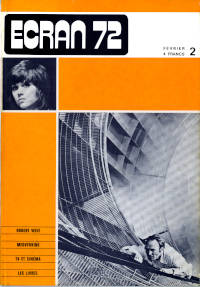

Issue: Feb. 1972, No. 2
Language: French
Country: France
Content: A very comprehensive 20-page thematic dossier on Robert Wise, with many photos. Half a page, in black & white, is dedicated to The Haunting, with a commentary (interview) by Robert Wise about the film.
I can't show you the inside of the magazine without destroying the binding: it prevents from scanning the magazine flat.
Page 30 (Original French), excerpt:
Deux choses m'ont particulièrement intéressées dans la réalisation de "La maison du diable" : le développement des rapports d'amitié assez étranges et troubles entre Claire Bloom et Julie Harris — au spectateur de tirer ses propres conclusions — et l'utilisation de la bande-son comme élément dramatique du film. A aucun moment je ne montre un fantôme ou un esprit. Rien n'est matérialisé. Tout est dans l'imagination des personnages et dans la bande-son. Normalement, quand on tourne une scène, on indique oralement aux acteurs le type de son qu'on entendra dans la version finale. Et bien, pendant le tournage de "La maison du diable", pendant que l'on tournait je faisais passer le morceau de bande-son correspondant à la scène de la prise. J'ai toujours considéré le son comme un élément dramatique de première importance mais je n'avais jamais eu la possibilité de l'utiliser à fond comme je l'ai fait dans ce cas précis.
Page 30 (English translation), excerpt:
Two things particularly interested me in the making of "The Haunting": the development of the rather strange and troubled friendship between Claire Bloom and Julie Harris — it is up to the viewer to draw their own conclusions — and the use of the soundtrack as a dramatic element in the film. At no point do I show a ghost or a spirit. Nothing is materialized. It's all in the imagination of the characters and in the soundtrack. Normally, when you shoot a scene, you tell the actors verbally what kind of sound you will hear in the final version. Well, during the shooting of "The Haunting", while we were shooting, I played the soundtrack piece corresponding to the scene of the take. I've always considered sound to be a very important dramatic element, but I've never had the opportunity to use it to the fullest as I did in this case.
'Cinema' (France)
Feb. 1978, No. 201
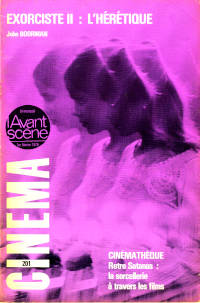

Issue: Feb. 1978, No. 201
Language: French
Country: France
Content: A thematic dossier: Retro Satanas! Witchcraft through films. Two pages, in black & white, refer to The Haunting .
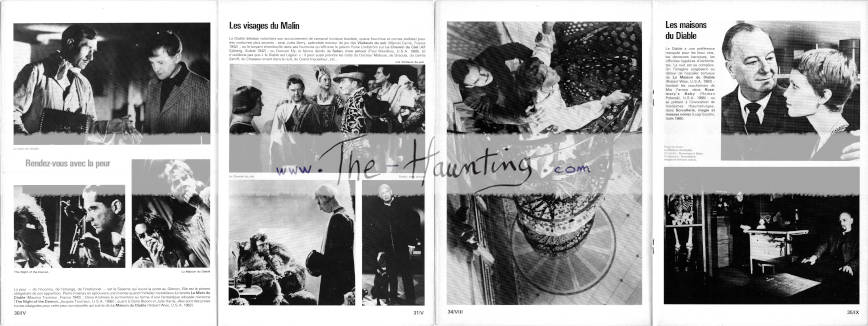
Page 30 and 34 (Original French), excerpt:
La peur — de l'inconnu, de l'étrange, de l'irrationnel — est le sésame qui ouvre la porte au Démon. Elle est le piment obligatoire de son apparition. Pierre Fresnay en éprouvera une intense quand l'hôtelier mystérieux lui tendra La Main du Diable (Maurice Tourneur, France 1942) ; Dana Andrews la surmontera au terme d'une fantastique odyssée nocturne (The Night of the Demon, Jacques Tourneur, U.S.A. 1958) ; quant à Claire Bloom et Julie Harris, elles sont des proies toutes désignées pour cette peur surnaturelle qui suinte de La Maison du Diable (Robert Wise, U.S.A. 1963).
Le Diable a une préférence marquée pour les lieux clos, les demeures baroques, les officines lugubres d'alchimistes. La nuit est sa complice. On l'imagine surgissant au détour de l'escalier tortueux de La Maison du Diable (Robert Wise, U.S.A. 1963) ; hantant les cauchemars de Mia Farrow dans Rosemary's Baby (Roman Polanski, U.S.A. 1968) ; ou se prêtant à l'invocation de modernes thaumaturges, dans Sorcellerie, magie et messes noires (Luigi Scatini, Italie 1969).
Page 30 and 34 (English translation), excerpt:
Fear — of the unknown, of the strange, of the irrational — is the sesame that opens the door to the Devil. It is the obligatory spice of its appearance. Pierre Fresnay will experience an intense one when the mysterious hotelier offers him La Main du Diable [Carnival of Sinners] (Maurice Tourneur, France 1942); Dana Andrews will overcome it at the end of a fantastic nocturnal odyssey (The Night of the Demon, Jacques Tourneur, U.S.A. 1958); as for Claire Bloom and Julie Harris, they are all prey to this supernatural fear that oozes from La Maison du Diable [The Haunting] (Robert Wise, U.S.A. 1963).
The Devil has a marked preference for enclosed spaces, baroque dwellings, the gloomy alchemists' dispensaries. The night is his accomplice. We imagine him appearing at the bend in the winding staircase of La Maison du Diable [The Haunting] (Robert Wise, U.S.A. 1963); haunting the nightmares of Mia Farrow in Rosemary's Baby (Roman Polanski, U.S.A. 1968); or lending himself to the invocation of modern miracle-workers, in Sorcery, Magic and Black Masses [Witchcraft '70] (Luigi Scatini, Italy 1969).
'Fantastic Films' (USA & UK)
USA, Sep. 1979, #10, Vol. 2, No. 4
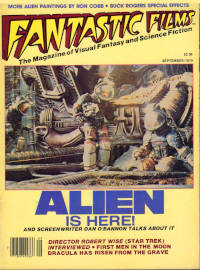

Issue: Sep. 1979, #10, Vol. 2, No. 4
Language: English
Country: USA
Content: Eleven full pages, in black & white, including numerous pictures. They feature a Robert Wise interview and an article by James Delson titled "A comprehensive interview with: Robert Wise."
UK, Sep. 1979, #1
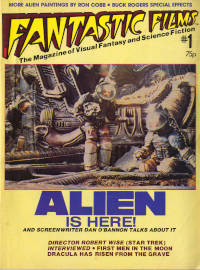

Issue: Sep. 1979, #1
Language: English
Country: UK
Content: Eleven full pages, in black & white, including numerous pictures. They feature a Robert Wise interview and an article by James Delson titled "A comprehensive interview with: Robert Wise."
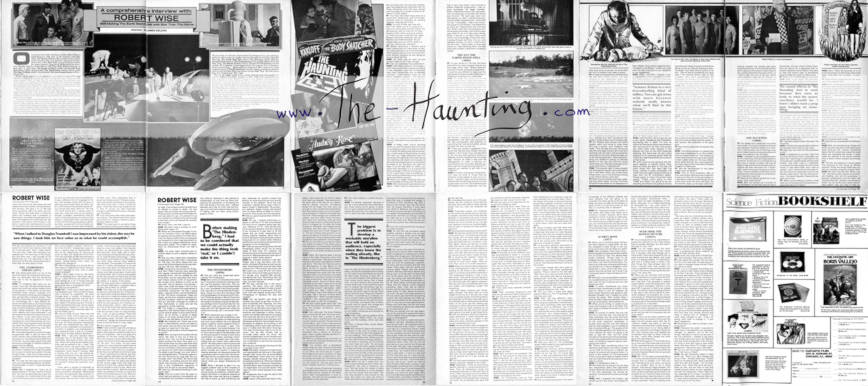
Page 23 & 38, very short excerpt:
Fantastic Films: You began your career as a sound effects cutter. As a result, the sound element has played an important part in your films. This is particularly true in "The Haunting", which relied heavily on its sound effects to draw the audience into the story.
Robert Wise: I decided to use a playback system on "The Haunting", the same type of system a director would use on a musical during the song or dance numbers. We had all these things that the actors had to react to, outside the door and what not. I knew I didn't want a prop man banging on something. The sound effects really had to work because they were so basic to what the actors' reactions would be.
Fantastic Films: Were all the effects worked out in advance, story-board style?
Robert Wise: Well, we worked up a number of sound effects, not the final ones we had in the picture, but very close to them. Every time we had to do a sequence that required a specific sound effect, I was able to have the actors react to something close to what you heard on the screen.
Fantastic Films: What sort of effects did you develop?
Robert Wise: Well, if you recall "The Haunting", there were no door creaks or hollow echoing footsteps. We had something outside. The ghosts, the real inhabitants of Hill House, were outside the door, so we had to create something. We made all the sounds. We made them specifically. We hired a special sound effects man, and he made the ones we used on playback during shooting. He came back afterwards and used some of those and added others. Some of the sounds were taken out of sound effects libraries, but he created the noises that chilled you.
Fantastic Films: I had bad dreams when I first saw "The Haunting".
Robert Wise: I've had some people tell me that it is the scariest movie they've ever seen.
Fantastic Films: Have you ever been terribly scared by a film?
Robert Wise: It happened to me after I saw The Cat and the Canary when I was about ten years old. I was living in a little town in the mid-west and I used to sleep with my older brother. The night I saw it, I remember running all the way home from the movie house. It was about 9:00, and I was so scared, I got in bed and just shivered under the covers for about two hours 'til my brother came home. The Cat and the Canary — I've never forgotten. Scared the bejesus out of me.
Fantastic Films: When you're making a chiller is that what you're trying to do to the audience—scare the hell out of them?
Robert Wise: Sure. That's the purpose of it, to scare the people on the screen and at the same time scare the audience, it is twofold.
Fantastic Films: What effects created for the film were you most pleased with?
Robert Wise: Well, I remember the shot where the girls are in bed. It's the first time they hear it, and the sound is kind of like a sniffing outside the door—all around the door. The feeling's like, "If there's a little crack, I can get in." I loved that. It was hand-made for the film.
Fantastic Films: When you're designing a film about a house being evil as opposed to a flesh and blood character or a moving object like an automobile, what do you look for and how do you use it?
Robert Wise: We wanted a house that basically had an evil look about it. Since the film was going to be shot in England, we looked far and wide to find the right house. There are a lot of manor houses and old places in England, but one after the other did not fit our requirements. Finally, we found one about ten miles down from Stratford-on-Avon. It was an old manor house, about two hundred years old, and it was being used as a country hotel.
Fantastic Films: What distinguished it?
Robert Wise: It had a facing of mottled stone with gothic windows and turrets.
Fantastic Films: How did you accentuate the feeling of evil?
Robert Wise: Well, we were shooting in black and white, so when we shot in the daytime, we used infra-red film. There's something about that film stock that makes the skies black and highlights the clouds. It really made the texture of the house exterior kind of awful, which worked enormously well.
Fantastic Films: The film was based on a novel called "The Haunting of Hill House" by Shirley Jackson. Since the house itself was evil, did you consider using the original title?
Robert Wise: We didn't like that title. When I say "we," that particularly means me and Nelson Gidding, who did the screenplay. It seemed cumbersome and the book had not done that well. Jackson is a marvelous writer, but her books were never tremendous sellers, they got most of their acclaim from the critics. We always felt that maybe there was a better title somewhere, and actually, she gave it to us. We had some questions about the story and her intent. Since she lived back in Vermont where her husband was a professor at Bennington, we made arrangements to fly back one weekend and meet with her. We wanted to talk about some things in her story, to get some clarifications on what her intentions were. We had lunch with her that day and during the course of it we asked her if she'd ever had any other title for it, and she said, "Well, I really hadn't. The only title I really ever seriously considered was "The Haunting of Hill House". But the other one I had thought of for a while was just "The Haunting". It was in front of us all the time, but we never saw it. She's the one who gave us that.
'Mad Movies' (France)
Jan. 1984, No. 29
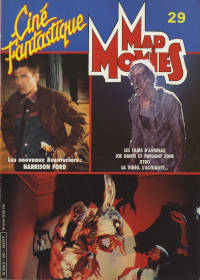

Issue: Jan. 1984, No. 29
Language: French
Country: France
Content: Three quarters of a page, in black & white, with picture. The movie is reviewed by Denis Tréhin.
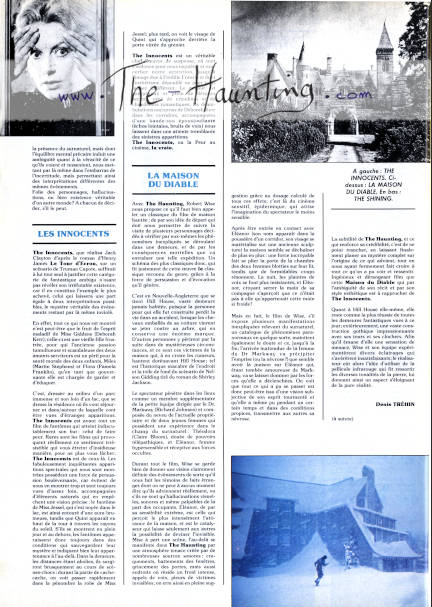
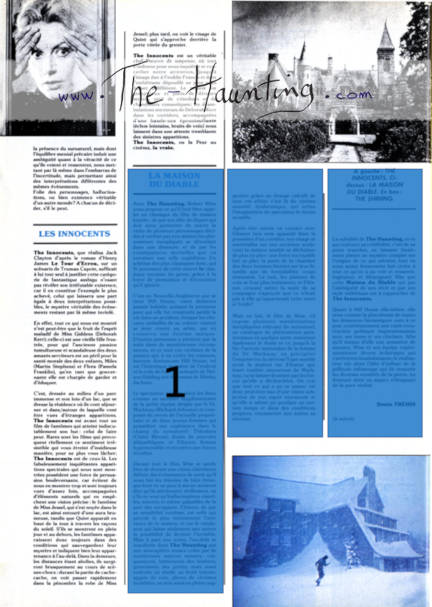
Page 56 (Original French)
Avec The Haunting, Robert Wise nous propose ce qu'il faut bien appeler un classique du film de maison hantée : de par son idée de départ qui doit nous permettre de suivre la visite de plusieurs personnages décidés à vérifier par eux-mêmes les phénomènes inexpliqués se déroulant dans une demeure, et de par les conséquences mortelles que va entraîner une telle expédition. Un schéma des plus classiques donc, qui fit justement de cette oeuvre le classique reconnu du genre, grâce à la force de persuasion et d'évocation qu'il génère.
C'est en Nouvelle-Angleterre que se tient Hill House, vaste demeure jamais habitée, puisque la personne pour qui elle fut construite perdit la vie dans un accident, lorsque les chevaux emballés de sa voiture vinrent se jeter contre un arbre, qui en conserva une énorme marque. D'autres personnes y périrent par la suite dans de mystérieuses circonstances, et ce sont ces victimes de la maison qui, à en croire les rumeurs, hantent dorénavant Hill House ; tel est l'historique macabre de l'endroit et la toile de fond du scénario de Nelson Gidding tiré du roman de Shirley Jackson.
Le spectateur pénètre dans les lieux comme un membre supplémentaire de la petite équipe dirigée par le Dr. Markway (Richard Johnson) et composée du neveu de l'actuelle propriétaire et de deux jeunes femmes qui possèdent une expérience dans le champ du surnaturel : Théodora (Claire Bloom), douée de pouvoirs télépathiques, et Eléanor (Julie Harris), femme hypersensible et réceptive aux forces occultes.
Durant tout le film, Wise se garde bien de donner une vision clairement définie des événements de sorte qu'il nous fait les témoins de faits étranges dont on ne peut à aucun moment dire qu'ils adviennent réellement, ou s'ils ne sont qu'hallucinations visuelles, sonores et même palpables de la part des occupants. Eléanor, de par sa sensibilité extrême, est celle qui perçoit le plus intensément l'attirance de la maison, et est le catalyseur qui laisse seulement aux autres la possibilité de deviner l'invisible. Mise à part une scène, l'au-delà se manifeste dans The Haunting par une atmosphère tenace créée par de nombreuses sources sonores : craquements, battements des fenêtres, grincement des portes, mais aussi endroits où réside un froid intense, appels de voix, pleurs de victimes invisibles ; on erre ainsi en pleine suggestion grâce au dosage calculé de tous ces effets ; c'est là du cinéma sensitif, épidermique, qui attise l'imagination du spectateur le moins sensible.
Après être entrée en contact avec Eléanor (son nom apparaît dans la poussière d'un corridor, son visage se matérialise sur une ancienne sculpture) la maison semble se déchaîner de plus en plus : une force incroyable fait se plier la porte de la chambre des deux femmes blotties sur leur lit, tandis que de formidables coups résonnent. La nuit, les plaintes de voix se font plus insistantes, et Eléanor, croyant serrer la main de sa compagne s'aperçoit que ce n'était pas à elle qu'appartenait cette main si froide !
Mais en fait, le film de Wise, s'il expose plusieurs manifestations inexpliquées relevant du surnaturel, un catalogue de phénomènes paranormaux en quelque sorte, maintient également le doute et ce, jusqu'à la fin ; l'arrivée inattendue de la femme du Dr. Markway va précipiter l'emprise (ou la névrose ?) que semble avoir la maison sur Eléanor qui, étant tombée amoureuse de Markway, va se laisser dominer par les forces qu'elle a déclenchées. On voit que tout ce qui a pu se passer est donc peut-être issu d'une vision subjective de son esprit tourmenté et qu'elle a même pu pendant un certain temps et dans des conditions propices, transmettre aux autres sa névrose.
La subtilité de The Haunting, et ce qui renforce sa crédibilité, c'est de ne point trancher, en laissant finalement planer un mystère complet sur l'origine de ce qui advient, tout en nous ayant fermement fait croire à tout ce qu'on a pu voir et ressentir. Ingénieux et dérangeant film que cette Maison du Diable qui par l'ambiguïté de son récit et par son style esthétique est à rapprocher de The Innocents.
Quant à Hill House elle-même, elle reste comme la plus réussie de toutes les demeures fantastiques vues à ce jour ; extérieurement, une vaste construction gothique impressionnante avec ses tours et ses clochers. Afin qu'il émane d'elle une sensation de menace, Wise et son équipe expérimentèrent divers éclairages qui s'avérèrent insatisfaisants ; le réalisateur eût alors l'idée d'utiliser de la pellicule infrarouge qui fit ressortir les diverses tonalités de la pierre, lui donnant ainsi un aspect s'éloignant de la pure réalité.
Page 56 (English translation)
With The Haunting, Robert Wise offers us what must be called a classic haunted house film: because of his initial idea, which should allow us to follow the visit of several characters determined to verify by themselves the unexplained phenomena taking place in a house, and because of the deadly consequences that such an expedition will entail. This is one of the most classical schemes, which has made this work the recognised classic of the genre, thanks to the persuasive and evocative power it generates.
Hill House is located in New England. It is a vast house never inhabited, since the person for whom it was built lost his life in an accident when the horses wrapped up in his carriage came to throw themselves against a tree, which left a huge mark on it. Other people later died there in mysterious circumstances, and it is these victims of the house who, rumour has it, now haunt Hill House; this is the macabre history of the place and the backdrop to Nelson Gidding's screenplay from Shirley Jackson's novel.
The spectator enters the premises as an additional member of the small team led by Dr. Markway (Richard Johnson) and composed of the current owner's nephew and two young women with experience in the field of the supernatural: Theodora (Claire Bloom), endowed with telepathic powers, and Eleanor (Julie Harris), a hypersensitive woman who is receptive to occult forces.
Throughout the film, Wise is careful not to give a clearly defined vision of the events so that he makes us witness strange facts that can never be said to actually happen, or if they are only visual, sound and even palpable hallucinations on the part of the occupants. Eleanor, because of her extreme sensitivity, is the one who perceives most intensely the attraction of the house, and is the catalyst that leaves only others the possibility of guessing the invisible. Apart from one scene, the afterlife manifests itself in The Haunting through a tenacious atmosphere created by numerous sound sources: creaking, slamming windows, squeaking doors, but also places where intense cold resides, calls of voices, cries of invisible victims; one wanders thus in full suggestion thanks to the calculated dosage of all these effects; this is sensitive, epidermal cinema, which stirs the imagination of the least sensitive spectator.
After coming into contact with Eleanor (her name appears in the dust of a corridor, her face materialises on an old sculpture) the house seems to go wilder and wilder: an incredible force makes the door of the two women's room bend open, huddled on their bed, while formidable blows resound. At night, the complaints of voices become more insistent, and Eleanor, believing she is shaking hands with her companion, realizes that it was not her who owned this cold hand!
But in fact, Wise's film, while exposing several unexplained manifestations of the supernatural, a catalogue of paranormal phenomena of sorts, also maintains doubt right up to the end; the unexpected arrival of Dr. Markway's wife will precipitate the hold (or neurosis?) that the house seems to have on Eleanor who, having fallen in love with Markway, will let herself be dominated by the forces she has unleashed. We can see that everything that may have happened may have been the result of a subjective vision of her tormented mind and that she was even able, for a certain time and under favourable conditions, to transmit her neurosis to others.
The subtlety of The Haunting, and what reinforces its credibility, is that it doesn't make any statement, finally leaving a complete mystery as to the origin of what happens, while at the same time having made us firmly believe in everything we have seen and felt. An ingenious and disturbing film, this Maison du Diable, which by the ambiguity of its narrative and its aesthetic style is to be compared to The Innocents.
As for Hill House itself, it remains as the most successful of all the fantastic residences seen to date; externally, a vast and impressive Gothic building with its towers and bell towers. In order to create a sense of threat, Wise and his team experimented with various lighting techniques which proved unsatisfactory, and the director had the idea of using infrared film which brought out the various tones of the stone, giving it an appearance far removed from pure reality.
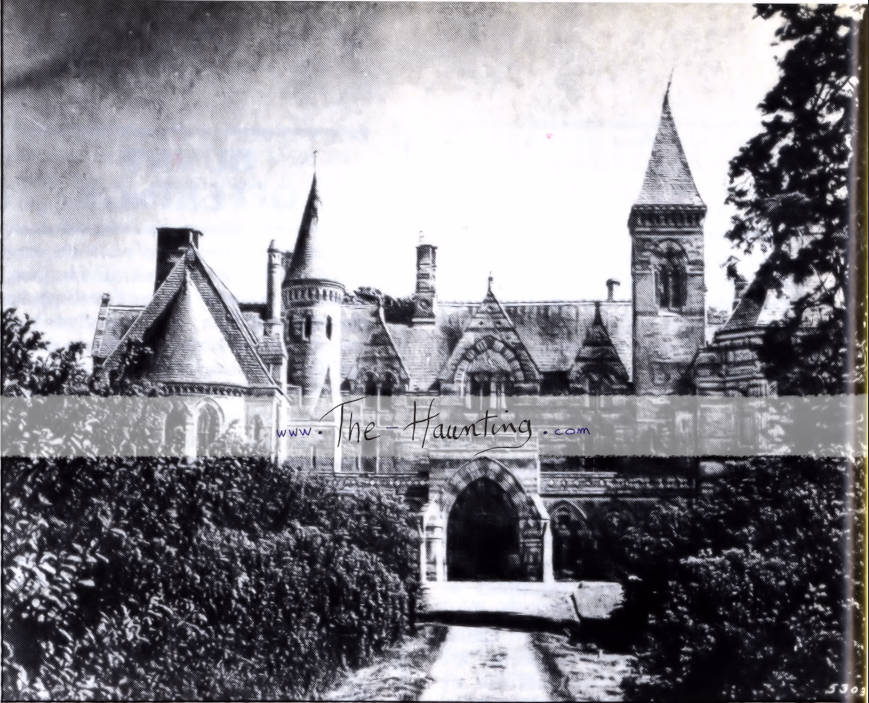
Connoisseurs will notice that this is a really nice promotional picture. The surroundings of the house changed a lot since this picture was taken.
'Fangoria' (USA)
May 1982, #19
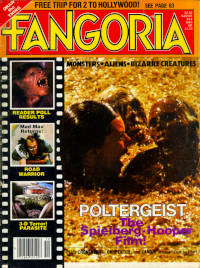

Issue: May 1982, #19
Language: English
Country: USA
Content: Five full pages, in black & white, including numerous pictures. They feature a Robert Wise interview and an article by Al Taylor, Doug Finch and Bruce Benderson titled "Val Lewton's Cats"

Page 40, very short excerpt:
Fang: What would you consider the Lewton formula for building a horror?
Wise: One of the greatest things that Lewton played on, or tried to play on in most of his films, was people's fear of the unknown. He felt that this was the greatest fear that we have. If we don't know about something, we have concern and fear. He played on that and worked toward building everything he could towards a response to the fear of the unknown.
And of course, he would want to time how effects would go. He was very careful about his continuity, how he built the scenes, how he built the continuity of the piece, to be sure there were not too many long passages without something happening. Something to get the audience, something to make them react, something to bring them uptight.
Fang: Who would you consider your mentors in the early RKO days?
Wise: T.K. Wood, the sound effects editor, who not only taught me about sound effects editing, but about life in the studio and life generally- He was a lovely, quiet, fun man.
Another was Billy Hamilton, the editor I started with. Billy was absolutely marvelous to me. He taught me as much as I know about editing. He was a master editor himself.
Of course, Orson Welles was a mentor too—a tremendous talent. The experience of working with him was quite unusual, quite stimulating, quite exciting, quite maddening. But overall, just tremendous.
There was also Richard Wallace. He was a very lovely man and a good director in those days. I can't give you a list of all the films he did. Most of them kind of middle ground pictures—no great world-renowned titles that you would remember. But a good, more than competent director and a lovely man.
Of course, my greatest mentor was Val Lewton, my first producer. Val taught me so much about filmmaking; about the importance of detail, the tempo of the script, writing—just everything; care, attention and love given to all aspects of the film. I shall always be thankful to him.
May 1985, #44
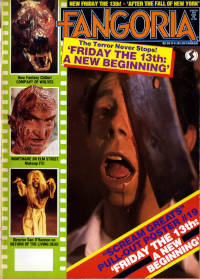

Issue: May 1985, #44
Language: English
Country: USA
Content: Five full pages, in black & white, including numerous pictures. They feature a Robert Wise interview and an article by John Gallagher titled "Wise Fantastica - Tutored in horror and fantasy by the great Val Lewton, successful mainstream director Robert Wise has often returned to his fantastic film roots."

Page 60, very short excerpt:
Fangoria: You were very influenced by the Lewton thrillers when you directed "The Haunting" 20 years later.
Robert Wise: I'd loved doing those films with Lewton, and learned much from him, and one of the reasons I got caught up in wanting to do "The Haunting" was the need to return to that kind of film. I hadn't made one since the Lewton days, so that was one of the drives I had in doing "The Haunting", to get my hand into that kind of thriller show that I had started my directing career on. Lewton's thesis was, "The greatest fear is the fear of the unknown." I think that's something that generates all through our lives. We also wonder whether or not we hear a noise. Did I hear that? Is there something outside the door? What's that across the street? Did I see something moving in the shadows? Not that we're all going around with our hearts pumping, being afraid, but deep down inside, dating back to earlier days centuries ago, we all have this concern and this fear about things that we really can't see and can't identify from sound. We just don't know.
Fangoria: One of "The Haunting"'s most effective scenes features the unseen horror of Julie Harris in the darkness, thinking that she's holding Claire Bloom's hand. When the lights come on, she realizes otherwise.
Robert Wise: That worked well, didn't it? That was a challenge to do, because as described in the book, how do you make that separation? I think it worked very well.
Fangoria: The lesbian undertone in Claire Bloom's character was very daring for 1963.
Robert Wise: People have picked up on that so much. Again, it's very subtle, and yet it's there. Many people have felt that Bloom has never been better.
Fangoria: What was the background for getting "The Haunting" on the screen?
Robert Wise: It was typical of what we call in Hollywood a "runaway production." There used to be more of them. I developed the script and took it to MGM. They liked it but they didn't want to put over a million dollars into it because of the material, and the fact that we wouldn't be going for big names. We're going back 20 years, so a million dollars was a good-sized film then, we're not talking about today's inflation. I happened to be going to London for a command performance of West Side Story after we had put this thing to work, and somebody there saw the script. They said, "Listen, MGM has a studio here." At that time MGM owned Borehamwood Studios, a nice little studio outside of London. They came up with a budget in London, same film, same stars, same above-the-line, for about a million and 50 thousand. The studio went for it so that's why we wound up making it in England, strictly for economics. But ... I was insistent on keeping the New England background because Shirley Jackson is a New Englander and wrote in that area. I felt that this kind of story, with an old haunted house, would be fresher material set in America, in New England, than it would in Great Britain, because England abounds in haunted houses. Even though we shot in London, we kept the New England setting without too much trouble.
July 1987, #65
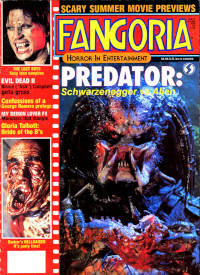

Issue: July 1987, #65
Language: English
Country: USA
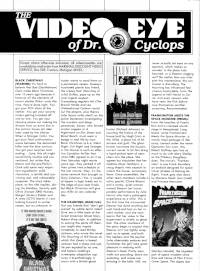
Page 18, review by Dr. Cyclops:
THE HAUNTING (MGM/UA): Got any friends that "don't get scared" by subtle terror tales? Give 'em a little taste of the Great American Ghost Story, Robert Wise-style. In addition to scaring the pants off them, you might also inspire somebody to read Shirley Jackson, who wrote the novel The Haunting of Hill House on which this classic is based. Jackson had a sharp and subtle pen equaled by no one, and Nelson Gidding's screenplay adaptation captures it breathtakingly. It starts with a British ghost hunter (Richard Johnson) recounting the history of the house built by Hugh Crain in the 1870s. A place full of bitterness and guilt. The ghost hunter convinces the house's current owner to let him bring a hand-picked team of searchers into the place. She agrees but stipulates that her nephew (Russ Tamblyn), a smug skeptic who expects to inherit the house, accompany them. Once assembled, the other team members include a sultry psychic (Claire Bloom) and a lonely, quiet woman named Eleanor (an incomparable performance by Julie Harris) who had a poltergeist experience as a child. This is the first time the introverted Eleanor has done anything but wait hand-and-foot on her invalid mother, and she soon learns that her value to the experiment is chiefly as ghost bait. The other members of the party begin to suspect that Eleanor isn't too tightly wrapped, so to speak, and both the nephew and the psychic (who alternately seduces and humiliates the girl) take great pleasure in messing with Eleanor's head. Pretty soon, walls are pounding, doors are pulsating, and voices are echoing in the halls. Still, we never actually set eyes on any specters, which makes us wonder: Is the place truly haunted, or is Eleanor wigging out? No matter how you interpret this masterpiece, the conclusion is disturbing. The Haunting has influenced fear cinema incalculably, from The Legend of Hell House to Carrie. And even viewers who have seen the flick before owe themselves another screening. Recommended.
'Film Fax' (USA)
June/July 1987, #7
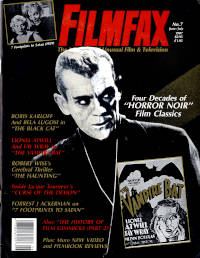

Issue: June/July 1987, #7
Language: English
Country: USA
Content: Five full pages, in black & white, including numerous pictures. They feature an article by Bill Schoell, titled "Psycho-Sexual Undertones Haunt this '60s Shocker as Robert Wise Reprises Classic Val Lewton Techniques"

Page 60, very short excerpt:
Today there seems to be only one kind of ghost story playing at the local Bijou. Influenced by The Amityville Horror, Steven Spielberg's production of Poltergeist and similar films, it is filled with colorful, explosive effects, has one-dimensional characters and is almost always "family oriented," like some dark, demented Disney film devoid of depth and thought-provoking adult material.
As escapist entertainment, colorful lightshows and exhibitions of state-of-the-art effects, there's certainly nothing wrong with Poltergeist and others of its ilk. If there is any trouble with these films, it is that their characters and storylines are always subordinate to effects. Hastily scribbled and heavily revised screenplays are built around spectacular set pieces, and logic is sacrificed on the altar of Industrial Light and Magic. The "typical American families" that inhabit these films are interesting not of themselves but only because of the horrible things that happen to them. These films have no real characters and very little to say about contemporary life and values.
This has not always been the case with ghost stories. A good example of a different, superior kind of haunted house film is "The Haunting", which was directed by Robert Wise in 1963 and is probably the director's high-water mark. At the time of the film's release, Film Quarterly called it Wise's "masterpiece," and if anything, the film seems better with each viewing.
Page 64, very short excerpt:
"The Haunting" is unusually classy and atmospheric throughout, and the prologue is only one example of the picture's consistent stylishness. In spite of some "arty" moments and blurred camera movements, the direction and photography are of a high order. David Boulton's black and white cinematography is handsome and crisp, and the house, with its odd hallways, chamber and angles, from production designer Elliot Scott, becomes a character in its own right, as was intended. Humphrey Searle's "haunting" musical themes get across the pathos of Eleanor's character most acutely, and the banging noises that reverberate through the corridors once night falls, driving most of the residents to distraction have been nicely cooked up by the sound department. As mentioned earlier, there are no major special effects to speak of (at least as compared to today's horror and supernatural films) but Tom Howard's breathing door is extremely effective. This occurs when the group is assembled downstairs and the invisible malignant force, or manifestation that seems to roam the house at will, gathers outside the door and starts pressing inward on the wooden panel, making it swell like a human stomach that’s just inhaled.
In his Danse Macabre (Everest House, 1981), Stephen King notes that "what we have in the Wise film is one of the world's few radio horror movies. Something is scratching at that ornately paneled door, something horrible. . . but it is a door Wise elects never to open." Filmmakers today open the door all the time, both because of technical capabilities and weaker characterizations and storylines. But "The Haunting" isn't about physical "horrors" and wouldn't need them in any case.
'Midnight Marquee' (USA)
Fall 1988, #37
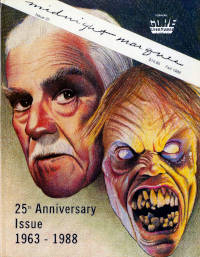

Issue: Fall 1988, #37 25th anniversary issue, 1963 - 1988
Language: English
Country: USA
Content: Three full pages, in black & white, including pictures. They feature a Robert Wise interview and an article by Delbert Winans titled "Robert Wise: A retrospective chat on Karloff, Lugosi, Cat people and Hill House."
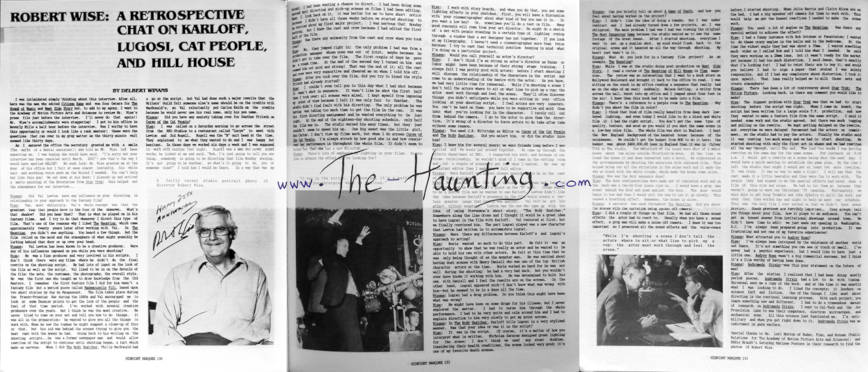
Page 192, very short excerpt:
Winans: What do you look for in a fantasy film project? As an example, "The Haunting"?
Wise: While I was at the studio doing post production on West Side Story, I read a review of "The Haunting of Hill House" in Time magazine. The review was so interesting that I went to a book store on Hollywood Boulevard and brought it back to the office to read. I was sitting on the couch in my office reading a sequence that really had me on the edge of my seat; suddenly, Nelson Getting, a writer from across the hall, burst into my office and I jumped about four feet in the air! I knew then this book had to be made into a film.
Winans: There's a reference to a purple room in "The Haunting". Why didn't you shoot the film in color?
Wise: I think that kind of film really benefits from deep dark low-keyed lighting, and even today I would like to do black and white film if I had the right script. You don't get the same type of quality, texture, and mood as you would if you shot the same scene in a low-key color film. The whole film was shot in England. I kept the New England background of the haunted house because of the uniqueness. We couldn't get the budget from MGM to do it here: the budget was about $400,000.00 less in England than it was in Culver City at the studio. The exteriors of the house were shot at a manor house about ten miles outside Stratford-On-Avon. At the time we found the house it had been converted into a hotel. We elaborated on the grotesqueness by shooting the exteriors with infrared film. This helped bring out all the striations in the stone work and it made the sky go black with the white clouds, which made the house come alive.
Winans: How was the door sequence done?
Wise: The door configurations were made out of laminated wood and on the back was a two-by-four piece tied in. I would have a prop man stand behind the door and push against the door. The door would begin to bow and then I would yell for him to let it go slowly. This caused a breathing effect. Remember, the house is alive.
Winans: A narrator was used throughout "The Haunting". Did you shoot the scenes with the narration being spoken off camera?
Wise: I did a couple of things on that film. We had all those sound effects the actor had to react to. Usually when you have a sound effect, a prop man will make a noise off camera. I knew it was too important so I pre-scored all the sound effects and the voice-overs before I started shooting. When Julie Harris and Claire Bloom are on the bed, I had a big speaker off camera for them to work with. This would help me get the honest reactions I needed to make the scene work.
Winans: You used a lot of angles on "The Haunting". Was there any special method to achieve the effect?
Wise: I had a funny instance with Bob Gotshaw at Panavision; I wanted to do these crazy angles in the halls and in the bedrooms. At the time the widest angle they had was about a 35mm. I wanted something much wider so I called Bob and I told him what I needed. He said they were working on a 28mm lens, but it wasn't ready for the market yet because it had too much distortion. I said Jesus, that's exactly what I'm looking for! I had to twist their am to buy it, and would you believe I had to sign a paper that stated I was solely responsible, and if I had any complaints about distortion, I took it upon myself. That lens really helped me to milk those sets and create atmosphere!
'Fantastyka' (France)
Oct. 2003, No. 24
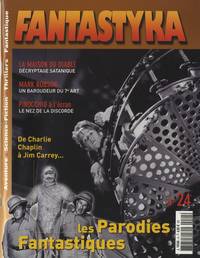

Issue: Oct. 2003, No. 24 (last and final issue of the magazine)
Language: French
Country: France
Content: Four full pages, in black & white, including numerous pictures. They feature an article by Bernard Médioni titled "La Maison du Diable — L'antre des âmes damnées".

Page 18 (Original French), very short excerpt:
Rompant avec une tendance communément admise dans la production fantastique de l'époque, les relations entre les différents protagonistes bénéficient ici d'une attention toute particulière. Elles dessinent à cet égard un réseau fort complexe, aux fils étroitement agencés. Ainsi, le docteur Markway affiche une attitude trouble à l'égard d'Eleanore, courtisée par Theodora et subjuguée par la bâtisse elle-même, tandis que Luke fait d'insipides avances aux deux médiums. On remarque de surcroit que la faiblesse devient dans le cas présent synonyme de masculin. Vénal et futile, [Luke] Sanderson se réfugie derrière un rationalisme fuyant, réfractaire aux théories du docteur Markway qui affirme avoir affaire à une demeure "malsaine, malade, folle" mais s'avère inapte à en élucider l'énigme, comme à élaborer une quelconque méthode d'investigation ou de se faire entendre par son épouse. Doit-on s'étonner alors que l'énergie et la bravoure animent le sexe "faible", habituellement — et abusivement — confiné par la création horrifique du moment dans le registre de la plasticité épouvantée ? Qu'importe, Theodora, Grace Markways et surtout Nell s'imposent naturellement comme les matrices de la progression dramatique.
Page 18 (English translation), very short excerpt:
Breaking with a commonly accepted trend in the fantasy production of the time, the relationships between the various protagonists receive special attention here. In this respect, they draw a very complex network with closely arranged threads. Dr. Markway, for example, displays a troubled attitude towards Eleanore, courted by Theodora and subjugated by the building itself, while Luke makes insipid advances to both mediums. Moreover, it is noticeable that weakness in this case becomes synonymous with masculinity. Venal and futile, [Luke] Sanderson takes refuge behind an elusive rationalism, refractory to the theories of Dr. Markway, who claims to be dealing with an "unhealthy, sick, crazy" dwelling, but proves unable to solve the enigma, to develop any method of investigation or to make himself heard by his wife. Is it any wonder then that energy and bravery animate the "weaker" sex, usually — and abusively — confined by the horrific creation of the moment in the register of frightened plasticity? Whatever, Theodora, Grace Markways and especially Nell naturally impose themselves as the matrices of the dramatic progression.
'Cinefantastique' (USA)
Oct. 1997, special double issue, Vol. 29, No. 04-05
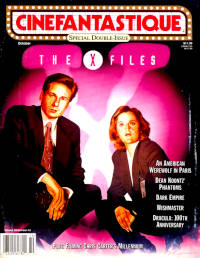

Issue: Oct. 1997, special double issue, Vol. 29, No. 04-05
Language: English
Country: USA
Content: Three full pages dedicated to The Haunting, in an 8-page thematic dossier, in black & white, including numerous pictures.
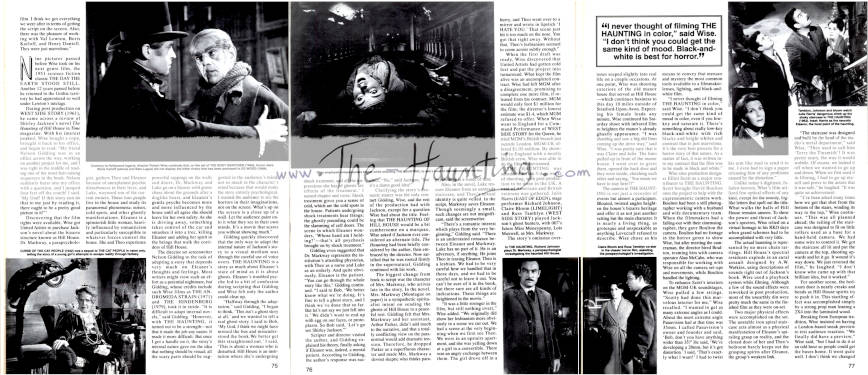
Very short excerpt:
The biggest change from book to script was the character of Mrs. Markway. who arrives late in the story. In the novel, Mrs. Markway (Montague on paper) is a sympathetic spiritualist intent on sending the ghosts of Hill House to a peaceful rest. Gidding felt that Mrs. Markway and her assistant, Arthur Parker, didn't add much to the narrative, and that a totally conflicting view on the paranormal would add dramatic tension. Therefore, he dropped Parker as a superfluous character and made Mrs. Markway a devout skeptic who thinks parapsychology is a waste of time..
Also, in the novel. Luke rescues Eleanor from an unsteady staircase, and Theo's sexual identity is quite veiled. In the script. Markway saves Eleanor. Though seemingly a small, such changes are not insignificant, said the screenwriter.
"There's a romantic interest which plays from the very beginning." Gidding said. "There is an understated romance between Eleanor and Markway. Luke has no part of it. He is an adversary, if anything. He joins Theo in teasing Eleanor. Theo is a lesbian. We had to be very careful how we handled that in those days, and we had to be careful not to leave it out. You can't be sure of it in the book, but there sure are all kinds of indications. These things are heightened in the movie."
"It was a little stronger in the film, but still nothing overt." Wise added. "We originally did show her lesbianism more obviously in a scene we cut out. We had a scene at the very beginning when we first see Theo. We were in an upstairs apartment, and she was yelling down at a girl in a convertible. There was an angry exchange between them. The girl drove off in a hurry, and Theo went over to a mirror and wrote in lipstick 'I HATE YOU.' That scene just hit it too much on the nose. You got that right away. Without that. Theo's lesbianism seemed to come across subtly enough."
Two major physical effects were accomplished on the set. The unstable iron spiral staircase acts almost as a physical manifestation of Eleanor's spiraling grasp on reality, and the closed door of her and Theo's bedroom barely keeps out the grasping spirits after Eleanor, the group's weakest link.
"The staircase was designed and built by the head of the studio's metal department." said Wise. "They used to call him 'Terry the Tinsmith'! It was pretty scary, the way it would wobble. Of course, we locked it off when we wanted to go up and down. When we first used it in filming, I had to go up myself and prove to the actors that it was safe," he laughed. "It was quite an achievement."
"I've been asked many times how we got that shot from the bottom of the stairs, winding its way to the top," Wise continues. "This was all planned ahead; the railing of the staircase was designed to fit on little rollers used as a base for a hand-held camera. We had some wire to control it. We got the staircase all lit and put the camera at the top, shooting upwards and let it go. It wound its way down. We just reversed the film." he laughed. "I don't know who came up with that brilliant idea, but it worked."
For another scene, the bedroom door is nearly creaks and bends as Hill House spirits try to push it in. This startling effect was accomplished simply by a strong prop man leaning a 2X4 into the laminated wood.
'Rue Morgue' (USA)
July/August 1999, #10
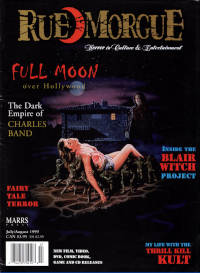

Issue: July/August 1999, #10
Language: English
Country: USA
Content: A list of the scariest films of all time.
Page 16: Rue Morgue presents: A capsulized chronology of the scariest films of all time
- Psycho (1960)
- The Haunting (1963)
- The Exorcist (1973)
- Black Christmas (1974)
- The Texas Chain Saw Massacre (1974)
- Jaws (1975)
- Suspiria (1977)
- Halloween (1978)
- The Changeling (1980)
- The Shining (1980)
- The Thing (1982)
- Candyman (1992)
- The Blair Witch Project (1999)
The remake was released at the end of July 1999. Too bad, it couldn't make it in time to be considered for that list! I'm joking: it could only feature in the top ten list of useless, pretentious, irrelevant, laughable disastrous remakes.
July 2013, #135
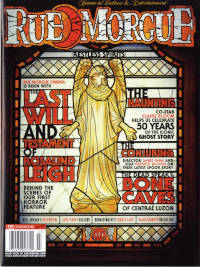

Issue: July 2013, #135
Language: English
Country: USA
Content: Five full pages, in colour, including pictures. They feature an article by Colin McCracken titled "Restless souls — Claire Bloom, co-star of "The Haunting", helps us celebrate the 50th anniversary of what may be the greatest ghost story."

Page 26, 27, 28, very short excerpts:
"There was an atmosphere created by that place," recalls [Claire] Bloom. "The house was extremely dreadful, it really was. It had a terrible, terrible feeling about it."
"It was offered to me through my agent, the same as any other role, really, but for the time it was quite shocking," states Bloom with a playful laugh, "but things have changed a great deal, haven't they?"
The actor is also quite proud of her character's look.
"I suggested Mary Quant, who was a designer of young people's clothes at that time, and very stylish," she notes, regarding Theo's wardrobe being outfitted by the woman responsible for inventing, among other things, the mini-skirt. "I think that they're wonderful [outfits] in the film. They look somewhat dated now, because they were so extreme. Especially that zebra style coat and hat, but they give a feeling of that period and they were wonderful clothes. That was my input into the look of the film."
Much of what makes the film so affecting, of course, is the atmosphere inside the house, all of which was created on the Borehamwood soundstages. To make the sets feel more authentic and claustrophobic, Wise had production designer Elliot Scott and set decorator John Jarvis go to great lengths to create believable mansion interiors, including building them with ceilings, which was unusual.
"It certainly gave us a feeling of what being in such a house, in such a situation would be like," affirms Bloom, adding that the actors still had to imagine other key elements. "Of course, we didn't have any of the sound effects on set: the walls moving, doors creaking or whatever it may have been at the time. That was all put in much later. Julie and I had to imagine all of these things, which Robert Wise explained to us in great detail. He would tell us about the voices and the movements that were taking place."
Sep. 2016, #170
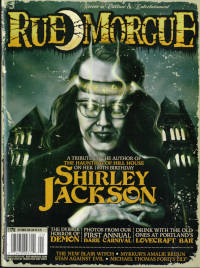

Issue: Sep. 2016, #170
Language: English
Country: USA
Content: Seven full pages, in colour, including pictures. They feature an article by April Snellings titled "Shirley Jackson — The witch of North Bennington."
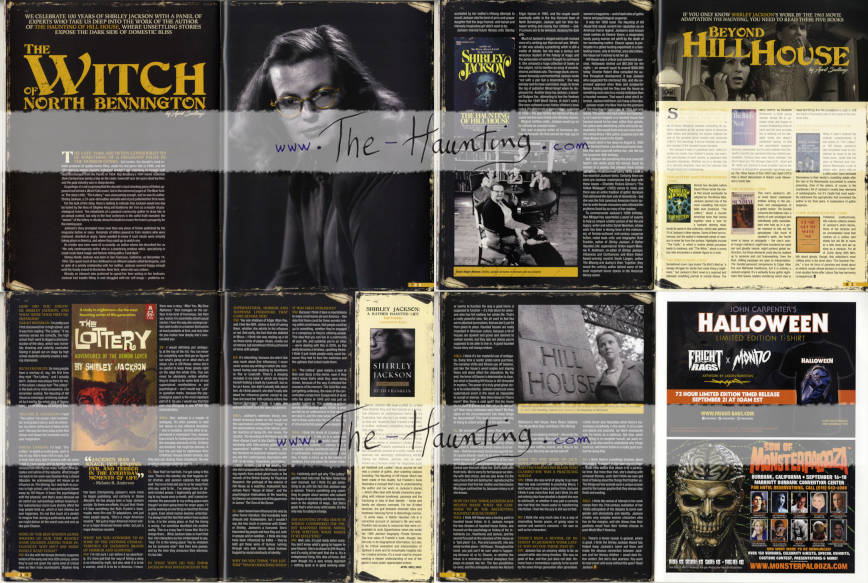
Page 18, very short excerpt:
It was her 1959 novel "The Haunting of Hill House" that would cement her reputation as an American horror legend. Jackson's best-known novel centres on Eleanor Vance, a desperately lonely young woman set adrift by the death of her overbearing mother. Eleanor agrees to participate in a ghost-hunting experiment in a foreboding manor, only to find that, once she's there, the house isn't inclined to let her go.
"[The Haunting of] Hill House" was a critical and commercial success. Hollywood shelled out $67,500 for the rights - an amount equal to around $560,000 today. Director Robert Wise consulted the author throughout development; it was Jackson who suggested the shortened title, and she expressed approval when Wise and scriptwriter Nelson Gidding told her they saw the house as something more akin to a mental institution than a haunted mansion. That wasn't what she'd intended, Jackson told them, but it was a fine idea.
Jackson made it to New York for the premiere of "The Haunting" in September of 1963, but only barely. The author who had written so masterfully of a woman trapped in a haunted house had become bound to her own; rather than ghosts, her jailers were debilitating colitis and acute agoraphobia. She would finish only one more novel: the extraordinary 1962 gothic suspense yarn "We Have Always Lived in the Castle".
'The New Yorker' (USA)
Oct. 17, 2016
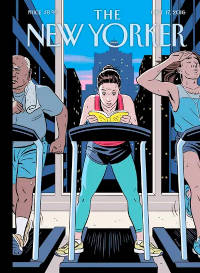

Issue: Oct. 17, 2016
Language: English
Country: USA
Content: A review of the Ruth Franklin biography of Shirley Jackson, by Zoë Heller, titled "The Haunted Mind of Shirley Jackson".
Very short excerpts:
Here's how not to be taken seriously as a woman writer: Use demons and ghosts and other gothic paraphernalia in your fiction. Describe yourself publicly as "a practicing amateur witch" and boast about the hexes you have placed on prominent publishers. Contribute comic essays to women's magazines about your hectic life as a housewife and mother.
Shirley Jackson did all of these things, and, during her lifetime, was largely dismissed as a talented purveyor of high-toned horror stories — "Virginia Werewoolf," as one critic put it. For most of the fifty-one years since her death, that reputation has stuck. Today, "The Lottery," her story of ritual human sacrifice in a New England village (first published in this magazine, in 1948), has become a staple of eighth-grade reading lists, and her novel "The Haunting of Hill House" (1959) is often mentioned as one of the best ghost stories of all time. But most of her substantial body of work — including her masterpiece, the beautifully weird novel "We Have Always Lived in the Castle" (1962) — is not widely read. In recent years, there have been signs of renewed interest in Jackson's work. Various writers, including Neil Gaiman, Jonathan Lethem, and A. M. Homes, have praised her idiosyncratic talent, and new editions of her work have appeared. But these attempts to reclaim Jackson have had a mixed response. In 2010, when the Library of America published an edition of Jackson's selected works, edited by Joyce Carol Oates, a critic at Newsweek protested that it was an exercise in barrel-scraping: "Shirley Jackson? A writer mostly famous for one short story, 'The Lottery.' Is LOA about to jump the shark?"
Nov. 12, 2018
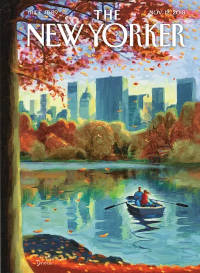

Issue: Nov. 12, 2018
Language: English
Country: USA
Content: An article by Emily Nussbaum titled "Netflix's Soul-Dead Version of The Haunting of Hill House".
Very short excerpts:
When I hit play on Netflix's adaptation of "The Haunting of Hill House," I didn't expect to end up rooting for the house. The opening episodes of this interpretation of Shirley Jackson's classic gothic-horror story were promisingly eerie, all shadows and inky blacks, and I crossed my fingers for something satisfying—a stylishly directed Halloween binge-watch, with a few decent jump scares. And, now and then, it delivers. But there's something existentially soul-dead to the over-all enterprise; it has corn syrup in its veins instead of blood.
Jun. 08-15, 2020
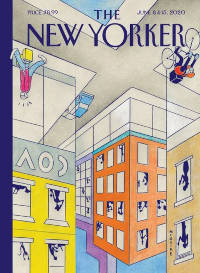

Issue: Jun. 08-15, 2020
Language: English
Country: USA
Content: An article by Anthony Lane titled "Shirley Takes a One-Sided View of Its Subject".
Very short excerpts:
No one can question Decker's creative right to take such liberties with the truth. Movies live and thrive on irresponsibility. How strange it feels, though, when so little seems to be liberated in the process. Jackson's book of essays on her domestic exploits, "Life Among the Savages" (1953), rich in the comedy of parental mishaps, is a fascinating complement, not an embarrassment, to her graver tales of the stifling and the macabre. "Shirley," by contrast, coats her in gothic excess as if glazing a ham, and of her humor scarcely a shred remains. As a sworn devotee of "Airplane!," I found myself praying that once — just once — she would utter the words "And don't call me Shirley," thus rending the veil of gloom from top to bottom. Sadly, it was not to be.
Jun. 29, 2020
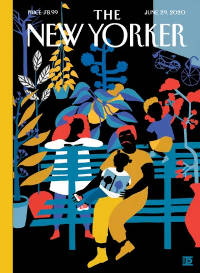

Issue: Jun. 29, 2020
Language: English
Country: USA
Content: An article by Michael Schulman titled "Shirley Jackson's Son Talks to His Fictional Mom, Elisabeth Moss".
Very short excerpts:
"Shirley" is now out on demand, and Hyman is still digesting. "If someone comes to the movie not knowing anything about my parents, they will certainly leave thinking that my mother was a crazy alcoholic and my father was a mean critic," he said the other day. He and Moss were reconnecting on Zoom; he was at his home, in Northern California, and Moss was on the Upper West Side, curled up in a floral hoodie. Hyman handles his mother's estate, but he wasn't involved with "Shirley," which is based on a novel by Susan Scarf Merrell. It imagines Jackson and her husband, the New Yorker critic Stanley Edgar Hyman (played by Michael Stuhlbarg), taking in and terrorizing a young couple at their home, in Vermont, while Jackson works on her 1951 novel, "Hangsaman."
'Popular Science' (USA)
Fall 2020
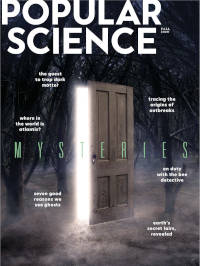

Issue: Fall 2020
Language: English
Country: USA
Content: Ten full pages, in colour, on a thematic dossier "Why we see ghosts".
The dossier is interesting because it is a science magazine. Without being boring, it explores the different possibilities and hypotheses: the psychological aspect of our desire to believe, the biases introduced by our primary survival reflexes, the need for companionship, the disturbances in our brain, etc.
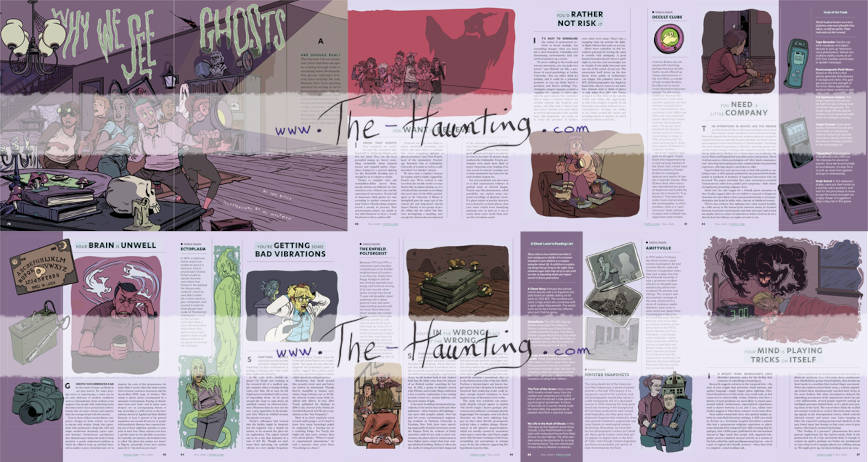
Page 82, very short excerpts:
Tools of the Trade
Would-be ghost hunters use a host of gizmos, some more plausible than others, to sniff out spirits. These tools make up their arsenal.
Tape recorder: Sleuths use both cassettes and digital devices to pick up "electronic voice phenomena." Almost any auditory oddity counts as an EVP, from crackles and thumps to spoken messages.
Electromagnetic Field Meter: Based on the theory that ghosts generate disturbances in background static, this gadget measures the strength of the force. Many appliances produce these currents as well.
Full Spectrum Camera: This clicker captures not just visible light but also infrared and ultraviolent frequencies. The broad range affords specter hunters crucial advanced night vision for midnight scouring.
Geiger Counter: Some spirit seekers think that haunts emit trace level of radioactive material. Detectives tote this machine to identify and track the amount of these particles in the surrounding air.
"Ghost Box": This phantom-finding radio scans AM and FM channels for abnormal signals. Since we're surrounded by soundwaves, it is easy for it to pick up noise that appears strange or otherworldly.
Ouija Board: In this sleepover staple, users put their hands on a pointer, ask a question, and wait for the planchette to move across the board and spell out a reply. Power of suggestion plays a big role in this game.
'Retro Fan' (USA)
Nov. 2021, #17
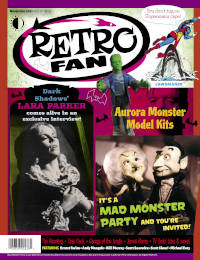

Issue: Nov. 2021, #17
Language: English
Country: USA
Content: Fourteen full pages, in colour, including numerous pictures. They feature an article by Ernest Farino titled "Whose Hand Was I Holding...?"
Full disclosure: I received a free copy of the magazine, as a thank you for my (modest) contribution to the article.
You can buy a copy of the magazine on the website of the publisher, TwoMorrows. I should point out, however, that we are not affiliated, that I do not receive any commission on sales and that I cannot be held responsible for any problem.




Obviously, the article is very long and contains a lot of fascinating elements. I had to make a choice to make you want to read it without giving too much away.
Page 49, very short excerpts:
Tom Howard was the Visual Effects/Optical Supervisor, and was a prominent figure in British visual effects in those days. Moreso than, say, miniatures, Howard was known as an optical and/or "blue screen guy," which supports the viability of the traveling matte idea. His extensive credits include 2001: A Space Odyssey, Where Eagles Dare, and many others.
There's another shot a bit later, inside the house, where Eleanor appears to walk forward, the room behind her gradually darkening (fading out). This shot, too, was a traveling matte with Julie Harris "walking in place" on a small treadmill on the stage. Likewise, as Eleanor drives up the path to the front gate when she arrives, the first two to three shots are "real" (the camera mounted on the hood of the car with real backgrounds visible outside the rear and side windows), but suddenly there are two to three shots in which the background trees and the overall view appears markedly different. These, too, are traveling mattes. The reason for the switch will never be known, but, having faced many "fix-up" tasks myself on films, my guess is that those last couple of shots were either added later (and since they were no longer on that location had to be staged in studio), or the negative was damaged, or something like that.
'Télérama' (France)
Aug. 6, 2022
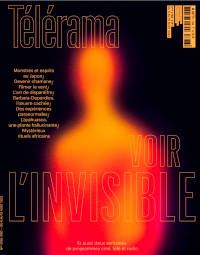

Issue: Aug. 2022, double issue #3786-3787
Language: French
Country: France
Content: Nine full pages, in colour, with two thematic dossiers "The invisible" & "At the edge of reality".
"The invisible" — is a long interview and discussion with Philippe Charlier, PhD, anthropologist and archaeologist, about "the world of the invisible", including but not limited to: the supernatural, the 19th century wave of spiritualism and zombies in Haiti. I found the whole feature fascinating to read, because he is a doctor, a very serious scientist with his feet firmly on the ground, director of the Research and Education Department at the "Musée du Quai Branly", Paris, and yet is has an open mind on these subjects.
"At the edge of reality" — is a feature on the IMI: l’Institut Métapsychique International (the International Metapsychic Institute), in Paris, with Mario Varvoglis, PhD in cognitive sciences, its president since 1998.
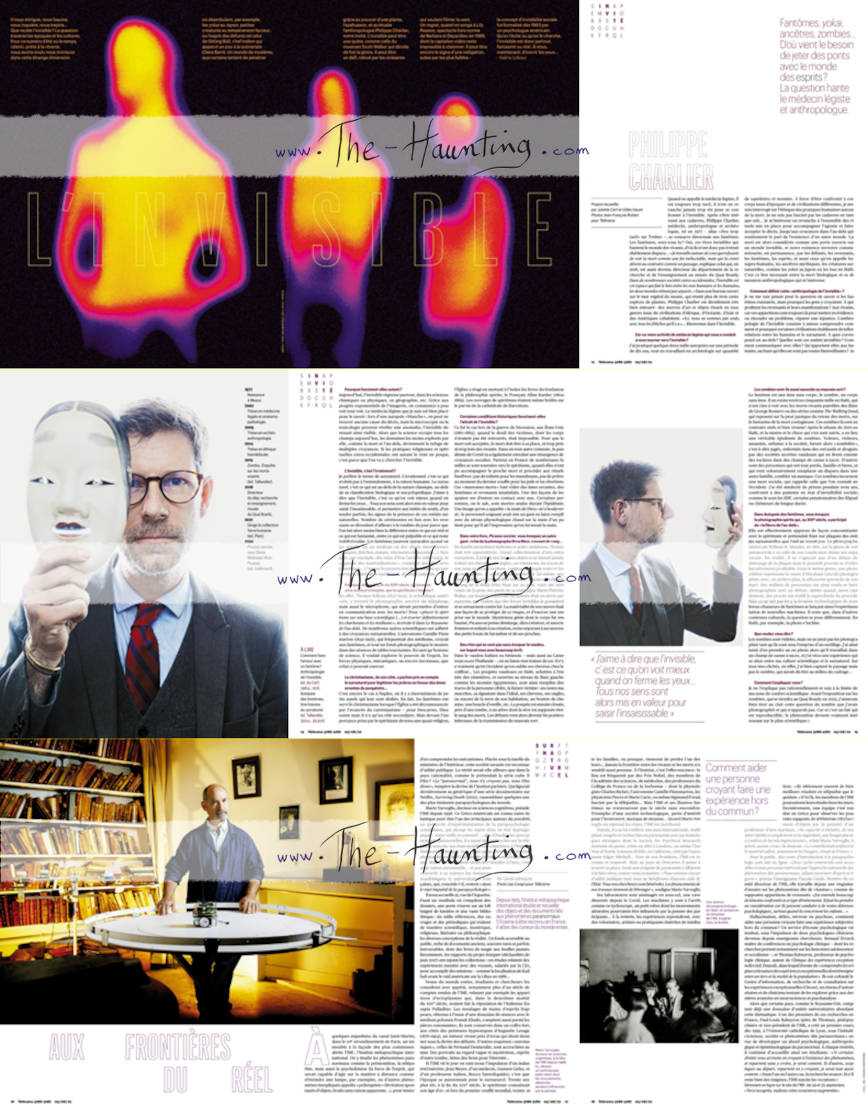
Page 14 (Original French), "The invisible", very short excerpts:
Q: L'invisible, c'est l'irrationnel ?
R: Je préfère le terme de surnaturel. L'irrationnel, c'est ce qui n'obéit pas à l'entendement, à la raison humaine. Le surnaturel, c'est ce qui est au-delà de la nature classique, au-delà de sa classification biologique et encyclopédique. J'aime à dire que l'invisible, c'est ce qu'on voit mieux quand on ferme les yeux... Tous nos sens sont alors mis en valeur pour saisir l'insaisissable, et permettre aux initiés de sentir, d'entendre parfois, les signes de la présence de ces entités surnaturelles. Nombre de cérémonies en lien avec les revenants se déroulent d'ailleurs à la tombée du jour parce que l'on fait alors moins bien la différence entre ce qui est réel et ce qui est fantasmé, entre ce qui est palpable et ce qui reste indéfinissable. Les fantômes peuvent apparaître quand on les appelle via un médium ou des objets intercesseurs (masques, fétiches, statues, vêtements cérémoniels...). Vers 1900, par exemple, des seins d'Eva Carrière (1884-1943), la "papesse des matérialisations", coulaient des filets ectoplasmiques... C'est par le corps érotisé de la médium qu'une partie du fantôme se manifestait, devenait palpable.
Q: Pourquoi est-ce à la fin du XIXe siècle, au moment où la science triomphe, que le spiritisme s'impose ?
R: En effet, Thomas Edison (1847-1931), le scientifique américain, a inventé le phonographe, ancêtre du téléphone, mais aussi le nécrophone, qui devait permettre d'entrer en communication avec les morts ! Pour "placer le spiritisme sur une base scientifique (...) et écarter définitivement les charlatans et les médiums", écrivait-il dans "Le Royaume de l'au-delà". De nombreux autres scientifiques ont adhéré à des croyances surnaturelles. L'astronome Camille Flammarion (1842-1925), qui fréquentait des médiums, croyait aux fantômes, et tout un fonds photographique le montre dans des séances de tables tournantes. En tant qu'homme de science, il voulait explorer le pouvoir de l'esprit, les forces physiques, mécaniques, ou encore inconnues, que celui-ci pouvait exercer.
Page 14 (English translation), "The invisible", very short excerpts:
Q: Is the invisible the irrational?
A: I prefer the term supernatural. The irrational is that which does not obey human understanding or reason. The supernatural is what is beyond classical nature, beyond its biological and encyclopaedic classification. I like to say that the invisible is what we see best when we close our eyes... All our senses are then brought into play to grasp the elusive, and allow the initiated to feel, and sometimes hear, the signs of the presence of these supernatural entities. Many ceremonies linked to ghosts take place at dusk because we are less able to distinguish between what is real and what is fantasised, between what is palpable and what remains indefinable. Ghosts can appear when called upon through a medium or through intercessory objects (masks, fetishes, statues, ceremonial clothing, etc.). Around 1900, for example, the breasts of Eva Carrière (1884-1943), the "papess of materializations", were flowing with ectoplasmic threads... It was through the eroticized body of the medium that a part of the ghost manifested itself, became palpable.
Q: Why was it at the end of the 19th century, when science was triumphant, that spiritualism was established?
A: Thomas Edison (1847-1931), the American scientist, invented the phonograph, the ancestor of the telephone, but also the necrophone, which was supposed to allow communication with the dead! In order to "place spiritualism on a scientific basis (...) and definitively eliminate charlatans and mediums", he wrote in "Le Royaume de l'au-delà". Many other scientists adhered to supernatural beliefs. The astronomer Camille Flammarion (1842-1925), who frequented mediums, believed in ghosts, and there is an entire photographic collection showing him at turntable sessions. As a man of science, he wanted to explore the power of the spirit, the physical, mechanical or even unknown forces that it could exert.
Page 17-18 (Original French), "At the edge of reality", very short excerpts:
Si l'IMI vit le jour en 1919 (sous l'impulsion d'un industriel mécène, Jean Meyer, d'un médecin, Gustave Geley, et d'un professeur italien, Rocco Santoliquido), c'est que l'époque se passionnait pour le surnaturel. Trente ans plus tôt, à la fin du XIXe siècle, le spiritisme connaissait son âge d'or ; et lors du premier conflit mondial, toutes les familles, ou presque, viennent de perdre l'un des leurs... Jamais la frontière entre les vivants et les morts n'a semblé aussi poreuse. À l'Institut, c'est l'effervescence : le lieu est fréquenté par des Prix Nobel, des membres de l'Académie des sciences, de médecine, des professeurs du Collège de France ou de la Sorbonne - dont le physiologiste Charles Richet, l'astronome Camille Flammarion, les physiciens Pierre et Marie Curie, ou même Sigmund Freud, fasciné par la télépathie... Mais l'IMI et ses illustres fantômes ne traverseront pas le siècle sans encombre. Triomphe d'une société technologique, perte d'intérêt pour l'irrationnel, manque de moyens... Quand Mario Varvoglis en reprend les rênes, l'IMI est moribond.
Depuis, il a su lui conférer une aura internationale, multipliant congrès et recherches en partenariat avec ses homologues étrangers dont la Society for Psychical Research, doyenne du genre, créée en 1882 à Londres, ou même l'Institut of Noetic Sciences (IONS), en Californie, créé par l'astronaute Edgar Mitchell... Hors de nos frontières, l'IMI est reconnu et respecté. Mais au pays de Descartes il peine à trouver sa place. Seuls une poignée de passionnés s'affairent à le faire vivre, contre vents et marées : "Nous sommes classés d'utilité publique mais nous ne bénéficions d'aucune aide de l'État. Tous nos chercheurs sont bénévoles. Les financements de nos travaux viennent de l'étranger", souligne Mario Varvoglis.
Page 17-18 (English translation), "At the edge of reality", very short excerpts:
If IMI was founded in 1919 (under the impetus of an industrialist patron, Jean Meyer, a doctor, Gustave Geley, and an Italian professor, Rocco Santoliquido), it was because the era was passionate about the supernatural. Thirty years earlier, at the end of the 19th century, spiritualism was experiencing its golden age; and during the first world conflict, almost every family had just lost one of its members... Never has the border between the living and the dead seemed so porous. At the Institute, it was a hive of activity: the place was frequented by Nobel Prize winners, members of the Academy of Sciences and Medicine, professors from the Collège de France and the Sorbonne - including the physiologist Charles Richet, the astronomer Camille Flammarion, the physicists Pierre and Marie Curie, and even Sigmund Freud, who was fascinated by telepathy... But the IMI and its illustrious ghosts did not make it through the century unhindered. The triumph of a technological society, the loss of interest in the irrational, the lack of resources... When Mario Varvoglis took over the reins, IMI was moribund.
Since then, he has succeeded in giving it an international aura, multiplying congresses and research in partnership with its foreign counterparts, including the Society for Psychical Research, the oldest of its kind, created in 1882 in London, and even the Institute of Noetic Sciences (IONS), in California, created by the astronaut Edgar Mitchell... Outside our borders, IMI is recognised and respected. But in the land of Descartes it is struggling to find its place. Only a handful of enthusiasts are working hard to keep it alive, against all odds: "We are classified as a public utility but we receive no state aid. All our researchers are volunteers. The funding for our work comes from abroad," stresses Mario Varvoglis.
'Little Shoppe of Horrors' (USA)
Halloween 2023, #49


Issue: Halloween 2023, #49
Language: English
Country: USA
Content: Magazine cover, page 2 (colour artwork by Chantal Handley), plus twenty full pages, in black & white, including numerous pictures and reproductions of original documents. They feature an article by Anthony McKay titled "The road to Hill House; The making of Robert Wise's The Haunting".
It would be unfair to call it another magazine article; it's much more than that. The author has explored numerous sources of exceptional documents over a considerable period of time to offer us a diary of the making of the film. Day by day, we can discover all the work carried out by the technical team and the actors to create all the elements that led to the film as we know it today. It's a goldmine of information and incredible discoveries, packed with fascinating anecdotes and numerous side-notes on important people or facts. I recommend it without reservation to all fans of the film, it's a must-have in your collection.
Full disclosure: I received a copy of the magazine, sent by the publisher, on the request of the author.
You can buy a copy of the magazine on the website of the publisher, Little Shoppe of Horrors. I should point out, however, that we are not affiliated, that I do not receive any commission on sales and that I cannot be held responsible for any problem.
The magazine is well worth the money — there's no doubt about that — but before importing it from the USA to Europe, make sure you have all the necessary information, as customs, fees, taxes and import charges can be very, very high in some countries. In my case, this nearly quadrupled the price of the magazine.











Obviously, the article is very long and contains a lot of fascinating elements. I had to make a choice to make you want to read it without giving too much away.
Page 34-35, very short excerpts
First day of production
With Julie Harris — who had finished her run in "A Shot in the Dark" only 12 days earlier — now available, production of "The Haunting" officially began with "Call 1" on Thursday October 4. This was an 8:30 call for Richard Johnson, Fay Compton, and Ronald Adam for rehearsals on the set for "Interior — Mrs. Sannerson's Living Room" on Stage 3, the largest stage in the studio which had recently housed a 152-foot reproduction of a Boeing 707 that had been built for "Come Fly with Me."
The set dressing for the scene required "Abigael's cane" and a "Tray and silver Revere tea service" to reflect the stage direction in the script: (Mrs. Sannerson) "sits behind the same tea service we saw the companion carrying up the spiral staircase. Leaning against Mrs. Sannerson's chair is old Miss Abby's gold-headed cane."
The scripted sequence described the doomed companion winding her way up the spiral staircase: "She carries a tray with a silver Revere tea service and coiled length of rope on it." There was reference to a family dispute over the theft of a "silver service" in Shirley Jackson's novel that Gidding may have been alluding to here.
In the finished film, the silver tray holds nothing but the rope — an actor could not be required to climb the stairs while balancing a heavy tea service and a rope on the tray, one handed. According to call sheets, the complete tea service would be present on set during filming of the earlier staircase scene in December, so it is probable that some attempt was made to film the scene with the tray fully laden.
Julie Harris attended the studio but had no scenes to film. On this day, 6 actresses were auditioned for the role of "Mrs. Crain 1st" and another six would be auditioned the following day.
Books about Robert Wise, The Haunting or Shirley Jackson
'Shirley Jackson'
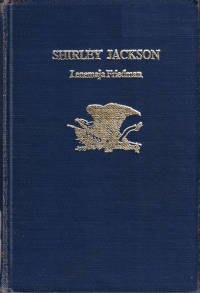
Title: Shirley Jackson
Author: Lenemaja Friedman
Hardcover: 182 pages
Publisher: Twayne publishers (January 1975)
Language: English
ISBN-10: 0-8057-0402-7
ISBN-13: 978-0-8057-0402-0
Product Dimensions: 14 x 1,3 x 21 cm
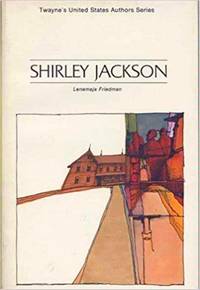
Title: Shirley Jackson
Author: Lenemaja Friedman
Paperback: 182 pages
Publisher: Bobbs-Merrill Co (June 1975)
Language: English
ISBN-10: 0-672-61507-X
ISBN-13: 978-0-672-61507-8
Product Dimensions: 7.9 x 5.3 x 0.5 inches; 20 x 13,5 x 1,2 cm
Very short excerpt
The inspiration to write a ghost story came to Miss Jackson, according to her account in the article "Experience and Fiction," as she was reading a book about a group of nineteenth-century psychic researchers who rented a haunted house in order to study it and record their impressions of what they had seen and heard for the purpose of presenting a treatise to the Society for Psychic Research. As she recalls: "They thought that they were being terribly scientific and proving all kinds of things, and yet the story that kept coming through their dry reports was not at all the story of a haunted house, it was the story of several earnest, I believe misguided, certainly determined people, with their differing motivations and backgrounds." The story so excited her that she could hardly wait to create her own haunted house and her own people to study it.
Shortly thereafter, she states, on a trip to New York, she saw at the 125th Street station, a grotesque house — one so evil-looking, one that made such a somber impression, that she had nightmares about it long afterward. In response to her curiosity, a New York friend investigated and found that the house, intact from the front, was merely a shell since a fire had gutted the structure, leaving only the frame of the remaining walls. In the meantime, she was searching newspapers, magazines, and books for pictures of suitably haunted-looking houses; and she at last discovered a magazine picture of a house that seemed just right. It looked very much like the hideous building she had seen in New York: ". . . it had the same air of disease and decay, and if ever a house looked like a candidate for a ghost, it was this one." The picture identified the house as being in a California town; consequently, hoping her mother in California might be able to acquire some information about the house, she wrote asking for help. As it happened, her mother was not only familiar with the house but provided the startling information that Miss Jackson’s great-grandfather had built it. Apparently, it had stood vacant and deserted for many years until, it was believed, a group of townspeople burned it down. She had been surprised that there were still pictures of the house in circulation.
While seeking the proper house, Miss Jackson did research about ghosts. As she says, she had always been interested in witchcraft and superstition, but she knew little about spirits. Her information came from personal inquiry and the reading of books, especially true ghost stories. No one that she contacted had ever seen a ghost, but most people had the uneasy suspicion that, at some undisclosed time, they just might run into one. After the house had been selected and with the psychic research well under way, the writing went smoothly Finally, the novel was finished; published in 1959 by the Viking Press, it went through several printings and many foreign editions; it was hailed by critics as one of the best spine-chillers in years.
When Roald Dahl read the book, he contacted Miss Jackson to ask that she consider writing a script for a television show that Emlyn Williams was doing in Britain; for some unknown reason, however, Miss Jackson did not comply with the request. Four years later, on August 21, 1963, the world premiere of the movie version (The Haunting) starring Julie Harris and Claire Bloom was held at theaters throughout the Bennington area. Filmed in England, its producer Robert Wise chose as Hill House the historic, centuries’ old Ettington Hall near Stratford-on-Avon in Warwickshire. Miss Jackson was pleased with the film, for she felt that the movie retained the original atmosphere of the book.
[This is a very short excerpt of the book. Buy it to read it in its full length]
'Les fiches de Monsieur Cinéma', card 'La Maison du Diable'
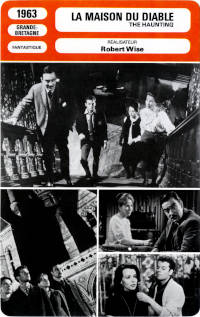
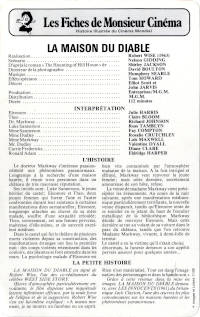
Title: Les fiches de Monsieur Cinéma / La Maison du Diable
Collection supervisor: Pierre Tchernia
Publisher: Images et Loisirs (1976-ongoing)
Language: French
This is not a book but an encyclopaedia of cinema distributed in the form of individual cards. All these cards together make up the encyclopaedia.
"Monsieur Cinéma" refers both to the television programme of the same name and to its co-presenter who was extremely well known in France, Pierre Chernia.
"Monsieur Cinéma" was a French television programme devoted to cinema proposed and presented by Pierre Tchernia and Jacques Rouland and broadcast every Sunday afternoon on the ORTF's second colour channel from 18 September 1967 to 1972. It was back on Antenne 2 from 1975 to 1977, then again from 1978 to 28 June 1980.
To surf on the popularity of the programme, the "Images et Loisirs" publishing house has offered this encyclopaedia in the form of cards, available by subscription.
Here is the card dedicated to "La Maison du Diable" [The Haunting].
Since the release of the first batch in 1976, these cards have been distributed to 100,000 French households and as of today, still have 7,000 subscribers.
After the section devoted to the cast and technical team, the cards introduces the film.
Card content (Original French)
Le docteur Markway s'intéresse passionnément aux phénomènes paranormaux. Longtemps à la recherche d'une maison hantée, il réunit trois personnes dans un château de très mauvaise réputation. Ses invités sont : Luke Sannerson, le jeune héritier du castel ; Éléonore et Théo, deux jeunes femmes qui furent l'une et l'autre confrontées durant leur existence à certaines manifestations dites surnaturelles ; Éléonore, longtemps attachée au chevet de sa mère malade, souffre d'une sexualité refoulée ; Théo, inversement, est une femme perverse, maîtresse d'elle-même, et de surcroît excellent médium.
Dans le castel qui fut le théâtre de plusieurs morts violentes depuis sa construction, des manifestations étranges ont lieu la première nuit : des coups violents retentissent dans les couloirs, des plaintes se font entendre dans les murs. La psychologie malade d'Éléonore est bien vite contaminée par l'atmosphère malsaine de la maison. A la fois intrigué et effrayé, Markway veut renvoyer la jeune femme ; mais cette dernière, secrètement amoureuse de son hôte, refuse.
La venue de madame Markway vient précipiter les événements. Au cours de la nuit suivante, après une manifestation médiumnique particulièrement terrifiante, la nouvelle venue disparait, tandis qu'Eléonore tente de se suicider en se jetant du haut de l'escalier métallique de la bibliothèque. Markway décide de renvoyer Éléonore. Mais cette dernière se tue au volant de sa voiture dans le parc du château, tandis que l'on retrouve Madame Markway, vivante, à demi-folle de terreur.
Le castel a eu la victime qu'il s'était choisi ; désormais, la funeste demeure a son appétit pervers assouvi pour quelques années...
LA MAISON DU DIABLE est signé de Robert Wise, l'un des coréalisateurs du célèbre WEST SIDE STORY. Œuvre d'atmosphère particulièrement envoûtante, le film dispense une inquiétude latente infiniment efficace, par la seule force de l'ellipse et de la suggestion. Robert Wise s'en est lui-même expliqué : " A aucun moment, je ne montre un fantôme ou un esprit. Rien n'est matérialisé. Tout est dans l'imagination des personnages et dans la bande-son. "
Grâce à cette retenue dans la mise en images, LA MAISON DU DIABLE demeure, avec LES INNOCENTS (1961) du britannique Jack Clayton, l'une des œuvres les plus convaincantes sur les maisons hantées et les phénomènes paranormaux.
Card content (English translation)
Dr. Markway is passionately interested in paranormal phenomena. For many years, he has been looking for a haunted house and he brings three people together in the castel (Hill House) with a very bad reputation. His guests are : Luke Sannerson, the young heir of the castle; Eleonore and Theo, two young women who were both confronted during their lives with certain so-called supernatural manifestations; Eleonore, long attached to her sick mother's bedside, suffers from repressed sexuality; Theo, on the other hand, is a perverse woman, mistress of herself, and an excellent medium.
In the castel (Hill House), which has been the scene of several violent deaths since it was built, strange demonstrations take place on the first night: violent blows resound in the corridors, complaints are heard in the walls. Eleanor's sickly psychology is soon contaminated by the unhealthy atmosphere of the house. Both intrigued and frightened, Markway wants to send the young woman away; but the latter, secretly in love with her host, refuses.
The arrival of Mrs. Markway precipitated the events. During the following night, after a particularly terrifying psychic demonstration, the newcomer disappears, while Eleanor tries to commit suicide by throwing herself from the top of the metal staircase of the library. Markway decides to send back Eleonore. But the latter kills herself at the wheel of her car in the castle park, while Mrs. Markway is found alive, half-crazy with terror.
The castel (Hill House) had the victim it had chosen for itself; from now on, the fateful house has its perverse appetite satisfied for a few years .
LA MAISON DU DIABLE [THE HAUNTING] is directed by Robert Wise, one of the co-directors of the famous WEST SIDE STORY. A particularly bewitching work of atmosphere, the film dispels a latent anxiety infinitely effective, by the sole force of ellipsis and suggestion. Robert Wise explained himself: "At no time do I show a ghost or a spirit. Nothing is materialised. It is all in the imagination of the characters and in the soundtrack. "
Thanks to this moderation in the mise en images, LA MAISON DU DIABLE [THE HAUNTING] remains, along with LES INNOCENTS [THE INNOCENTS] (1961) by British director Jack Clayton, one of the most convincing works on haunted houses and paranormal phenomena.
'Les fiches de Monsieur Cinéma', card 'Robert Wise'
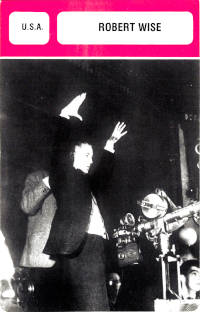
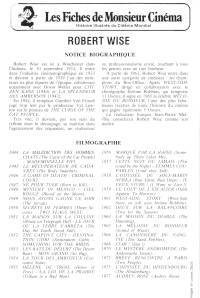
Title: Les fiches de Monsieur Cinéma / Robert Wise
Collection supervisor: Pierre Tchernia
Publisher: Images et Loisirs (1976-ongoing)
Language: French
I am not going to transcribe the filmography because you will find a more comprehensive version elsewhere.
Card content (Original French)
NOTICE BIOGRAPHIQUE
Robert Wise est né à Winchester dans l'Indiana, le 10 septembre 1914. Il entre dans l'industrie cinématographique en 1933 et devient à partir de 1939 l'un des monteurs les plus réputés de l’époque, collaborant notamment avec Orson Welles pour CITIZEN KANE (1940) et LA SPLENDEUR DES AMBERSON (1942).
En 1944, il remplace Gunther Von Fritsch jugé trop lent par le producteur Val Lewton sur le plateau de THE CURSE OF THE CAT PEOPLE.
Très vite, il devient, par son sens du rythme dans le découpage, sa maîtrise dans l’agencement des séquences, un réalisateur au professionnalisme envié, touchant à tous les genres avec un rare bonheur.
A partir de 1961, Robert Wise entre dans une autre catégorie de cinéastes : les champions du Box-Office. Après WEST-SIDE STORY, dirigé en collaboration avec le chorégraphe Jérôme Robbins, qui remporte 11 Oscars, il signe en 1965 la célèbre MELODIE DU BONHEUR, l’une des plus fabuleuses recettes de toute l'histoire du cinéma qui gagne également 5 Oscars.
Le réalisateur français Jean-Pierre Melville considérait Robert Wise comme son maître.
Card content (English translation)
BIOGRAPHICAL NOTE
Robert Wise was born in Winchester, Indiana, on September 10, 1914. He entered the film industry in 1933 and from 1939 onwards became one of the most renowned editors of the time, collaborating notably with Orson Welles on CITIZEN KANE (1940) and THE MAGNIFICENT AMBERSONS (1942).
In 1944, he replaced Gunther Von Fritsch, considered too slow by producer Val Lewton, on the set of THE CURSE OF THE CAT PEOPLE.
Very quickly, with his sense of rhythm in the cutting and his mastery in the arrangement of sequences, he became a director of enviable professionalism, touching all genres with rare happiness.
From 1961 onwards, Robert Wise entered another category of filmmakers: the champions of the Box-Office. After WEST-SIDE STORY, directed in collaboration with choreographer Jerome Robbins, which won 11 Oscars, he signed in 1965 the famous THE SOUND OF MUSIC, one of the most fabulous box-office hits in the history of cinema, which also won 5 Oscars.
The French director Jean-Pierre Melville considered Robert Wise to be his master.
'Robert Wise', a French book!
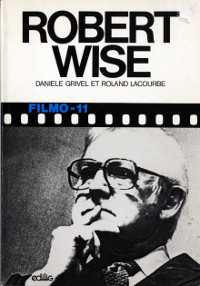
Title: Robert Wise
Author: Daniele Grivel, Roland Lacourbe
Paperback: 158 pages
Publisher: Edilig (January 1985)
Language: French
ISBN-10: 2-85601-119-5
ISBN-13: 978-2-85601-119-5
Product Dimensions: 15 x 21,5 x 1,2 cm
Very short excerpt (Original French)
"La Maison du Diable" est considérée à juste titre par les amateurs de fantastique comme une oeuvre exemplaire. C'est à coup sûr l'un des films les plus ambitieux et les plus sérieux jamais consacrés aux phénomènes paranormaux. Ajoutons qu'il peut aisément prétendre au qualificatif de film le plus terrifiant de l'histoire du cinéma... Et pourtant, pas une seule fois Robert Wise ne recourt aux procédés habituels du Grand Guignol : aucun meurtre, pas de monstre ou de cadavre sanguinolent, nulle attaque à la hache ou à la tronçonneuse. La seule vision du film ridiculise à tout jamais les innombrables tentatives d'horreur viscérales de ces vingt dernières années. Rien que la minutieuse mise en place d'un climat étrange, insolite, propice à la peur. Car "La Maison du Diable" suscite la perception d'un monde indicible, invisible, menaçant, côtoyant sans cesse le nôtre. Et Hill House est une porte de communication pour pénétrer dans cet univers d'effroi.
Il faudrait pouvoir disséquer le film comme le docteur Markway étudie la conception du castel, ce monument de falsification architecturale dans lequel tous les chambranles ont été construits de travers pour que les portes se ferment d'elles-mêmes. Car, en nous faisant pénétrer dans la maison hantée en compagnie de son quatuor de chasseurs de fantômes, Wise se livre à notre détriment à une tentative unique de terreur expérimentale. Dans son entretien avec Rui Nogueira, il consent à nous révéler une de ses recettes : l'extrême élaboration de la bande sonore. Grincements, craquements, chuchotements, ricanements, cris d'enfant, son ténu et grave d'une voix qui murmure, frôlements le long des portes, petits attouchements inquisiteurs ou bruits tonitruants qui ébranlent les fondations, la nuit : ce catalogue de la suggestion auditive, d'une exceptionnelle richesse, atteint une sorte de délire paroxystique. La simple vibration d'une harpe sous le souffle d'un hypothétique courant d'air suffira ensuite à nous faire sursauter... Ajoutons à cela l'épaisse obscurité des corridors qui semble venir à l'assaut des visiteurs pour mieux les engloutir, ou l'éclairage savant des murs lambrissés qui suggère d'horribles présences en leur intérieur... Sur le plan technique, un minimum d'effets spéciaux : une pellicule sensible aux infrarouges qui donne une vision particulière de la texture de la pierre ; quelques objectifs déformants pour distordre les perspectives... Et la vision inoubliable de cette porte du salon ployant sous la poussée fantastique d'une force mauvaise surgissant du couloir, et donnant sa matérialité à l'existence immonde et impalpable, tapie dans ce "havre de désespoir" ; cette maison perverse qui vit, respire et "exhale l'arrogance et la haine" ...
"La peur est l'abandon de la logique, la renonciation volontaire aux schémas de pensée raisonnable", écrit Shirley Jackson dans le roman originel par ailleurs ennuyeux, interminable et fort médiocre. Nul doute que le cinéaste ait gardé cette petite phrase à l'esprit tout au long du tournage. Sa mise en scène — "mise en condition" serait plus appropriée — ne vise qu'à accroître notre réceptivité pour que nous renoncions insensiblement à notre regard critique et à notre libre arbitre. Quelqu'un a parlé de "film magique". En effet, c'est bel et bien d'un envoûtement qu'il s'agit.
La suprême habileté est d'avoir réussi un mariage entre la psychanalyse et le fantastique : Wise avoue s'être particulièrement intéressé au développement des rapports d'amitié assez troubles entre les deux jeunes femmes (un aspect que le roman ne faisait qu'effleurer). Eleonore est une mythomane à la sexualité refoulée, torturée par le sentiment diffus d'une faute (elle se considère comme responsable de la mort de sa mère). Théodora, une lesbienne un peu névrosée. Toutes deux, d'une sensibilité exacerbée, sont particulièrement réceptives aux ondes de l'au-delà. Elles deviendront les catalyseurs qui déclencheront les manifestations des forces occultes. Mais la terreur qui envahit soudainement le castel n'est-elle pas simplement issue de leurs cerveaux enfiévrés ? Pour Wise, constate Michel Mardore, "l'angoisse ressentie au contact de phénomènes étrangers et inexplorés cristalliserait nos obsessions et nos névroses, jusqu'à l'exécution des événements désirés en secret par notre subconscient". En d'autres termes, Eleonore, s'abandonnera aux forces du mal pour satisfaire un besoin morbide d'autopunition né de son complexe de culpabilité... "La Maison du Diable" peut également s'interpréter comme l'histoire d'une emprise : l'attirance odieuse exercée par la maison sur l'être le plus faible, Eleonore, qui sera engloutie comme un monstre avale sa proie. Mais encore une fois, tout n'est-il pas créé par l'esprit malade de sa future victime ? Comme cette main que la jeune femme, seule dans son lit et folle de terreur, a serré désespérément dans les ténèbres ; cette main fantôme qu'elle croyait appartenir à Théodora ...
Wise se gardera bien de conclure. Sachant que la suggestion et l'interrogation non résolue sont les plus sûrs garants d'une inquiétude durable. "La Maison du Diable" recèle ainsi les thèses contradictoires soutenues dans les inconditionnels de la parapsychologie et les inébranlables sceptiques acharnés à découvrir, à toutes fins, une explication logique. La faculté exceptionnelle de se mouvoir sans cesse en équilibre entre deux positions aussi inconciliables constitue sans doute la grande originalité de cette oeuvre. Et lui a assuré le succès après de l'une et l'autre partie de la critique en des louanges unanimes. Cette étude clinique de la peur — la peur irraisonnée, épidermique, celle de l'inconnu — est l'aboutissement d'une expérience cinématographique entamée vingt années plus tôt sous le règne de Val Lewton et poursuivie par Jacques Tourneur. Il revient à Robert Wise le mérite de l'avoir menée à son terme. Si vous vous flattez de n'avoir jamais peur au cinéma, tentez l'expérience : allez voir "La Maison du Diable" ...
[This is a very short excerpt of the book. Buy it to read it in its full length]
Very short excerpt (English translation)
"La Maison du Diable" [The Haunting] is rightly considered by lovers of fantasy as an exemplary work. It is certainly one of the most ambitious and serious films ever devoted to paranormal phenomena. Let us add that it can easily be called the most terrifying film in the history of cinema... And yet, not once does Robert Wise use the usual Grand Guignol procedures: no murder, no monster or bloody corpse, no axe or chainsaw attacks. The mere sight of the film forever ridicules the innumerable visceral horror attempts of the last twenty years. Nothing but the meticulous creation of a strange, unusual and fearful climate. For "La Maison du Diable" [The Haunting] arouses the perception of an unspeakable, invisible, threatening world, constantly rubbing shoulders with our own. And Hill House is a door of communication to enter this world of fear.
We should be able to dissect the film as Dr. Markway studies the design of the castel (Hill House), this monument of architectural falsification in which all the frames were built crookedly so that the doors would close by themselves. For, by taking us into the haunted house with his quartet of ghost hunters, Wise indulges us at our expense in a unique attempt at experimental terror. In his interview with Rui Nogueira, he agrees to reveal one of his recipes: the extreme elaboration of the soundtrack. Squeaks, creaks, whispers, sneers, childlike sneers, the faint, low-pitched sound of a whispering voice, rubbing along doors, small inquisitive touches or thunderous noises that shake the foundations at night: this exceptionally rich catalogue of aural suggestion reaches a kind of paroxysmal delirium. The simple vibration of a harp under the breath of a hypothetical draught will then be enough to startle us... Let us add to this the thick darkness of the corridors which seems to come to the assault of the visitors to better engulf them, or the skilful lighting of the panelled walls which suggests horrible presences in their interior... On the technical level, a minimum of special effects: a film sensitive to infra-red which gives a particular vision of the texture of the stone; some distorting lenses to distort the perspectives... And the unforgettable vision of the living room door bending under the fantastic thrust of an evil force coming out of the corridor, and giving its materiality to the filthy and impalpable existence lurking in this "haven of despair"; this perverse house which lives, breathes and "exhales arrogance and hatred"...
"Fear is the abandonment of logic, the voluntary renunciation of reasonable thought patterns," writes Shirley Jackson in the otherwise boring, endless and very mediocre original novel. There is no doubt that the filmmaker kept this little phrase in mind throughout the filming. His staging — "mise en condition" would be more appropriate — only aims to increase our receptiveness to insistently renouncing our critical eye and free will. Someone spoke of a "magic film". Indeed, it is indeed a bewitchment.
The supreme skill is to have succeeded in marrying psychoanalysis and fantasy: Wise admits to having been particularly interested in the development of the rather troubled friendship between the two young women (an aspect that the novel only touched on). Eleonore is a mythomaniac with repressed sexuality, tortured by the diffuse feeling of guilt (she considers herself responsible for her mother's death). Theodora, a slightly neurotic lesbian. Both of them, with an exacerbated sensitivity, are particularly receptive to the waves of the beyond. They will become the catalysts that will trigger the manifestations of occult forces. But isn't the terror that suddenly invades the castel (Hill House) simply coming from their feverish brains? For Wise, notes Michel Mardore, "the anguish felt in contact with foreign and unexplored phenomena would crystallise our obsessions and neuroses, until the execution of the events desired in secret by our subconscious". In other words, Eleonore, will abandon herself to the forces of evil to satisfy a morbid need for self-punishment born of her guilt complex... "La Maison du Diable" [The Haunting] can also be interpreted as the story of a hold: the odious attraction exerted by the house on the weakest being, Eleonore, who will be swallowed up like a monster swallows his prey. But then again, isn't everything created by the sick mind of its future victim? Like this hand that the young woman, alone in her bed and mad with terror, desperately clutched in the darkness; this ghostly hand that she thought belonged to Theodora ...
Wise will be careful not to conclude. Knowing that suggestion and unresolved questions are the surest guarantee of lasting concern. "La Maison du Diable" [The Haunting] thus conceals the contradictory theses defended by the unconditional fans of parapsychology and the unshakeable sceptics bent on discovering, to all intents and purposes, a logical explanation. The exceptional faculty of constantly moving in balance between two such irreconcilable positions undoubtedly constitutes the great originality of this work. And it has assured him success afterwards from both sides of the critics in unanimous praise. This clinical study of fear - the irrational, epidermal fear, that of the unknown - is the culmination of a cinematic experiment begun twenty years earlier under the reign of Val Lewton and continued by Jacques Tourneur. Robert Wise deserves credit for bringing it to fruition. If you flatter yourself that you're never afraid of the cinema, try it: go and see "La Maison du Diable" [The Haunting] ...
[This is a very short excerpt of the book. Buy it to read it in its full length]
'Dictionnaire du cinéma — Les films'
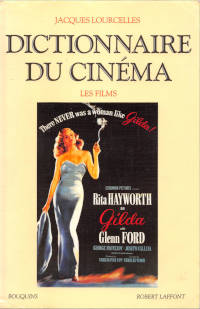
Title: Dictionnaire du cinéma — Les films - Collection Bouquins, Robert Laffont
Author: Jacques Lourcelles
Paperback: 1.725 pages
Publisher: Editions Robert Laffont S.A. (1992, 1995 - This edition: 1992)
Language: French
ISBN-10: 2-221-05465-2
ISBN-13: 978-2-221-05465-9
Product Dimensions: 19,6 x 4,9 x 13,3 cm
Very short excerpt (Original French)
1963-USA (112 min) • Production. MGM (Robert Wise) • Réalisation. Robert Wise • Scénario. Nelson Gidding d'après le roman "The Haunting of Hill House" de Shirley Jackson • Photographie. Davis Boulton (Panavision) • Musique. Humphrey Searle • Interprètes. Julie Harris (Eleanor Lance), Claire Bloom (Theodora), Richard Johnson (Dr. John Markway), Russ Tamblyn (Luke Sanderson), Loïs Maxwell (Grace Markway).
Pour tester le caractère hanté et démoniaque du manoir de Hill House en Nouvelle-Angleterre, le Dr. Markway y réunit trois personnes : l'héritier de la propriété, Luke Sanderson, jeune homme matérialiste, sceptique et même cynique, Eleanor, une mythomane refoulée qui se sent obscurément coupable de la mort de sa mère (qu'elle a longtemps soignée) et Theodora, une lesbienne aux puissantes qualités de médium. La maison, où ont eu lieu plusieurs morts violentes depuis sa construction, manifestera de plus en plus son emprise sur les habitants par toutes sortes de bruits divers, gémissements, grincements, frappements, etc. qui rendent l'atmosphère irrespirable. L'épouse du Dr. Markway rejoint les occupants. Eleanor, secrètement amoureuse du docteur suscite à la fois la jalousie de sa femme et la convoitise de Theodora. (Grace) Markway disparaît cependant qu'Eleanor tente de se suicider en se jetant du haut d'un escalier. La première sera retrouvée à demi folle et l'autre aura un accident de voiture mortel aux abords de la maison, dont la réputation sinistre est ainsi confirmée.
Récit fantastique magistral et puissamment original dans le genre, pour cette raison essentielle que la plupart des personnages y sont en eux-mêmes passionnants au point que plusieurs d'entre eux auraient pu donner lieu à un film particulier. Cette originalité est encore plus flagrante aujourd'hui puisque les héros du cinéma fantastique de ces dernières années n'ont cessé de régresser jusqu'à la débilité ou le non-être. Subissant à tout jamais, comme la plupart de ceux qui ont travaillé avec lui, l'influence de Val Lewton, Wise obtient les effets les plus efficaces en utilisant l'ellipse, le doute, l'incertitude. C'est surtout par le son, matière mystérieuse et impalpable, que la maison s'approprie ses occupants et que Wise hypnotise et terrifie le spectateur. "Grincements, craquements, chuchotement, ricanements, cris d'enfant, son ténu et grave d'une voix qui murmure, frôlements le long des portes, petits attouchements inquisiteurs ou bruits tonitruants qui ébranlent les fondations, la nuit : ce catalogue de la suggestion auditive, notent D. Grivel et R. Lacourbe dans leur livre sur Wise (Édilig, 1985), atteint une sorte de délire paroxystique." Cela n'empêche pas le film, à partir de certains motifs minutieusement répétés et variés (couloirs, portes, escalier de fer), de composer aussi une étonnante symphonie visuelle. Sur le plan dramatique, le récit reste volontairement ambivalent. Il progresse à la fois sur le mode objectif (description d'une expérience scientifique) et subjectif (point de vue d'Eleanor, dont la solitude, la nervosité, le sentiment de culpabilité, l'exaltation morbide ne vont cesser de s'intensifier au cours du film jusqu'à lui faire désirer d'être absorbée par la maison). Toute l'intrigue semble être aussi engendrée par son monologue intérieur. Wise se gardera bien de conclure et ne dira jamais si les événements extraordinaires (ou paranormaux) vécus par les personnages sont le fruit d'une action autonome de la maison ou de la sensibilité exacerbée et pathologique de certains de ses hôtes. La maison si bruyante restera muette, et notre curiosité à la fois rassasiée et insatisfaite. Si réaliser un film, ce n'est pas seulement exposer des faits, transmettre des idées ou un point de vue sur le monde, mais mettre le spectateur en condition de vivre par lui-même une véritable expérience, comme l'ont affirmé Mankiewicz, Preminger et plusieurs autres avec eux, alors, à cette aune et au vu de ce seul film, nul peut dénier à Wise la qualité de vrai et pur metteur en scène.
[This is a very short excerpt of the section related to The Haunting. Buy the book to read it in its full length]
Very short excerpt (English translation)
1963-USA (112 min) • Production. MGM (Robert Wise) • Direction. Robert Wise • Screenplay. Nelson Gidding after the novel "The Haunting of Hill House" by Shirley Jackson • Photography. Davis Boulton (Panavision) • Music. Humphrey Searle • Performers. Julie Harris (Eleanor Lance), Claire Bloom (Theodora), Richard Johnson (Dr. John Markway), Russ Tamblyn (Luke Sanderson), Lois Maxwell (Grace Markway).
To test the haunting and demonic nature of the Hill House mansion in New England, Dr. Markway brings together three people: the heir to the property, Luke Sanderson, a materialistic, skeptical and even cynical young man, Eleanor, a repressed mythomaniac who feels obscurely guilty about the death of her mother (whom she cared for a long time) and Theodora, a lesbian with powerful psychic qualities. The house, where several violent deaths have taken place since it was built, will increasingly manifest its hold on the inhabitants through all sorts of different noises, moans, squeaks, hits, etc., which make the atmosphere unbreathable. Dr. Markway's wife joins the occupants. Eleanor, secretly in love with the doctor, arouses both his wife's jealousy and Theodora's lust. (Grace) Markway disappears when Eleanor tries to commit suicide by throwing herself from the top of a staircase. The first is found half-crazy and the other is found in a fatal car accident on the outskirts of the house, thus confirming her sinister reputation.
A masterful fantasy tale and powerfully original in the genre, for the essential reason that most of the characters are so fascinating in themselves that several of them could have been the subject of a particular film. This originality is even more obvious today since the heroes of fantasy cinema in recent years have constantly regressed to the point of debility or non-being. Undergoing forever, like most of those who worked with him, the influence of Val Lewton, Wise obtains the most effective effects by using ellipsis, doubt, uncertainty. It is above all through sound, a mysterious and impalpable matter, that the house appropriates its occupants and that Wise hypnotizes and terrifies the spectator. "Squeaks, creaks, whispers, sneers, childlike cries, the faint, low-pitched sound of a whispering voice, rubbing along doors, small inquisitive touches or thunderous noises that shake the foundations, at night: this is a catalogue of auditory suggestion," D. notes. Grivel and R. Lacourbe in their book on Wise (Édilig, 1985), reaches a kind of paroxysmal delirium". This does not prevent the film, using certain meticulously repeated and varied motifs (corridors, doors, iron stairs), from also composing an astonishing visual symphony. Dramatically, the story remains deliberately ambivalent. It progresses both objectively (description of a scientific experiment) and subjectively (Eleanor's point of view, whose loneliness, nervousness, feelings of guilt and morbid exaltation will not cease to intensify over the course of the film until it makes her want to be absorbed by the house). The whole plot seems to be also generated by his inner monologue. Wise will be careful not to conclude and will never say whether the extraordinary (or paranormal) events experienced by the characters are the result of the autonomous action of the house or of the exacerbated and pathological sensitivity of some of its guests. The noisy house will remain silent, and our curiosity will be both satisfied and unsatisfied. If making a film is not only about presenting facts, conveying ideas or a point of view on the world, but also about enabling the viewer to live a real experience for himself, as Mankiewicz, Preminger and many others have said, then, by this yardstick and by the sight of this film alone, no one can deny Wise the quality of a true and pure director.
[This is a very short excerpt of the section related to The Haunting. Buy the book to read it in its full length]
'Maisons et Lieux hantés'

Title: Maisons et Lieux hantés
Author: Danielle Hemmert, Alex Roudène
Hardcover: 254 pages
Publisher: Editions Magellan (Janvier 1994)
Language: French
ISBN-10: 2-84121-007-3
ISBN-13: 978-2-84121-007-7
Product Dimensions: 20 x 13 x 3 cm
Very short excerpt (Original French)
Croyez-vous aux maisons hantées ? Pareille question est souvent posée. Mais il y a tant de cas divers de hantise ! Certaines maisons sont sous influence nocive du sous-sol et, jadis, Henry de France avait fait un classement que j'avais pu noter au vol au cours d'une de ses conférences. Il avait divisé en sept catégories ce cas de maisons hantées:
- Les enregistrements. Il avait remarqué que certaines maisons paraissaient garder une sorte d'imprégnation comparable à celle du disque d'un phonographe.
- Les hallucinations. Certaines histoires d'apparitions, et même de déplacements d'objets, auraient-elles pour origine une hallucination ?
- Où des intuitions peuvent provoquer l'hallucination. L'intuition peut être aussi la cause de la reconstitution d'un fait ancien et parfois sanglant.
- Les influences nocives du sous-sol. Les habitants de certaines maisons se plaignent d'insomnies et de maladies diverses qu'ils attribuent à des esprits méchants.
- Les phénomènes de bilocation. Un phénomène de bilocation peut être la cause de certaines hantises.
- Les médiums à effets physiques. Les maisons hantées dont on parle le plus sont celles où se produisent des phénomènes étranges. [...] Des jeunes filles et des jeunes hommes en état de formation sont doués de ces pouvoirs étranges qui en font de véritables médiums.
- Les manifestations de l'au-delà. Les manifestations de la septième catégorie sont vraisemblables car il est logique de croire à la survivance de l'esprit.
Very short excerpt (English translation)
Do you believe in haunted houses? Such a question is often asked. But there are so many different cases of haunting! Some houses are under the noxious influence of the underground, and Henry de France once made a classification that I was able to take note of during one of his lectures. He divided haunted houses into seven categories
- Recordings. He had noticed that certain houses seemed to retain a kind of impregnation comparable to that of a phonograph record.
- Hallucinations. Could certain stories about apparitions, and even the displacement of objects, be the result of hallucinations?
- Where intuitions can cause hallucinations. Intuition can also be the cause of the reconstruction of an ancient and sometimes bloody event.
- Harmful underground influences. The inhabitants of certain houses complain of insomnia and various illnesses that they attribute to evil spirits.
- Bilocation phenomena. A phenomenon of bilocation can be the cause of certain hauntings.
- Mediums with physical effects. The most talked-about haunted houses are those where strange phenomena occur. [...] Young women and men in their formative years are gifted with strange powers that make them veritable mediums.
- Manifestations from beyond. The manifestations in the seventh category are plausible because it is logical to believe in the survival of the spirit.
'Journal d'un chasseur de fantômes'
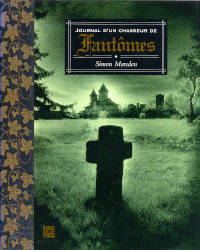
Title: Journal d'un chasseur de fantômes
Author: Simon Marsden
Hardcover: 128 pages
Publisher: Edition Abbeville, Paris (October 1995)
Language: French
ISBN-10: 2-87946-061-1
ISBN-13: 978-2-87946-061-1
Product Dimensions: 28,8 x 23 x 1,7 cm

Title: The Journal of a Ghosthunter
Author: Simon Marsden
Hardcover: 128 pages
Publisher: Little, Brown (October 1994)
Language: English
ISBN-10: 0-316-90989-0
ISBN-13: 978-0-316-90989-1
Product Dimensions: 28,4 x 22,6 x 1,8 cm
This original English book — "The Journal of a Ghosthunter" — was translated in French and published one year later as "Journal d'un chasseur de fantômes". It features a great collection of gorgeous black and white pictures of strange houses and peculiar places, where mysterious events took place, all descripted in a fascinating text. The pictures are very striking: their grainy look, mysterious halo of lights and perfect composition give the viewer a dream-like feeling. A superb arty book for the fans of the genre.
'Cinematic Hauntings', a must-have book for the fans
No family should be without one!
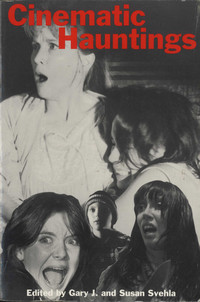
Title: Cinematic hauntings
Author: (Collective work)
Paperback: 320 pages
Publisher: Midnight Marquee PR Inc (June 1996)
Language: English
ISBN-10: 1-887664-05-X
ISBN-13: 978-1-887664-05-9
Product Dimensions: 9.2 x 6.2 x 1 inches; 2,5 x 15,9 x 23,5 cm
"Cinematic hauntings" is a book that every The Haunting fan should own.
Written by fans of the genre, the book explores 16 fantastic movies (including – of course – The Haunting) though 16 essays written by different writers, each devoted to a film.
Book Description from Amazon
Join us for a walk on the subtle side of horror as Cinematic Hauntings peers past the curtain of reality into Hollywood's vision of ghostly terror.
Films covered include:
Carnival of Souls, Curse of the Demon, High Plains Drifter, Lady in White, Legend of Hell House, Nomads, Outward Bound, Portrait of Jennie, Scrooge, Supernatural, The Changeling, The Haunting, The Innocents, The Shining and The Uninvited.
Book Review from Amazon
Intelligent, informative essays on several ghost films, May 11, 2006
The editors claim "ghost films have been too often overlooked by film historians critics." They intend to fill that gap in "the subtle side of horror" with this book. And it does, more so than not.
Cinematic Hauntings contains 16 essays by different writers, each devoted to one of the following films: Blithe Spirit, Carnival of Souls, The Changeling, Curse of the Demon, The Haunting, High Plains Drifter, The Innocents, Lady in White, Legend of Hell House, Nomads, Outward Bound, Portrait of Jenny, Scrooge (the 1951 version, later retitled A Christmas Carol), The Shining, Supernatural, and The Uninvited. Because I accept the editors' premise--the relative scarcity of text analyzing ghostly horror films--I question some selections.
If ghosts are spirits of deceased humans (or animals?) not all these films belong here. Some are a stretch. Is Carnival of Souls about a soul trapped between life and death, or a retelling of "An Occurrence At Owl Creek Bridge?" That can be good, demonstrating the resilient diversity of horror. But stretch a definition too far and the word loses meaning. Any way you slice it, Blithe Spirit is a comedy, and Curse of the Demon contains no ghosts.
Randy Palmer, who wrote the essay on the latter, anticipates this objection, writing: "Initially it may not seem that Curse of the Demon has a place in a book devoted to a study of cinematic hauntings, but in fact the film journeys beyond the metaphysical borders separating the physical and spiritual worlds, and many of its elements fit neatly into the category." He characterizes the film's shape-shifting cat, orb of fire, and demon as "ghostly manifestations of evil."
Well, no. These supernatural manifestations are not ghosts, even if they do look "ghostly." That said, Palmer's essay provides an excellent production history of both film and source material (Montague R. James's story, Casting the Runes), a detailed plot synopsis, and insightful commentary.
This format is followed by the other essays -- production and distribution history, synopsis, commentary -- with varying degrees of emphasis. I'm glad The Changeling is represented. Although little known, after The Haunting it is arguably the most effectively atmospheric English-language ghost film ever made. But instead of the 1951 Scrooge, I wish Tom Johnson had covered the 1970 version (which he dismisses). In its original release, I recall Scrooge ending up (temporarily) in Hell. That scene was later dropped (perhaps because it wasn't in Dickens's version) but I'd like to have learned its history.
Some entries need and deserve attention. Curse of the Demon deserves but does not need. I can understand not including Ghost (a romantic fantasy), but I wish Curse of the Demon and Blithe Spirit had been dropped in favor of Ghost Story and The Fog, both fitting candidates.
Caveats aside, Cinematic Hauntings is an attractive and informative trade paperback, generously illustrated with 115 stills, posters, lobby cards, and backstage photos. All entries include crew and cast lists. Two include endnotes. If the subject matter interests you, you'll want this book.
~ Thomas M. Sipos (Santa Monica, CA).
Very short excerpt
Ghost Cinema, like horse racing, has its own "triple crown." The first leg comes in the form of a truly haunting tale of love and hate from beyond the grave, The Uninvited (1944). The next big event in the apparitional arena is a terrifying study of repressed hysteria and supernatural possession, The Innocents (1961). But the undisputed jewel in the ghostly crown, the Kentucky Derby of spectral cinema, is Robert Wise's chilling masterpiece of understated terror, The Haunting.
"While I was at the studio doing post production on West Side Story (1961)," recalled producer/director Robert Wise in Midnight Marquee #37, "I read a review of [Shirley Jackson's novel,] The Haunting of Hill House in Time magazine. The review was so interesting that I went to a book store on Hollywood Boulevard and brought it back to the office to read. I was sitting on the couch in my office reading a sequence that really had me on the edge of my seat. Suddenly, Nelson Gidding, a writer from across the hall, burst into my office and I jumped about four feet in the air! I knew then this book had to be made into a film."
But Wise wasn't sure he'd be the one to make it. "I called nervously to see if it might be available," remembered the director in Bright Lights #11, "because usually by the time a book comes out in New York, the big movie companies have scouts back there, story departments, and they grab it up and it is gone." Happily, "I found out this one hadn't been picked up."
Wise intended to do The Haunting for United Artists, the studio for which he had just completed West Side Story (1961). "I persuaded United Artists to buy the book rights for me and finance a screenplay," the director told this author. (Unless otherwise cited, all quotes by Robert Wise are from a 1995 interview conducted by the author.) "And I got Nelson Gidding, who did I Want to Live! (1958) for me, to write the screenplay. When we got it done, however, for some reason or another United Artists got a little cold on it and didn't want to proceed with it. So I talked to my agent about it. I had left a contract with MGM a few years before; I got out of the contract early but I had to promise to give them another film. My agent suggested that maybe this could be the script that would fulfill that commitment. So we took it over to MGM."
There the project hit another snag when that celebrated studio balked at sinking big bucks into a horror picture. "They liked it very much," Wise recalled, "but they didn't want to put over a million dollars into it because of the material and the fact that we wouldn't be using big name stars. And the best budget I could get out of MGM Culver City here was one million, four hundred thousand" (nearly half - again what the studio was willing to spend).
Fortunately, fate took a hand. "I was about to go over to London for a command performance of West Side Story," recounted Wise, "and somebody said 'well, you know MGM has a studio outside of London [Boreham Wood Studios], and maybe they could get you a better budget on the script over there than Culver City.' So I took it along with me when I went to London and gave it to the people at the studio. They liked the idea and came back with a budget of a million, fifty thousand. And so that's why we made it over there, as what we call a 'runaway production' - 'runaway' because I could do it cheaper there."
Though shot in England with mostly English actors, Wise retained the story's American setting. "I was insistent on keeping the New England background," explained the director in Fangoria #44, "because Shirley Jackson is a New Englander and wrote in that area. I felt that this kind of story, with an old haunted house, would be fresher material set in America, in New England, than it would in Great Britain, because England abounds in haunted houses. Even though we shot in London, we kept the New England setting without too much trouble." Wise later added that it was no more difficult to transform Olde England into New England than having to "block off the road for a mile or two so I could have [Julie Harris] driving on the right side - that kind of thing. It was very simple, wasn't hard at all."
With the financial difficulties solved, Wise could turn to other problems. "We didn't like that title [The Haunting of Hill House]," the director stated in Fantastic Films, vol. 2, no. 4. "When I say 'we,' that particularly means me and Nelson Gidding, who did the screenplay. It seemed cumbersome, and the book had not done that well. Jackson is a marvelous writer, but her books were never tremendous sellers, they got most of their acclaim from the critics. We always felt that maybe there was a better title somewhere, and actually, she gave it to us. We had some questions about the story and her intent. Since she lived back in Vermont where her husband was a professor at Bennington, we made arrangements to fly back one weekend and meet with her. We wanted to talk about some things in her story, to get some clarifications on what her intentions were. We had lunch with her that day and during the course of it we asked her if she'd ever had any other title for it. She said, 'Well, I really hadn't. The only title I really ever seriously considered was The Haunting of Hill House. But the other one I had thought of for a while was just The Haunting.' It was in front of us all the time, but we never saw it. She is the one who gave us that."
Wise next had to find a cast. He ultimately chose one made up of primarily classically-trained and well-respected stars of the stage, including Richard Johnson and Claire Bloom (two British Shakespearean actors), and Julie Harris (an American Broadway star). To round out his leading quartet, Wise chose a young man with whom he had worked on West Side Story (1961). But, Russ Tamblyn initially wasn't interested. "You know, I actually turned The Haunting down the first time it was offered to me," the actor declared in Filmfax #27. "I was living in Paris and Robert Wise, who was in England, sent me the script to read. I thought all the other parts were great but, at that time - and don't ask me why - I didn't like the part that I had in it. I didn't like it at all for some reason, maybe just stupidity. I sent a note back to him 'Thank you very much, but no thanks.' Then I flew back to Los Angeles. I thought that Wise was just offering me the role, no big deal. But when I got back to L. A., once again my agent said, 'The studio called and said if you don't do that film, The Haunting, you'll go back on suspension.' Since I really didn't want to go months and months without getting paid, I jumped on a plane for England and did the picture. Of course, now I look back on it, and it is one of my favorite films."
Almost as important as finding the right actors was locating the proper setting for the film's biggest 'star' - Hill House itself. "We wanted a house that basically had an evil look about it," explained Robert Wise in Fantastic Films. "Since the film was going to be shot in England, we looked far and wide to find the right house. There are a lot of manor houses and old places in England, but one after the other did not fit our requirements. Finally, we found one [in Warwickshire] about ten miles down from Stratford-on-Avon. It was an old manor house [named Ettington Park], about two hundred years old, and it was being used as a country hotel." Wise felt that its "facing of mottled stone with gothic windows and turrets" were just what the spiritualist ordered.
[This is a very short excerpt of the section related to The Haunting. Buy the book to read it in its full length]
'The BFI Companion to Horror'
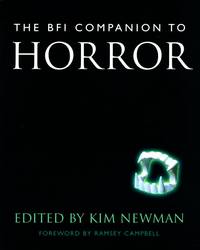
Title: The BFI Companion to Horror [BFI stands for the British Film Institute]
Author: Kim Newman (edited by)
Paperback: 352 pages
Publisher: Continuum (formerly Cassell Academic) (December 1996)
Language: English
ISBN-10: 0-304-33216-X
ISBN-13: 978-0-304-33216-8
Product Dimensions: 22,2 x 2,5 x 27,9 cm
Unfortunately — for me that is — "The Haunting" is barely present in the book. Despite the numerous films that are reviewed, there is no entry for "The Haunting", only a few lines in "The Ghost Story", "Shirley Jackson" and "Robert Wise" entries.
Book Review from Amazon
Focusing primarily on the cinema, but encompassing literature, television, radio, popular music, history and folklore, this text provides a secret history of the horror genre from its pre-cinema beginnings in the 18th-century gothic novel and the Victorian ghost story through 100 years of film. In addition to entries on actors, directors, writers, technicians, entries on horror-themed films and television series, the book provides essays on classic horror characters like Frankenstein and Dracula, and on recurrent situations like decapitation and body-snatching.
Very short excerpt
Page 134 — The Ghost Story
The ghost story is notoriously difficult to bring off at novel length: Shirley Jackson's "The haunting of Hill House" (filmed as "The Haunting", 1963), where the psychological make-up of the characters and the inexplicable nature of the phenomenon are the whole plot, is a notable exception.
Page 169 — Shirley Jackson
American writer. Though her slim œuvre is remarkable for consistent, quiet brilliance, Jackson retains a genre profile on the strength of "The Lottery" (1945), a perfect conte cruel (adapted on Robert Herridge Theatre, 1961), and "The Haunting of Hill House" (1959), a ghost story (filmed as "The Haunting", 1963). The typical Jackson protagonist is a middle-aged woman persecuted by insecurities which spiral into the horrific or the supernatural. "The Bird's Nest" (1954), a psychological study filmed as "Lizzie" (1957), and "We have always lived in the Castle" (1962) are ambitious and strange.
Page 341 — Robert Wise
He returned to horror with "The Haunting" (1963), from Shirley Jackson's "The Haunting of Hill House" (1963), which strains slightly to provide psychological rationale for truly terrifying manifestations.
[Note from Laurent. That's really too short and incorrect: Shirley Jackson's novel was published in 1959, not in 1963]
'unInvited'
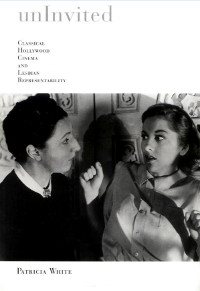
Title: unInvited: Classical Hollywood Cinema and Lesbian Representability
Author: Patricia White
Paperback: 396 pages
Publisher: Indiana University Press (October 1999)
Language: English
ISBN-10: 0-253-21345-2
ISBN-13: 978-0-253-21345-7
Product Dimensions: 6.1 x 0.8 x 9.2 inches; 15,5 x 2 x 23,4 cm
Editorial reviews
Uncovering a massive trove of what she calls "lesbian representability" images of lesbian desire, love and life in mainstream movies, White provides an insightful look at classic American films. While some of the images and situations she cites are relatively obvious, as in A Member of the Wedding (1952), in which Julie Harris plays the tomboy Frankie Addams, many are more coded, as in Alfred Hitchcock's Rebecca (1940) or All This and Heaven Too with Bette Davis (1940). Ranging across an impressive span of films, White proves as conversant with the little-known ghost story The Uninvited (1944) as she is with the more famous (and openly lesbian) The Killing of Sister George (1969) or All About Eve (1944). While some readers may greet White's revelations of lesbian images in so many mainstream films with suspicion or weariness, her myriad examples and finely wrought arguments prove both convincing and engaging. She is at her most provocative when discussing lesbian innuendoes in the performances (and careers) of such leading lady sidekicks as Ethel Waters, Agnes Moorehead and Thelma Ritter. Grounding her analysis in feminist film theory, White expects her readers to have some knowledge of the works of Mary Ann Doan, Teresa De Lauretis and Annette Kuhn, although she is careful to explain their often complicated theories in accessible prose. ~ From Publishers Weekly, Copyright 1999 Reed Business Information, Inc.
White (Swarthmore College) seeks traces of lesbian desire and difference in the films of the classic era. Since the Production Code forbade even the slightest hint of sexual deviancy, White must engage in a great deal of what she calls retrospectatorship, with somewhat mixed results. She begins by discussing the Code itself; moves on to a discussion of star personae (e.g., Davis, Hepburn, Dietrich, Garbo), the gothic/horror film and maternal melodrama, overt lesbian overtones among supporting players such as McDaniel, Waters, Fitter, McCambridge, and — especially — Moorehead; and closes with a chapter on retrospectatorship. She draws on all of the major figures in feminist film theory, if only to chastise them for ignoring the lesbian spectator. Since White covers much of the same ground that Mary Ann Doane does in The Desire to Desire: The Woman's Films of the 1940s (CH, Oct'87), she is particularly concerned with correcting Doane's omissions. White writes with considerable flair, and her arguments are always interesting, if not always fully convincing. A useful addition to studies of spectatorship in and of the classic era. Upper-division undergraduates through professionals. ~ W. A. Vincent, Michigan State University, Choice, July 2000.
Very short excerpt
What have been considered the very best of "serious" Hollywood ghost movies — Curse of the Cat People (1944), The Uninvited (1944), The Innocents (1961), and Robert Wise's 1963 horror classic The Haunting to name a few, are also, by some uncanny coincidence, films with eerie lesbian overtones. Masquerading as family romance, these films unleash an excess of female sexuality which cannot be contained without recourse to the supernatural. To be more explicit, in the case of The Haunting, female homosexuality is manifested in the character of Claire Bloom. Regrettably though perhaps understandably eclipsed by two films Wise directed just before and after The Haunting, namely West Side Story and The Sound of Music, the film will maintain its place in cinematic history for two reasons. First, it is one of the few Hollywood films that has a lesbian character. Claire Bloom appears as what is perhaps the least objectionable of sapphic stereotypes — the beautiful, sophisticated, and above all predatory lesbian. Although not herself a fashion designer, her wardrobe is by Mary Quant; she has ESP, and she shares top billing with Julie Harris, a star who from her film debut in The Member of the Wedding through her incongruous casting as James Dean's love interest in East of Eden, to her one-woman-show as The Belle of Amherst, has insistently been coded eccentric. The second reason for which The Haunting is remembered is its effectiveness as a horror film. Like its source, Shirley Jackson's The Haunting of Hill House, the movie is adept in achieving in the spectator what Dorothy Parker on the book jacket calls "quiet, cumulative shudders." At least one reliable source pronounces The Haunting "undoubtedly the scariest ghost movie ever made." It is clear that reason number two is related to reason number one — for The Haunting is one of the screen's most spine-tingling representations of the disruptive force of lesbian desire.
Though the alliance of horror with lesbianism may leave one uneasy, it should be pointed out that the horror genre has been claimed by film criticism as a "progressive" one on several grounds. Concerned with the problem of the normal, it activates the abnormal in the "threat" or the figure of the monster. Linda Williams has noted a potentially empowering affinity between the woman and the monster in classic horror films, without exploring the trope of the monster as lesbian. The omission of any mention of lesbian desire is all the more striking given her thesis: it is a truism of the horror genre that sexual interest resides most often in the monster and not the bland ostensible heroes," or, "clearly the monster's power is one of sexual difference from the normal male."
The horror genre manipulates codes specific to the cinema — camera angles that warp the legibility of the image and the object of the gaze; framing that evokes the terror of what-lies-beyond the frame; sound effects that are not diegetically motivated; unexplained point-of-view shots that align the spectator with the monster — for effect and affect.
In The Haunting the two female leads, both "touched by the supernatural" (as it were), are invited to take part in a psychic experiment in a haunted New England mansion. As explicitly deviant women, they are asked to bear witness to an other power, an alternative reality They join their host Dr. Markway (Richard Johnson), the pompous anthropologist turned ghost-buster, and the wisecracking future heir to the house, Luke (Russ Tamblyn), who is skeptical of any unusual "goings-on". A truly terrifying sojourn with the supernatural at Hill House leaves the Julie Harris character dead due to unnatural causes and the spectator thoroughly shaken.
[This is a very short excerpt of the section related to The Haunting. Buy the book to read it in its full length]
My notes from the book
I've recently found these notes probably taken more than 15 years ago...
What defines a horror movie?
- Some unexplained point of view shots — for instance, when The House is observing Eleanor's car approaching the main entrance of the house.
- The music — that is especially true for The Haunting.
- An eerie feeling — the viewer feels uneasy about something not quite right in the seemingly normally depicted reality.
- A voice-over — providing a terrifying access to Eleanor's interiority.
- Unusual camera moves — the camera is giving the perspective of somebody else, but who?
What does make The Haunting so special?
It is precisely because we do not see any ghost, with hardly a few basic special effects, that makes The Haunting the ultimate ghost movie.
Who is knocking?
- Abigail desperately calls for help while she's dying: she knocks on a wall with a wooden cane.
- Eleanor's mother used to knock on the wall to get immediate assistance. Eleanor did not answer the last time.
- But then who is knocking on the door in Theo's bedroom? Who is calling for help? Who is about to die?
Who is falling?
- The paid companion threw herself from the spiral staircase of the library.
- Something, someone in the tower is also trying to push Eleanor from the balcony
'Le cinéma fantastique'
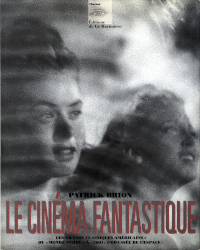
Title: Le cinéma fantastique
Author: Patrick Brion
Hardcover: 368 pages
Publisher: Editions de La Martinière (January 2000)
Language: French
ISBN-10: 2-7324-2094-8
ISBN-13: 978-2-7324-2094-3
Product Dimensions: 31,9 x 26,8 x 3 cm
Probably one of the most beautiful arty French books on the topic. Among my very favourite. It might be difficult to find today but I strongly encourage you to keep trying.
Very short excerpt (Original French)
Hill House, une inquiétante demeure de la Nouvelle Angleterre. Son passé est marqué par une succession de catastrophes. Son ancien possesseur était Hugh Crain. Sa première femme était morte dans un accident d'attelage, laissant une petite fille, Abigail. Sa seconde femme s'était tuée en faisant une chute. Hugh, parti en Angleterre, s'était noyé. Abigail, devenue une vieille dame, était morte dans son lit. Sa demoiselle de compagnie s'était pendue. Mrs. Sannerson a hérité de la demeure.
Le docteur Markway est décidé à percer le secret de la demeure. Il convoque pour l'aider Eleanor qui a eu une expérience de poltergeist, Theodora qui possède des possibilités extra-sensorielles exceptionnelles et bénéficie également de la présence de Luke Sannerson qui doit hériter de la demeure. Celle-ci commence aussitôt à réagir et à se manifester. Markway découvre au coeur du castel la présence d'une véritable chambre froide. Eleanor est obsédée par la mort de sa mère, s'étant persuadée qu'elle n'avait pas été assez dévouée avec elle. Eleanor accuse Theodora qui a des tendances saphiques d'être "un monstre de la nature". Grace Markway, la femme du docteur Markway, arrive à son tour. La maison se déchaîne et semble respirer sous une mystérieuse force. Grace disparaît. Markway sauve Eleanor qui allait tomber du haut de l'escalier en métal. Les quatre visiteurs décident de partir, Markway étant parvenu à convaincre Eleanor de l'urgence. Eleanor part en voiture. Elle perd le contrôle de sa voiture après avoir vu Grace et meurt dans l'accident. Markway retrouve sa femme. Le castel a eu sa proie.
Cette rigueur de la mise en scène, renforcée par le fait que le film ait été tourné en noir et blanc, donne à La Maison du Diable une terrifiante efficacité. Il est en effet vite évident que Hill House, qui a été construite avec des portes décentrées et sans aucun angle droit - uniquement des angles aigus ou obtus -, est une demeure habitée. "La maison est vivante", avoue d'ailleurs Eleanor à Theodora, et le moment où l'on voit l'une des portes haleter, comme si la maison respirait réellement, est superbe. Alors que certains fins voient in extremis s'échafauder une solution rassurante, La Maison du Diable frappe par sa dureté : Hill House est bien une maison en proie aux forces démoniaques. La présence d'une "chambre froide", le rôle presque symbolique de l'escalier métallique qui semble refléter l'esprit tortueux de certains des habitants de la maison et des protagonistes de l'intrigue et l'atmosphère de plus en plus oppressante de la demeure contribuent à l'impression de malaise que procure le film. Parallèlement, Robert Wise décrit avec précision les rapports ambigus qui s'instaurent entre Eleanor et Theodora, jouant sur le fait que cette dernière est visiblement lesbienne. L'interprétation de Claire Bloom est d'ailleurs l'une des grandes qualités de ce fil m trouble et inquiétant dans lequel les forces du mal apparaissent dans toute leur puissance, ne laissant aux humains qui tentent de les contrarier qu'une unique solution : la fuite la plus rapide et la plus éperdue...
NOTE : Le film a été tourné en Angleterre, en extérieurs à Ettington Hall [Ettington Park], près de Stratford-upon-Avon.
[This is a very short excerpt of the book. Buy it to read it in its full length]
Very short excerpt (English translation)
Hill House, a frightening New England home. Its past is marked by a succession of disasters. Its former owner was Hugh Crain. His first wife had died in a driving accident, leaving a little girl, Abigail. His second wife was killed in a fall. Hugh had gone to England and drowned. Abigail, now an old lady, had died in her bed. His lady companion had hanged herself. Mrs. Sannerson inherited the house.
Dr. Markway is determined to unlock the secret of the house. To help him, he summoned Eleanor, who had an experience as a poltergeist, Theodora, who possesses exceptional extra-sensory possibilities and also benefits from the presence of Luke Sannerson, who is to inherit the house. The house immediately begins to react and manifest itself. Markway discovers in the heart of the castel (Hill House) the presence of a real cold room. Eleanor is obsessed by her mother's death, having convinced herself that she had not been devoted enough to her. Eleanor accuses Theodora, who has saphic tendencies, of being "a monster of nature". Dr. Markway's wife, Grace Markway, arrives in turn. The house goes wild and seems to breathe under a mysterious force. Grace disappears. Markway saves Eleanor who was about to fall from the top of the metal staircase. The four visitors decide to leave, Markway having managed to convince Eleanor of the urgency. Eleanor leaves by car. She loses control of her car after seeing Grace and dies in the accident. Markway finds his wife. The castel (Hill House) has had its prey.
This rigour of the staging, reinforced by the fact that the film was shot in black and white, gives La Maison du Diable [The Haunting] a terrifying efficiency. Indeed, it soon becomes clear that Hill House, which was built with off-centre doors and without any right angles - only acute or obtuse angles - is an inhabited dwelling. "The house is alive," Eleanor told Theodora, and the moment you see one of the doors gasping, as if the house is actually breathing, is superb. While some endings see in extremis a reassuring solution, La Maison du Diable [The Haunting] strikes by its harshness: Hill House is indeed a house prey to demonic forces. The presence of a "cold room", the almost symbolic role of the metal staircase that seems to reflect the tortuous spirit of some of the inhabitants of the house and the protagonists of the plot, and the increasingly oppressive atmosphere of the house all contribute to the impression of unease that the film gives. At the same time, Robert Wise accurately describes the ambiguous relationship between Eleanor and Theodora, playing on the fact that the latter is visibly lesbian. Claire Bloom's interpretation is one of the great qualities of this troubled and disturbing film in which the forces of evil appear in all their power, leaving the humans who try to thwart them with only one solution: the fastest and most desperate escape...
NOTE: The film was shot in England, on location at Ettington Hall [Ettington Park], near Stratford-upon-Avon.
[This is a very short excerpt of the book. Buy it to read it in its full length]
'Bloom's Major short stories writers - Shirley Jackson'

Title: Bloom's Major short stories writers - Shirley Jackson
Author: Harold Bloom
Hardcover: 83 pages
Publisher: Chelsea House Publications (March 2001)
Language: English
ISBN-10: 0-7910-5948-0
ISBN-13: 978-0-7910-5948-7
Product Dimensions: 6.3 x 0.6 x 9.3 inches; 16 x 1,5 x 23,5 cm
Some readers complained on Amazon that the full title "Comprehensive research and study guide — Bloom's major short story writers — Shirley Jackson." was somehow misleading. The book comments only a few works of Shirley Jackson, namely: "Charles", "The lottery" and "The Haunting of Hill House". Each section contains: a plot summary / the list of characters / some critical views (from other authors, who are quoted). So, the contribution of the author to his own book is very limited.
I've read only the section dedicated to "The Haunting of Hill House" so my comments cannot provide a comprehensive feedback about the book in general.
I had my first doubts when the author wrote that "The Haunting of Hill House" was a short novel. Maybe this is to justify the inclusion of the novel is a book supposedly dedicated to short stories?
Then the author gives the full name of Theodora: Theodora Vane. Well, no, I'm sorry. I've double checked the .epub of the novel, just to be absolutely sure. The word "Vane" is not even in the book. Theodora has no family name in the book and the movie. Period. This error appears several times: once in the plot summary, once in characters list and finally in the index.
Then other incongruities such as a breakfast in the kitchen, the girls descending into the basement, the suggestion that the nursery might be on the ground floor, etc, etc.
All in all, compared to all the other books written on the subject, this one is really of inferior quality. The very fact that the plot summary contains obvious and monstrous errors discredits the whole section dedicated to the novel.
'Le nouveau guide des films'
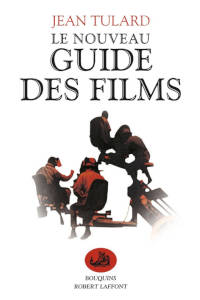
Title: Le nouveau guide des films - Collection Bouquins, Robert Laffont
Author: Jean Tulard
Ebook: 9.658 pages
Publisher: Editions Robert Laffont S.A. (1990, 1991, 1995, 1997, 2002 - This edition: 2005)
Language: French
ISBN-10: 2-221-12486-3
ISBN-13: 978-2-221-12486-4
Very short excerpt (Original French)
MAISON DU DIABLE (LA)
(The Haunting ; GB, 1963.) Réalisation : Robert Wise ; Scénario : Nelson Gidding ; Photographie : David Boulton ; Musique : H. Searle ; Production : Wise/MGM ; Interprètes : Richard Johnson (Pr Markway), Julie Harris (Eleanor), Claire Bloom (Theodora), Russ Tamblyn (Luke), Loïs Maxwell.
Scope-Noir et Blanc, 115 min.
Le Pr Markway qui effectue des recherches dans le domaine de la parapsychologie, tente une expérience de perception extrasensorielle avec un groupe de personnes réunies dans un vieux manoir réputé hanté. Dès le départ, chaque nuit, des bruits insolites terrorisent les habitants de la demeure. Comprenant que l’une des femmes du groupe, Eleanor, est au bord de la dépression, Markway l’oblige à partir. Celle-ci ne veut pas, prétextant que c’est… la maison qui la retient. Eleanor se tuera accidentellement alors qu’elle voulait fuir le groupe des humains.
Œuvre fascinante et effrayante, The Hauting mérite le terme pourtant galvaudé de chef-d’œuvre. Rarement dans l’histoire du fantastique, la peur aura eu un visage aussi présent que réel et, paradoxalement, aussi invisible que polymorphe. Robert Wise s’est attaché à faire une description infaillible de cette approche empirique du mal et nous laisse, à la fin du film, devant un trou béant causé par le refus de conclure de quelque manière que ce soit. Et cette fin, après cent quinze minutes d’errance dans les décors splendidement baroques et maléfiques de la demeure, cette fin est la conclusion la plus cauchemardesque que l’on pouvait donner à cette œuvre adulte.
[This is a very short excerpt of the section related to The Haunting. Buy the book to read it in its full length]
Very short excerpt (English translation)
MAISON DU DIABLE (LA) [THE HAUNTING]
(The Haunting; GB, 1963.) Director: Robert Wise; Script: Nelson Gidding; Photographer: David Boulton; Music: H. Searle; Production: Wise/MGM; Performers : Richard Johnson (Professor Markway), Julie Harris (Eleanor), Claire Bloom (Theodora), Russ Tamblyn (Luke), Lois Maxwell.
Scope-Black and White, 115 min.
Prof. Markway, a parapsychology researcher, attempts an experiment in extrasensory perception with a group of people gathered in an old haunted mansion. From the outset, every night, unusual noises terrorize the inhabitants of the mansion. Understanding that one of the women in the group, Eleanor, is on the verge of depression, Markway forces her to leave. She doesn't want to, claiming that it is... the house that is holding her back. Eleanor accidentally kills herself as she tries to flee the group of humans.
Fascinating and frightening work, The Hauting deserves the overused term of masterpiece. Rarely in the history of fantasy has fear had a face as present as it is real and, paradoxically, as invisible as it is polymorphous. Robert Wise has endeavoured to make an infallible description of this empirical approach to evil and leaves us, at the end of the film, with a gaping hole caused by the refusal to conclude in any way. And this ending — after a hundred and fifteen minutes of wandering through the splendidly baroque and evil settings of the house — this ending is the most nightmarish conclusion one could give to this mature work.
[This is a very short excerpt of the section related to The Haunting. Buy the book to read it in its full length]
'Robert Wise on his Films'
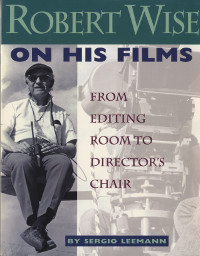
Title: Robert Wise on his Films - From editing room to director's chair
Author: Sergio Leemann
Paperback: 223 pages
Publisher: Silman-James Press (August 2006)
Language: English
ISBN-10: 1-879505-24-X
ISBN-13: 978-1-879505-24-7
Product Dimensions: 8.6 x 0.5 x 11 inches; 22 x 1,2 x 28 cm
Very short excerpt
Robert Wise created his own production company ("Argyle", first known as "B&P"), and began negotiating his deals with the studios on a film-per-film basis.
Instigated by a favourable review of Shirley Jackson's disturbing ghost story "The Haunting of Hill House", Wise purchased a copy of the book and set about reading it at the Goldwyn Studios, where he was preparing "West Side Story". As he recalls: "I was reading one of the very scary passages - hackles were going up and down my neck - when Nelson Gidding, who was working in the office next door to mine, burst through the door to ask me a question. I literally jumped about three feet out of my chair. I said, 'If it can do that to me sitting and reading, it ought to be something I want to make a picture out of' ". Gigging wrote the screenplay and Wise tried to activate the project when he finished "West Side Story", but the Mirisch company had lost interested in it. MGM picked up the project and "The Haunting" was released in 1963. It was a commercial failure, but slowly began to attract a following and is regarded today as one of the key titles in the haunted-house genre.
The story's setting is Hill House, a New England mansion with a history of macabre happenings. A group of psychic researchers gather to study the place, and one of its members, Eleanor, played by Julie Harris, falls prey to its spell. "The Haunting" stresses the psychological aspect of the story, maintaining a basic ambiguity as to how much is real and how much is a product of Eleanor's imagination. In his first chiller since his beginnings as a director under Val Lewton's tutelage, Wise applies his old mentor's theory that if seen things are scary, unseen things are scarier, and extracts truly frightening moments by merely implying terror through the inspired use of the sound and the sense black-and-white photography. Wise believes that a director "can go farther in terms of style in stories of the supernatural. A film like "The Haunting" is a lot of fun to make because you can do so much with offbeat photography and the use of sound and music. Val always said that the greatest fear that people have is the fear of the unknown. Unlike so many films that are made now which try to scare by showing the most monstrous things you can possibly think, "The Haunting" frightens the viewer by just suggesting them."
I liked Shirley Jackson's book very much and was disappointed when United Artists, who had bought it for me, got a little cold on it and put it in turnaround. I was talking about it with my agent, and he reminded me that when I settled my contract with MGM in 1957, they made me promise that I would give them another picture down the line. I got the screenplay over to them when I was shooting "Two for the Seesaw". They liked it and wanted to do it but would only spend a million dollars on it. We had their production department do a breakdown, and the best figure they could come up with was $1,400,000. Then somebody told me about the MGM studio in Borehamwood, outside of London; maybe they could do it for a better price in England. I met the fellows at the studio and they came back with a schedule that I could live with and a budget that came in at $1,050,000. That's how it turned out that the picture was entirely made in England. Still, I kept the New England background of the original story because I felt that the haunting of the house was fresher in the American scene.
Regrettably, "The Haunting" was my last black-and-white film and I loved the look and style of it. All the interiors were designed by Elliot Scott and built on the Borehamwood lot. The exterior was a several-hundred-years-old manor house out in the country, about ten miles from Straftford-upon-Avon. It was a pretty horrifying-looking thing under certain kinds of lights, and I accentuated that by shooting some of the exteriors with infra-red film. I shot the film in Panavision and, at that time, there wasn't any wide-angle lens in anamorphic. The widest was maybe a 40mm. I wanted to make those hallways look long and dark and dank. I called the president of Panavision, Bob Gottschalk, and asked, "Don't you have any wider-angle lens? I really want to get an almost unreal feeling about this house". He said, "We have developed a 30mm, but it's not ready for use. It's got a lot of distortion in it". I said, "That's exactly what I need for certain places - I wanted the house to look almost alive". He didn't want to let me have it. I kept insisting and he finally relented on the proviso that I understood that it was not a finished lens and had distortions in it. I had to sign a document saying that I was willing to accept the extra amount of distortion and would never go back to Panavision and complain about it. I used it most effectively in just certain shots.
"The spiral staircase in the library was such an effective prop in the picture. It was scary when you were up on that thing and it was rocking around. The one shot we did on it that fascinates people the most is when the camera is at the bottom and goes up. We designed the banister of the stairway to be so wide and thick that it would fit a small rig with wheels on it - a little, light dolly that would hold a hand-held camera. We had our camera on that and we had a control wire underneath, all the way down. We simply took the camera up on the top of this rig, started it, rolled it down, and then reversed the film. It was all done on that balustrade. Another simple effect was the door that buckles. The door was all laminated wood, layers of wood on top of others. All I had was a strong prop man on the other side who would push it and move it. That's all it was and it scared the hell out of everybody.
"It's obvious in the story and what we put on the screen that Claire Bloom's character is a lesbian. We originally had a scene at the beginning with Claire in the bedroom of her apartment, and she's angry and yelling out the windows at somebody. Then she goes and writes with lipstick on the mirror, "I hate you". I guess we caught a glimpse of the person in the car, showing it was a woman. Anyway, we established that this was a love affair with another woman. We thought that labelled it too heavily and hurt the scene, so we dropped it. It was better to let see it develop when Julie Harris turns to her in the scene out on the terrace and refers to her as being unnatural".
[This is a very short excerpt of the section related to The Haunting. Buy the book to read it in its full length]
'La France hantée : Voyage d'un chasseur de fantômes'
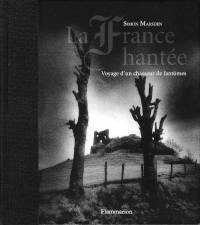
Title: La France hantée : Voyage d'un chasseur de fantômes
Author: Simon Marsden
Hardcover: 191 pages
Publisher: Flammarion (October 2006)
Language: French
ISBN-10: 2-08-011409-3
ISBN-13: 978-2-08-011409-9
Product Dimensions: 29 x 2,5 x 26 cm

Title: The Journal of a Ghosthunter
Author: Simon Marsden
Hardcover: 192 pages
Publisher: Flammarion (September 2012)
Language: English
ISBN-10: 2-08-020125-5
ISBN-13: 978-2-08-020125-6
Product Dimensions: 25,9 x 2,2 x 28,9 cm
Another superb arty book from Simon Marsden, this time focussing on France.
'The films of Robert Wise'

Title: The films of Robert Wise
Author: Richard C. Keenan
Paperback: 240 pages
Publisher: Scarecrow Press (August 2007)
Language: English
ISBN-10: 0-8108-5885-1
ISBN-13: 978-0-8108-5885-5
Product Dimensions: 6.1 x 0.6 x 9 inches; 15,5 x 1,5 x 23 cm
Book Description from Amazon
From his early days as a film editor at RKO studios, where he helped Orson Welles shape Citizen Kane, to his success as a director and producer of musical blockbusters of the 1960s, Robert Wise had a long and illustrious film career. Unlike contemporaries such as Alfred Hitchcock, John Ford or Howard Hawks, however, Wise's films lack any clearly discernible characteristics to signify his work. There are few striking camera angles or visual flourishes that might distract from the primary obligation to present the story. And like Hawks, Wise never specialized in one or two genres, but brought his directing skills to all manner of films. His work as a director resists auteur categorization, and that is a chief reason why some critics have been unduly negative in their consideration of his work.
In The Films of Robert Wise, Richard Keenan examines the nearly forty features that represent the director's career — from Curse of the Cat People (1944) to A Storm in Summer (2001), the only television production Wise ever directed. Keenan offers a reappraisal of Wise's films so that the true quality of his work can be better appreciated. Keenan argues that if there was a flaw in Robert Wise as a director, it was that he lacked the ego and temperament of the artist, which was not necessarily a flaw at all. Indeed, Wise was a conscientious craftsman who saw his work not primarily as a vehicle for his own ideas and visual style, but as an opportunity to present narrative that — quite simply — engages, informs, and entertains. It was this perspective that helped produce a number of memorable films over the years, including the gritty noir Born to Kill, the one-two punch of The Set-Up and Somebody Up There Likes Me, the sci-fi prophecy The Day the Earth Stood Still, and the gripping indictment of capital punishment, I Want to Live! — classics all. Wise also won a pair of Oscars for two of the most memorable — not to mention successful — musicals of all time: West Side Story and The Sound of Music.
Drawing on more than 30 hours of interviews with Wise — as well as additional interviews with a number of his collaborators — Keenan offers a welcome reassessment of the director's work. In his analysis of each film, Keenan reveals both Wise the craftsman and the artist. In doing so, The Films of Robert Wise finally confers upon this underappreciated director the recognition he deserves.
Editorial reviews
The author is generally evenhanded in granting measured attention to each of Wise's films. We are lucky to have now a critical study of the films of Robert Wise, but even luckier that The Films of Robert Wise is so persuasive and thoughtful. ~ Peter Tonguette, Film International
Robert Wise (1914-2005) was an American film director and producer best known for such works as The Day the Earth Stood Still, West Side Story, The Sound of Music, and The Sand Pebbles. This book by Keenan (English and modern languages, U. of Maryland) is an appreciative discussion of the value and merit of Wise's filmic craftsmanship that discusses the 40 movies Wise produced or directed. It draws on many interviews with Wise, as well as first-hand observation of Wise's working methods on the set of Star Trek: the Movie. One of those interviews is include in an appendix, together with a bibliography and a filmography. ~ Reference and Research Book News, November 2007.
This book was many years in the making, and involves over thirty hours of interviews and countless correspondence with Wise and others associated with these productions. ~ Film Quarterly.
'British Horror Film Locations'
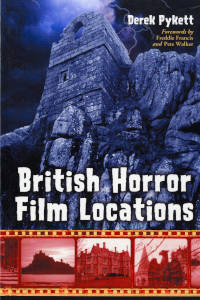
Title: British Horror Film Locations
Author: Derek Pykett
Paperback: 216 pages
Publisher: McFarland (August 2008)
Language: English
ISBN-10: 0-7864-3329-9
ISBN-13: 978-0-7864-3329-2
Product Dimensions: 15,2 x 1,3 x 22,2 cm
This book is a delight for fans of horror films. It provides numerous details and pictures about the actual places where these British films were shot. Of course, it features "The Haunting", "The Watcher in the Wood" (also shot at Ettington Park) and in the "Locations" section, a whole page devoted to Ettington Park.
Very short excerpt
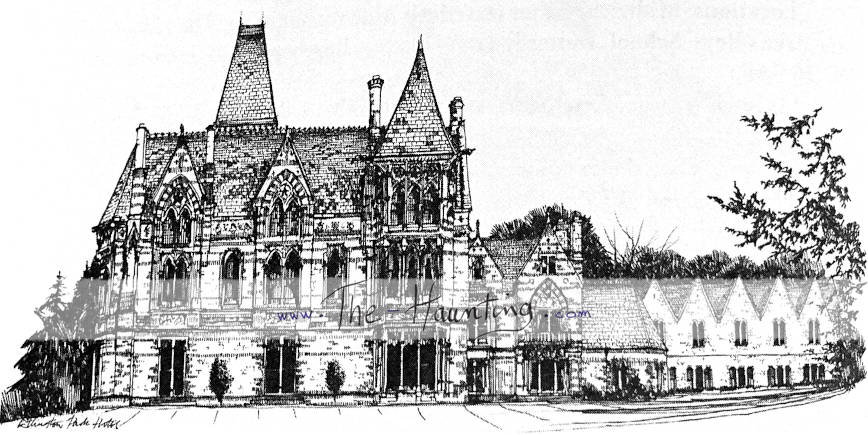
Locations: Ettington Park Hotel, Alderminster, Stratford-upon-Avon, Warwickshire.
Films: The Haunting (1963), The Watcher in the Woods (1980).
No place in England has been associated with one family longer than Ettington Park. The first record of the Shirley family at Ettington appeared in the Domesday Book over 900 years ago, and it is possible that they lived here before the Norman Conquest.
The house's rich and colorful history is written all over it. You'll see it in the scores of friezes, stained glass windows, chimneypieces, carved panels and coats of arms that embellish its walls. For instance, the frieze which appears over a bay window, depicting a page bringing a Saracen's head to Sir Thomas Shirley in the Holy Land.
Throughout the house's history, members of the Shirley family have left their mark. In 1820, John Shirley rebuilt the library and copied the chimneypiece so as to look like one from the Windsor Castle. His son, Evelyn Philip Shirley, left his own lasting monument when he rebuilt the house in high gothic style between 1858 and 1862.
This spectacular neo-Gothic mansion has been used to good effect in two classic movies.
The Haunting, filmed at Ettington in 1963, is certainly one of the most chiller specter movies of all time. Much of the film's shocking power comes from the somewhat eerie appearance of Ettington, beautifully captured by cinematographer David Boulton.
In the Walt Disney-produced film The Watchers in the Woods starring Bette Davis, Ettington is home of the sinister recluse Ian Bannen, holding onto a dark secret from his childhood.
Throughout its history, though, Ettington is far from eerie. It's a warm and much-loved home, built for pleasure. And now, as a hotel, its quiet opulence and beautiful surroundings provide the ideal place for you to relax and indulge yourself — just as guests in the past must have done. But do beware: It is said to be the most haunted hotel in Britain.
'Self and Society in the Films of Robert Wise'
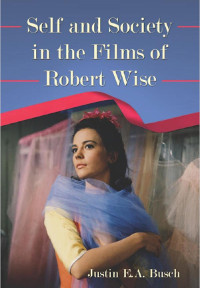
Title: Self and Society in the Films of Robert Wise
Author: Justin E. A. Busch
Paperback: 277 pages
Publisher: McFarland (August 2010)
Language: English
ISBN-10: 0-7864-5915-8
ISBN-13: 978-0-7864-5915-5
Product Dimensions: 5.9 x 0.7 x 8.9 inches; 15 x 1,8 x 22,6 cm
Book Description from Amazon
One of the most versatile Hollywood filmmmakers, Robert Wise had a number of renowned films under his directorial belt, including The Day The Earth Stood Still, West Side Story, The Sound of Music, and Star Trek: The Motion Picture. Nonetheless, Wise remains a rarely studied Hollywood figure -- while many filmgoers know and love his films, few recognize his name. This book, the first in-depth analysis of Wise's cinematic achievement, uncovers the elements that link the director's diverse cinematic subjects and examines the ways in which tensions between individuals and their societies are explored. His films are seen from a new perspective that will heighten an appreciation for the range and depth of his overall body of work.
'I Was a Monster Movie Maker', with a captivating interview of Nelson Gidding
From a great novel to a great movie script
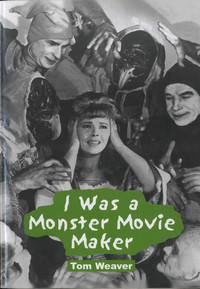
Title: I Was a Monster Movie Maker, Conversations with 22 Science Fiction and Horror Filmmakers
Author: Tom Weaver
Paperback: 320 pages
Publisher: McFarland; Reprint edition (April 2011)
Language: English
ISBN-10: 0-7864-6444-5
ISBN-13: 978-0-7864-6444-9
Product Dimensions: 17,5 x 2,3 x 25,1 cm
I truly enjoyed reading this book, that I discovered only recently (summer 2016). I was fascinated by Nelson Gidding's alternative theory regarding the novel: The haunted house is not real; Eleanor is institutionalized, under shock treatments; What she describes is her imaginary world, her distorted perception of the real world. And with Nelson Gidding's explanation, it all makes sense, it's plausible: the cold spot, the noises, the bangings on the wall, the doors closing by themselves, etc.
Again, I sincerely believe that Nelson Gidding has created an excellent movie script out of the [already fascinating] novel. It was a genuinely inspired and very creative work: as you might have read somewhere else on this page, there are countless differences between the book and the movie. It was not just a matter of editing here and there, adding more dialogues, and cutting some scenes. I was not surprised to read it was a 6-month work.
Book Description from Amazon
A collection of 22 interviews with the moviemakers responsible for bringing such films as This Island Earth, The Haunting, Carnival of Souls, Pit and the Pendulum, House of Wax, Tarzan the Ape Man, The Black Cat, Them! and Invasion of the Body Snatchers to the movie screen. Faith Domergue, Michael Forest, Anne Helm, Suzanna Leigh, Norman Lloyd, Maureen O'Sullivan, Shirley Ulmer, Dana Wynter[, Nelson Gigging] and many more are interviewed.
Book Review from Amazon
More Great SciFi/Horror Movie Interviews!! Love This Stuff!!!, December 24, 2012
Featuring Phil (Luke Skywalker's uncle) Brown...Booth (Planet of the Apes) Coleman...Faith (This Island Earth) Domergue...Michael (Viking Women) Forest...Nelson (The Haunting screenwriter) Gidding...Anne (The Magic Sword) Helm....Candace (Carnival of Souls) Hillgoss...Michael (Navy vs. Night Monsters writer-director) Hoey...John (Pit and the Pendulum) Kerr...Phyllis (House of Wax) Kirk...Suzanna (The Lost Continent) Leigh...Yvonne (Teenage Werewolf) Lime...Norman (actor, Alfred Hitchcock Presents producer) Lloyd...Maureen (Tarzan) O'Sullivan...Paul (House of Wax) Picerni...Anthony (Incubus producer) Taylor...Shirley Ulmer...Ray (My Favorite Martian) Walston...Joan (Them) Weldon...June (Macumba Love) Wilkinson...William Read Woodfield...and Dana (Invasion of the Body Snatchers) Wynter.
In this welcome addition to the Tom Weaver library of compilations of interviews with makers of science fiction and horror movies and TV shows, we have another collection of long-remembered stars and producers and writers, from House of Wax romantic lead Paul Picerni (later second-billed on The Untouchables series) to the elegant English actress Dana Wynter.
Ray Walston talks about his performances with Bela Lugosi in one of the Hungarian actor's many stage revivals of Dracula, playing Renfield and how Lugosi falsely claimed to him he was going to be forced by contract to do Frankenstein so he went out and himself found Boris Karloff to do it instead.
Norman Lloyd, veteran of Orson Welles movies and prolific actor, goes into depth about producing Alfred Hitchcock Presents on TV.
Anthony Taylor describes how he shot Incubus in the obscure artificial language, Esperanto, because he wanted to get the feel of a foreign film.
Shirley Ulmer, daughter of director Edgar Ulmer, describes how John Carradine, hiding out from an ex-wife looking for alimony, stayed with her family for awhile, which turned out to be quite awhile, and it was great.
Joan Weldon talks about how she was only 20 years old, but had to play a more mature scientist in her role in the giant ant movie, Them, first and best of the giant insect features.
Another outstanding compilation from Tom Weaver.
~ Nick Howes (Nashville, IL).
Very short excerpt
Noises in the hallway beyond a closed door. A weird configuration on an ornate bed frame. An area of cold air. A door, once locked, now standing open.
These might sound like mild (perhaps even improbable) ingredients for a full-fledged fright film, and yet they add up to almost unbearable suspense in The Haunting (1963), the classic haunted house melodrama based on Shirley Jackson's novel The Haunting of Hill House. Director Robert Wise and his cast (Julie Harris, Richard Johnson, Claire Bloom, Russ Tamblyn) have received full marks for their contributions to this masterpiece of unseen terror, but too often neglected is the excellent screenplay by Nelson Gidding, who went beyond Jackson's 1959 novel to furnish the film with its most spine-tingling scenes.
Talk about The Haunting — how did you get the job of adapting Shirley Jackson's book for the screen?
Bob was sent the book and he gave it to me to read, and he asked me what I thought. I said it was great, and he said, "I think so, too. Let's do it. We'll do it as a ghost story." I worked on that with him, and in the middle of that process, when I was halfway through it, it dawned on me that this wasn't a ghost story at all. It's about a women who's had a nervous breakdown and has been institutionalized. The haunted house is actually the institution, the sanitarium where she is a patient. And Markway, the head of the experiment in the haunted house, is actually her doctor. Theo is her nurse, and Eleanor is a patient. This is all true; I did quite a bit of research once I had this idea. A cold spot is shock treatment; I understand that, when you undergo shock treatment, you feel cold, very cold afterwards. And of course the violence of the shock treatment itself is the noise and the banging of the haunted house. And people were always opening and closing doors because it was a locked institution. [In the movie, the doors of Hill House open and close by themselves.] It worked perfectly. I could give you chapter and verse, I had a very good case for it.
How did you intend to get across to the audience the fact that the haunted house was actually a sanitarium? With a scene at the end?
I suppose I would have, but I don't know — I didn't get that far. We had written a ghost story and it was supposed to be that, and we weren't going to change it drastically. But we figured this might be the real meaning. Bob said, "Let's go and see Shirley Jackson,", and we did — we went from California to Bennington, Vermont, where her husband [literary critic Stanley Edgar Hyman] was a teacher. We had a meeting with her, had lunch with her, and told her this idea. And she said no — she said, "It's a good idea, but — that isn't it. [The Haunting] is a ghost story." And that was that.
And yet there's a whiff of that left in the movie you wrote. The audience never quite knows if the ghosts are real or if —
That's right, it's left hanging, it's "open." Is Eleanor [Julie Harris] disturbed, or are these [ghosts] the real thing? That's the one thing Bob and I didn't agree on: I believe in the supernatural, something that is not explained yet but will have an explanation someday. He doesn't believe, he'll have no part of the supernatural. But he can easily stretch his imagination to anything in space, flying saucers or anything like that. That he can understand and believe in, but the supernatural? He does not.
What was Shirley Jackson like?
She was wonderful, a very smart woman. We spent a few hours with her, and she was gracious. I had liked her work before — The Haunting wasn't the first time I had come across her work. She wrote a very good, very famous "long short story" called The Lottery.
If you had had more money in your budget, would you have wanted "bigger" stars?
Oh, no, no! Very wonderful actors we had. Richard Johnson worked perfectly as the professor who is from England, and who works now at an American college. Julie Harris was a stage actress, and she was wonderful — and still is now!
How long did it take to write the script?
It wasn't fast. It was probably something over six months. When I started, I believe Bob was working on West Side Story [1961].
Did you pass pages along to Wise as you finished them, as many writers do?
No, not as I finished them. I passed them along to him as I wanted him to read them, just to show him how it was coming along. To give him confidence and to give me confidence in the project. Also, keep in mind that I had already a complete treatment, so there were no surprises in it.
Were you in England when they made the movie?
Yes, I was there and I saw the house — I thought it was a wonderful house, just perfect. The house itself was great and the way Bob shot it was great. He made the house a character. The book also did that, and so did my screenplay: It made the house a character, one of the main characters. And Bob did it superbly well. It was actually a hotel; before it was a hotel, I don't know what is was. But it had its own private ghost!
The way The Haunting ends, the viewer is left to wonder whether the house is haunted —
Or whether Eleanor is psychotic. There's plenty of evidence in there to show that she is... but there's also plenty of evidence to show that these [supernatural] things are happening. My belief is that the house is haunted.
Do you believe in ghosts?
I believe that this house was haunted, and I believe there could be such as thing as a haunted house. But it could be paranormal, and that the things that happen [in haunted houses] will be explained someday.
There is a hint in the movie that the ghosts are real: Julie Harris continues to narrate the movie after she's dead. That's not in the novel.
No, it's not. And, you're right, that's a clue that the house is haunted. The house goes on being haunted, and she's now one of the people — maybe the main person — haunting it.
"We who walk here, walk alone," she says at the end.
Yes! Glad you caught that.
Was there any hesitation on anybody's part about bringing the hints of lesbianism from the novel to the screen?
I felt the taint of it in the novel, and we put it in. We had to be very careful of it in those days, but we sketched it in because we felt it should be there as part of... well, the unnatural. We had the supernatural, and in those days [lesbianism] would be considered unnatural. But now, it's almost unnatural to be straight [laughs]! We shot for the beginning of the movie a scene where Claire Bloom's girlfriend is leaving the apartment where they live, and Claire is throwing things out the window. It's a small scene, just mostly a shouting match from Claire in the window to her girlfriend in the car.
Why was it cut from the movie?
Maybe for reasons of length. Maybe they thought it wasn't up to snuff. I don't know why.
Robert Wise seemed glad to get back to making movies in the U.S. after The Haunting. He complained in a 1963 interview about British union rules that were antiquated.
That's right, you had to get permissions to break at certain times. And permission not to break. If tea time is at 4:15, in the middle of a very expensive shot that's taken you half a day to set up, they will quit — it's up to them! So you have to get permission. And if you forget to say "Please" or "Thank you", some of them won't do what you're asking! That didn't bother Wise because he's very civil and he's naturally polite, a thorough gentleman in every sense of the word. But it's a pain in the ass, nevertheless!
[This is a very short excerpt of the section dedicated to Nelson Gidding. Buy the book to read it in its full length]
'L'Encyclopédie du fantastique'
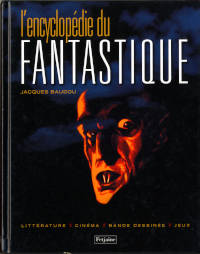
Title: L'Encyclopédie du fantastique
Author: Jacques Baudou
Hardcover: 190 pages
Publisher: Editions Fetjaine (October 2011)
Language: French
ISBN-10: 2-35425-237-4
ISBN-13: 978-2-35425-237-3
Product Dimensions: 19,3 x 1,9 x 24,6 cm
Book Description from the back the book (Original French)
Vampires, fantômes, loups-garous, objets maléfiques, créatures monstrueuses...
Le Fantastique se caractérise par l'irruption du surnaturel dans un contexte bien réel, provoquant ainsi des émotions qui vont de la terreur à la séduction. Si ce genre littéraire existe en tant que tel depuis deux siècles, avec le roman de Mary Shelley, Frankenstein, le Fantastique est en réalité vieux comme le monde. Des créatures monstrueuses attaquant l’homme existent dans la Bible et dans toutes les mythologies. C'est principalement au Moyen Âge, avec le développement de la peur des sorcières, du diable et de ses démons qu'est née cette littérature qui prend son essor avec Dante, puis avec le roman gothique anglais au XVIIIe siècle. Il s’ensuivra une innombrable série de chefs-d’œuvre : le Faust de Goethe, certaines œuvres de Baudelaire, Gérard de Nerval, Théophile Gautier, les contes de Grimm ou ceux d'Hoffmann, les histoires d’Edgar Allan Poe (La Chute de la maison Usher), celles de Gogol, Tolstoï et le Dracula, de Bram Stoker, dont le succès installe définitivement le genre.
Extraordinairement illustré et d'une érudition passionnante, ce livre explore toutes les voies du Fantastique, à travers la littérature mais aussi le cinéma, les séries télé ou la bande dessinée. Préparez-vous à découvrir de nombreux domaines inconnus.
Book Description from the back the book (English translation)
Vampires, ghosts, werewolves, evil objects, monstrous creatures...
Fantasy is characterised by the intrusion of the supernatural into a very real context, provoking emotions ranging from terror to seduction. Although this literary genre has existed in its own right for two centuries, with Mary Shelley's novel Frankenstein, fantasy is in fact as old as the hills. Monstrous creatures attacking man exist in the Bible and in all mythologies. It was mainly in the Middle Ages, with the development of the fear of witches, the devil and his demons, that this literature was born. It took off with Dante, and then with the English Gothic novel in the 18th century. This was followed by a series of masterpieces: Goethe's Faust, works by Baudelaire, Gérard de Nerval, Théophile Gautier, Grimm's fairy tales, Hoffmann's tales, stories by Edgar Allan Poe (The Fall of the House of Usher), Gogol, Tolstoy and Bram Stoker's Dracula, whose success established the genre once and for all.
Extraordinarily illustrated and fascinatingly erudite, this book explores all aspects of the fantastic, not only in literature but also in film, TV series and comic strips. Get ready to discover many unknown areas.
Very short excerpt (Original French)
"The Magazine of Fantasy and Science Fiction" fut fondé en 1949 et eut pour rédacteur en chef Anthony Boucher, qui n’hésita pas à rééditer des textes publiés dans les slick magazines comme "The New Yorker" ou "The Saturday Evening Post". Outre des textes de science-fiction, le magazine publia des nouvelles fantastiques d'auteurs comme Ray Bradbury, August Derleth, Richard Matheson, Russell Kirk ou Robert Bloch, qui obtint en 1958 un prix Hugo pour un texte fantastique : "That Hell-Bound Train" ("Le Train pour l'enfer").
Les années 1950 virent l'émergence de plusieurs grands auteurs fantastiques américains qui débutèrent dans les pulps ou les magazines au format "digest".
La première fut Shirley Jackson (1919-1965). Elle collabora au New Yorker, dans lequel parut sa nouvelle fantastique "La Loterie" (adaptée plusieurs fois à la télévision américaine), publiée ensuite dans le recueil "The Lottery or the Adventure of James Harris" (1949), où figurent également plusieurs autres textes de la même veine comme "L’Amant diabolique". En 1959, elle publia un roman, "The Haunting of Hill House" ("Maison hantée"), que Stephen King considère comme le meilleur roman fantastique de ces cent dernières années : "Quatre chasseurs de fantômes se retrouvent dans une maison de sinistre réputation. Le livre raconte leurs aventures et s’achève par une conclusion aussi terrifiante qu’énigmatique." Le roman a été porté à l’écran par Robert Wise sous le titre "The Haunting" (1962, "La Maison du diable") avec Claire Bloom et Julie Harris.
Very short excerpt (English translation)
The Magazine of Fantasy and Science Fiction was founded in 1949 and had Anthony Boucher as its editor-in-chief, who did not hesitate to reprint material published in slick magazines such as The New Yorker and The Saturday Evening Post. As well as science fiction, the magazine published fantastic short stories by authors such as Ray Bradbury, August Derleth, Richard Matheson, Russell Kirk and Robert Bloch, who won a Hugo award in 1958 for a fantastic story entitled "That Hell-Bound Train".
The 1950s saw the emergence of a number of great American fantasy writers who got their start in pulps or digest-format magazines.
The first was Shirley Jackson (1919-1965). She wrote for The New Yorker, which published her fantasy short story "The Lottery" (adapted several times for American television), later published in the collection "The Lottery or the Adventure of James Harris" (1949), which also included several other texts in the same vein, such as "The Daemon Lover". In 1959, she published a novel, "The Haunting of Hill House", which Stephen King considers to be the best fantasy novel of the last hundred years: "Four ghost hunters find themselves in a house of sinister reputation. The book recounts their adventures and ends with a conclusion that is as terrifying as it is enigmatic." The novel was brought to the screen by Robert Wise as "The Haunting" (1962) with Claire Bloom and Julie Harris.
[This is a very short excerpt of the book. Buy it to read it in its full length]
'Robert Wise Shadowlands'

Title: Robert Wise Shadowlands
Author: Wes D. Gehring
Paperback: 345 pages
Publisher: Indiana Historical Society (August 2012)
Language: English
ISBN-10: 0-87195-296-3
ISBN-13: 978-0-87195-296-7
Product Dimensions: 1 x 6.2 x 9 inches; 2,5 x 15,7 x 23 cm
Book Description from the back flap of the book
Born in Winchester, Indiana, Robert Wise spent much of his youth sitting in darkened movie theaters enthralled by the swashbuckling heroics of screen legend Douglas Fairbanks Sr. Through these viewings, Wise developed a passion for film a passion he followed for the rest of his life, making movies in Hollywood. Nationally known film historian Wes D. Gehring explores Wise's life from his days in the Hoosier State to the beginning of his movie career at RKO studios working as the editor of Orson Welles's classic movie Citizen Kane. Wise is best known for producing and directing two of the most memorable movie musicals in cinema history, West Side Story (co-director Jerome Robbins) and The Sound of Music, for which he won four Academy Awards two Best Picture and Best Director Oscars. But, as Gehring notes, other than Howard Hawks, Wise was arguably Hollywood's most versatile director of various celebrated genre films. For example, his roots in horror go back to a tutelage under the great producer Val Lewton, with Wise directing Boris Karloff's chilling The Body Snatcher (1945) for Lewton. Years late Wise brilliantly adapted a Shirley Jackson novel as a homage to Lewton, The Haunting (1963). No less a horror aficionado than Stephen King later gave both Jackson's novel (originally entitled The Haunting of Hill House) and the film his highest praise in his nonfiction study of horror, Danse Macabre. In an American Film Institute seminar in 1980 Wise told students, "People ask me, do I prefer to do musicals to drama or comedy? I like them all. If it's good, exciting, gripping, original material, that's what's important, what counts." Wise died on September 14, 2005, four days after his ninety-first birthday.
Wes D. Gehring is a professor of film at Ball State University and an associate media editor for USA Today Magazine, for which he also writes the column "Red World." The award-winning author of thirty-one books, Gehring has written biographies of such screen legends as Charlie Chaplin, W. C. Fields, the Marx Brothers, Laurel and Hardy, Irene Dunne, Carole Lombard, James Dean, Steven McQueen, and Red Skelton.
Book Review from Amazon
Wonderful Read!!!!, June 3, 2014
Film maker Robert Wise (1914-2005) -- perhaps best known for directing big-budget musicals like "The Sound of Music" and "West Side Story" -- is not usually associated with Indiana. However, Gehring (Ball State University) , the foremost authority on Hoosier entertainers (with previous biographies on James Dean, Carole Lombard, and Red Skelton) , ably demonstrates how Wise's mid-western roots influenced his film career. Particularly thorough are the chapters on Wise's early work with Orson Welles and Val Lewton and on Wise's subsequent successes in genres as diverse as science fiction, horror, film noir, and war melodrama. Having written or edited more than 30 books on film, Gehring knows much about the Hollywood scene...[and] the book is a welcome addition to the literature, providing greater depth on Wise's character than either Richard Keenan's "The Films of Robert Wise" (CH,Mar'08, 45-3681) or Justin Busch's "Self and Society in the Films of Robert Wise" (CH,Feb'11 48-3166) -- J.I. Deutsch, George Washington University, "Choice," the magazine of the American Library Association.
~ Garrett.
Very short excerpt
With the musical [West Side] Story and the realistic romantic comedy Two [for the Seesaw], Wise had essentially completed his goal of directing all the mainstream genres. Therefore, the time seemed right to revisit his horror-film roots by tackling an adaptation of a novel considered to be one of the twentieth century's pivotal works of horror, Shirley Jackson's The Haunting of Hill House, in the process turning it into an unofficial tribute to mentor Val Lewton. In addition to the book's psychological horror foundation being fertile ground for a homage to the subtextual terror of Lewton, Jackson's work taps into a popular component in many Wise pictures — the spooky old house as a metaphor. Fittingly, the director's great pleasure in simply reading the novel was undoubtedly further embellished by the fact that "Houses loomed large in her [Jackson's] imagination [and work], as places that promise but never quite deliver some respite from everyday terrors." And just as this novel is Jackson's best example of a house as a depository for evil, Wise's adaptation holds a comparable cinematic place among his films.
Film historian William K. Everson has praised the psychological horror picture, or what might simply be labeled an "intelligently scary — non-gore movie," as "nothing that the camera can show can possibly be as horrible as what the mind can imagine; it suggests nothing, and suggests all." While this wonderfully describes the Lewton/Wise approach to horror, the quote can also have a subtextual meaning. That is, just as the viewer's imagination can be more frightening than on-screen special effects, watching the meltdown of a child or childlike horror film heroine, be it young Ann Carter in Wise's The Curse of the Cat People (1944) or Julie Harris's naïve recluse in [The] Haunting, takes the audience's horror musings to a disturbing second tier. One is not just imagining the cause of that movie bump in the night. There is now a disturbing concern for whatever is going on in the mind of the picture's vulnerable core character — an innocent civilian who has not paid money, a la the horror aficionado, for what Alfred Hitchcock claimed was the genre's "beneficial shocks." Thus, while Christopher Nolan's Inception (2010) reveals disturbing dreams within dreams, [The] Haunting encourages scary imagining about another's imagination.
For the casual fan, however, the downside of intelligent horror is that, to paraphrase critic/author Jeff VanderMeer, the film requires the viewer to "collaborate with the artist, to fill in the gaps."
Paradoxically, as much as Wise admired the novel, he sometimes struggled with Jackson's purpose. At its most basic, the tale is about an anthropologist who brings together three people for "an experiment in psychic research." The setting is Hill House, a spooky old New England Victorian mansion (Ettingen Hall [Ettington Park], near Stratford-on-Avon [Stratford-upon-Avon] in England, doubled for Hill House), which may or may not be haunted. The academic is Doctor John Markway (Richard Johnson), and the subjects include Eleanor Lance (Julie Harris), who had a poltergeist experience as a child; Theodora (Claire Bloom), a Greenwich Village free spirit with extrasensory perception powers; and Luke Sanderson (Russ Tamblyn), a nephew watchdog for the mansion's absentee owner. Ultimately, Harris's character is the house's only victim, but there is no overt act. Instead, Hill House's seemingly supernaturally possessed nature, from its spiritual world cold spots to the animalistic noises and deafening poundings on interior doors, seems to be taking over Eleanor's mind, just as her controlling invalid mother had done during the daughter's trying time as a caretaker. But Wise later wrote a fan that during preproduction he and his screenwriter (Nelson Gidding) went back East to discuss Eleanor's plight with Jackson, since the author generally avoided interviews/explanations about her writing. "At one point, she [Jackson] said that everybody needed a home and since there was no home for Eleanor ... anyplace else [after her mother's death], she ... [went] to Hill House," Wise said. "Reasons why she succumbed and others didn't were explained the way you have put it [the others had someone]. I know the picture caused confusion among quite a number of people who saw it. I could only wish that they had gotten the point as clearly and succinctly as you did."
Wise's comments were possibly influenced by mixed reviews from Variety and the New York Times." Sadly, Richard C. Keenan's often insightful book, The Films of Robert Wise, suggests the film met with "little enthusiasm by the reviewers of the day." Keenan seems to base that perspective on only the Variety and [New York] Times reviews. A more thorough examination of period critiques finds [The] Haunting and Wise heavily praised. Indeed, even the majority of New York City newspapers, publications that had so nitpicked Two [for the Seesaw], were full of praise for [The] Haunting. The New York World-Telegram's William Peper wrote: " 'The Haunting' is a movie that believes in ghosts and before it's over, it should have audiences believing in them, too, for it is a genuinely spooky film. . . . At creating a mood of unseen terror, Wise is a thumping success." Rose Pelswick's New York Journal American critique, "Bang-Up Thriller Full of Suspense," closed with the following good-humored praise for the chilling tale: "If this one had been released during the summer months, the theatres wouldn't have had to turn on their cold air units." Critic Judith Crist was even more superlative in her New York Herald Tribune review, serving up sagely pluralist perspectives on the film's meaning, indicating that the film was "a thoroughly satisfying ghost story for grown-ups done with a style and professionalism that has long been denied spook-story addicts. ... Is it the story of a haunted house, a study of the effects of fear upon an already neurotic mind, an allegory of a nervous breakdown? Play with it as you will ... and have a delicious wallow in the horror of 'The Haunting.' "
The brilliance of Jackson's novel, and Wise's adaptation, regardless of one's interpretation of the story's meaning (one could also apply critic Roland Barthes's constant theme of "the instability of [any] meaning"), involves the ultimate act of betrayal in which the home is not a sanctuary. Like the desertion of one's friends/family in film noir, another genre that shaped Wise, this kind of hurt stung the most. Yet, just as an abused child and/or spouse will often cling to the oppressor because that is all she/he has, Harris's Eleanor ultimately seems to succumb to the house because that is all she has.
As a final footnote to the power of [The] Haunting, beyond the horror genre, the work can also be seen as a tongue-in-cheek metaphor for any abode where creative types work their magic. Critic Terrence Rafferty once wrote of another Jackson literary home, "In a way ... [this] crazy house is where writers go when they write, that quiet spot where nothing is ever as peaceful as it seems." Imagine the imagery swirling around in the mind of Stephen King as he writes his novels in yet another New England Victorian mansion.
[This is a very short excerpt of the book. Buy it to read it in its full length]
'Shirley Jackson, a rather haunted life'
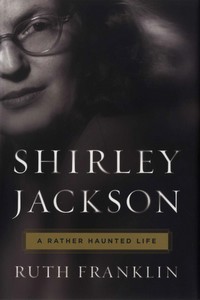
Title: Shirley Jackson, a rather haunted life
Author: Ruth Franklin
Hardcover: 624 pages
Publisher: Liveright Publishing Corporation (October 2016)
Language: English
ISBN-10: 0-87140-313-7
ISBN-13: 978-0-87140-313-1
Product Dimensions: 6.6 x 1.6 x 9.6 inches; 16,8 x 4,1 x 24,4 cm
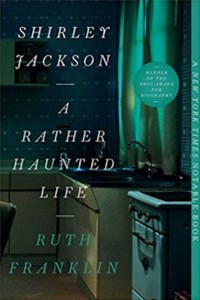
Title: Shirley Jackson, a rather haunted life
Author: Ruth Franklin
Paperback: 624 pages
Publisher: Liveright Publishing Corporation; 1 edition (October 2017)
Language: English
ISBN-10: 1-63149-341-8
ISBN-13: 978-1-63149-341-6
Product Dimensions: 5.5 x 0.6 x 8.3 inches; 14 x 1,5 x 21 cm
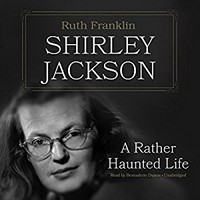
Title: Shirley Jackson, a rather haunted life
Author: Ruth Franklin
Audiobook: 19 hours and 24 minutes
Read by: Bernadette Dunne
Publisher: Blackstone Audio, Inc. (September 2017)
Language: English
Whispersync for Voice: Ready
Paper book Description from the publisher
Still known to millions only as the author of the "The Lottery," Shirley Jackson (1916-1965) remains curiously absent from the American literary canon. A genius of literary suspense, Jackson plumbed the cultural anxiety of postwar America better than anyone. Now, biographer Ruth Franklin reveals the tumultuous life and inner darkness of the author behind such classics as "The Haunting of Hill House" and "We Have Always Lived in the Castle". Placing Jackson within an American Gothic tradition of Hawthorne and Poe, Franklin demonstrates how her unique contribution to this genre came from her focus on "domestic horror" drawn from an era hostile to women. Based on a wealth of previously undiscovered correspondence and dozens of new interviews, Shirley Jackson, with its exploration of astonishing talent shaped by a damaged childhood and a troubled marriage to literary critic Stanley Hyman, becomes the definitive biography of a generational avatar and an American literary giant.
Audiobook Description from Audible.com
This historically relevant biography establishes Shirley Jackson as a towering figure in American literature and revives the life and work of a neglected master.
Known to millions mainly as the author of the "The Lottery", Shirley Jackson has been curiously absent from the mainstream American literary canon. A genius of literary suspense and psychological horror, Jackson plumbed the cultural anxiety of postwar America more deeply than anyone. Ruth Franklin reveals the tumultuous life and inner darkness of the author of "The Haunting of Hill House" and "We Have Always Lived in the Castle".
Placing Jackson within an American Gothic tradition stretching back to Hawthorne and Poe, Franklin demonstrates how her unique contribution to this genre came from her focus on "domestic horror". Almost two decades before The Feminine Mystique ignited the women's movement, Jackson's stories and nonfiction chronicles were already exploring the exploitation and the desperate isolation of women, particularly married women, in American society.
Here Jackson emerges as a ferociously talented, determined, and prodigiously creative writer when it was unusual for a woman to have both a family and a profession. Mother of four and wife of a prominent New Yorker critic and academic, Jackson lived a seemingly bucolic life in Vermont. Yet, much like her stories, which explored the claustrophobia of marriage and motherhood, Jackson's creativity was haunted by a darker side. As her career progressed, her marriage became more tenuous, her anxiety mounted, and she became addicted to amphetamines and tranquilizers. Franklin insightfully details the effects of Jackson's upbringing, hypercritical mother, and relationship with her husband.
Based on previously undiscovered correspondence and dozens of new interviews, this book explores an astonishing talent shaped by a damaging childhood and turbulent marriage and becomes the definitive biography of a generational avatar and American literary giant.
About the author
Ruth Franklin is a book critic and frequent contributor to The New Yorker, Harper's, and many other publications. A recipient of a New York Public Library Cullman Fellowship and a Guggenheim Fellowship, she lives in Brooklyn, New York.
Quotes from the back cover
"Not just a terrific biography, but a remarkable act of reclamation: if there was ever a great writer of the twentieth century who fell victim to 'How to Dismiss Women's Fiction,' it was Shirley Jackson. What 'A Rather Haunted Life' gives us is a way of reading Jackson and her work that threads her into the weave of the world of words, as a writer and as a woman, rather than excludes her as an anomaly. She was an anomaly, of course, because she was so smart and brave and glorious a writer and storyteller, because she was better at what she did, and had more range, that anyone else writing at the time. Ruth Franklin is the biographer Jackson needed: she tells the story of the author in a way that made me want to reread every word Jackson ever wrote." ~ Neil Gaiman.
"A perfect marriage of biographer and subject: Ruth Franklin's portrait of Shirley Jackson restores to her rightful place a writer of considerable significance, and draws a rich intellectual portrait of the age." ~ Claire Messud, author of 'The Woman Upstairs'.
"Ruth Franklin has written the ideal biography of a figure long and unjustly neglected in the history of twentieth-century American literature. By restoring Shirley Jackson to her proper stature as one of our great writers, Franklin has in a stroke revised the canon. As biography, it's an exemplary performance: shrewd, sympathetic, and sophisticated in its critical judgments. This isn't the biography of Shirley Jackson for our time: it's the biography for all time." ~ James Atlas, author of 'Bellow: A Biography'.
"Franklin's biography takes us beyond the chilling stories that made Shirley Jackson's name into the dilemmas of a women writer in the 1950s and '60s, struggling to make a career between the pressures of childcare, domesticity, and her own demons. It's a very modern story, and a terrific read." ~ Mary Beard, author of 'SPQR'.
"With her account of emblematically American literary life, Ruth Franklin reminds us that her subject was fare more than the writer of classy ghost stories. On the contrary, Shirley Jackson was the harbinger of profound upheavals both societal and literary. This is a brilliant biography on every level, but it is especially astute on Jackson's ground- and genre-breaking work, which I will now reread immediately." ~ Tom Bissel, author of 'Apostle'.
"A biography that is both historically engaging and pressingly relevant, Ruth Franklin's absorbing book not only feelingly creates a portrait of Shirley Jackson the writer but also provides a stirring sense of what it was like to navigate (and sometimes circumvent) the strictures of American society as a wife, mother, artist, and woman." ~ Meg Wolitzer, author of 'The Interestings'.
Text from the front and back flap
Still known to millions primarily as the author of the "The Lottery," Shirley Jackson (1916-1965) has been curiously absent from the mainstream American literary canon. A genius of literary suspense and psychological horror, Jackson plumbed the cultural anxiety of post-war America more deeply than anyone. Now, biographer Ruth Franklin reveals the tumultuous life and inner darkness of the author of such classics as "The Haunting of Hill House" and "We Have Always Lived in the Castle."
Placing Jackson within an American Gothic tradition that stretches back to Hawthorne and Poe, Franklin demonstrates how her unique contribution to this genre came from her focus on "domestic horror." Almost two decades before "The Feminine Mystique" ignited the women's movement, Jackson's stories and nonfiction chronicles were already exploring the exploitation and the desperate isolation of women, particularly married women, in American society. Franklin's portrait of Jackson gives us "a Way of reading Jackson and her work that threads her into the weave of the world of words, as a writer and as a woman, rather than excludes her as an anomaly" ~ Neil Gaiman.
The increasingly prescient Jackson emerges as a ferociously talented, determined, and prodigiously creative writer in a time when it was unusal for a women to have both a family and a profession. A mother of four and the wife of the prominent New Yorker critic and academic Stanley Edgar Hyman, Jackson lived a seemingly bucolic life in the New England town of North Bennington, Vermont. Yet, much like her stories, which channeled the occult while exploring the claustrophobia of marriage and motherhood, Jackson's creative ascent was haunted by a darker side. As her career progressed, her marriage became more tenuous, the anxiety mounted, and she became addicted to amphetamines and tranquilizers. In sobering detail, Franklin examines the psychological effects of Jackson's California upbringing, in the shadow of hypercritical mother, on her relationship with her husband, juxtaposing Hyman's infidelities, domineering behavior, and professional jealousy with his unerring devotion to Jackson's fiction, which he was convinced was among the most brilliant he had ever encountered.
Based on a wealth of previously undiscovered correspondence and dozens of new interviews, Shirley Jackson — an exploration of astonishing talent shaped by a damaging childhood and turbulent marriage — becomes the definitive biography of a generational avatar and an American literary giant.
Ruth Franklin is a book critic and frequent contributor to The New Worker, Harper's, and many other publications. A recipient of a New York Public Library Cullman Fellowship and a Guggenheim Fellowship, she lives in Brooklyn, New York.
Fascinating facts, taken from the book
Incident: In early January 1958, Shirley Jackson went on a trip to New York with her husband. As their train pulled into the stop at 125th street, Jackson was startled by the sight of "the most hideous building" she had ever seen. Something about it was "unspeakable... horrifying". As the train pulled away, something strange happened: it disappeared. After returning to Vermont, Jackson was still obsessed with the hideous-looking tenement. She wrote to a friend at Columbia to ask if he knew of any explanation for its ghastly appearance. "Some seven months before the building had been almost entirely burned in a disastrous fire which killed nine people. What was left of the building... was a shell. The children in the neighborhood knew that is was haunted." Jackson came back from New York eager to being a new novel about a haunted house.
The working title was "The Haunted House".
The movie rights to [The Haunting of] Hill House were sold for the sum of $67,500.
Inspirations for Hill House:
- 'Jennings Hall' at Bennington College
- 'Edward H. Everett mansion' near Old Bennington
- 'Winchester Mystery House'
"Whose hand was I holding?" is the "key line" of the novel, according to Jackson's notes.
Other colours: In Shirley Jackson's preparatory sketch for the first floor of the house, we can see that many of the rooms have coloured names: Red, Yellow, Rose, Violet, Green and Blue. There is also a play room, a nursery and a school room.
Very short excerpts
Now that Jackson had found her house, she needed ghosts. She consulted a number of well-known historical accounts of haunted houses: the report of John Crichton-Stuart, who led a team of psychical researchers to investigate Ballechin House in Scotland in the late 1890s, as well as the book An Adventure, in which Charlotte Anne Moberly and Eleanor Jourdain, two British women on a European vacation, describe their uncanny experience of stumbling on a scene from the past while visiting the Petit Trianon, Madame du Barry's house at Versailles. An episode late in [The Haunting of] Hill House, in which Eleanor and Theodora unexpectedly come upon a group of people — perhaps ghosts — picnicking in the grounds behind the house, shows the influence of their chronicle, as does Jackson's use of the name Eleanor, found nowhere else in her work, for her main character. In her notes for the novel, Jackson refers to An Adventure as "one of the greatest ghost stories of all time."
Early drafts demonstrate that marriage was crucial to Shirley's vision of the novel from the start. In one version, the sister of Erica, the protagonist (later to be named Eleanor), wants to set her up with a man. "Carrie wanted me to get married, for some inscrutable reason," Erica says. "Perhaps she found the married state so excruciatingly disagreeable herself that it was the only thing bad enough she could think of to do to me." To be married, Shirley always feared, was to lose her sense of self, to disintegrate — precisely what happens to Eleanor in the grip of the house.
In [The Haunting of] Hill House, which appeared in 1959, Jackson gathered powerfully all the objects of her longtime obsession: an unhappy, unmarried woman with a secret trauma; the simultaneous longing for a mother's love and fear of its control; the uncertain legacies handed down by previous generations; and finally, the supernatural as a representation of the deepest psychic fears and desires.
"The house is the haunting (can never be un-haunted)," Jackson wrote in her notes for the novel; on another page, she wrote, "The house is Eleanor." Jackson clearly intended the external signs of haunting to be interpreted as manifestations of Eleanor's troubled psyche; over and over, in her notes and lectures about the book, she states that she does not believe in ghosts.
In an early version of the novel, the spirit voice that the protagonist hears whispers to her to go away. But at some point in the writing process, Jackson realized that staying in Hill House was more frightening than leaving it.
For each character in a story or novel, she explains, she uses one basic image or set of images that the reader will associate with the character. For Eleanor, there are five:
- A little old lady she meets on her way to get her car, who tells her she will pray for her;
- Two stone lions outside one of the houses she passes;
- The oleander bushes surrounding another house;
- A white cat on the step of a cottage;
- And the little girl she encounters in the small inn who refuses to drink her milk because it is not in the cup painted on the inside with stars that she prefers at home. ("Insist on your cup of stars," Eleanor silently bids the girl, poignantly, since her childhood — like Jackson's — clearly did not include such a cup, or a mother who would have indulged her whims.)
The five symbols will recur throughout the novel, and each time they do, Jackson explains, they remind the reader of Eleanor's essential loneliness and homelessness. They become "artificially loaded words" that, deployed correctly, have a powerful impact.
[The Haunting of] Hill House was a financial and critical triumph. A month before the publication date of October 16, 1959 — appropriately close to Halloween — Viking ran an unusual announcement in The New York Times, generating advance sales of about eight thousand copies and considerable buzz.
Though [The Haunting of] Hill House did not make the best-seller lists, it sold far better than any of Jackson's previous novels — around 12,000 copies for the hardcover edition in the first six months. For a condensed version, Reader's Digest offered $35,000, split between Jackson and Viking, which guaranteed another 25,000 copies in print.
Jackson said publicly that she was pleased with the adaptation. "When I saw it, I was terrified. I couldn't believe that I had written this," she told a reporter. In private, she bemoaned the changes made to the plot, but said the house — the real star of the movie, anyway — was wonderful.
[These are very short excerpts of the book. Buy it to read it in its full length]
'Robert Wise: The motion pictures'
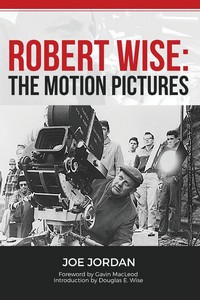
Title: Robert Wise: The motion pictures
Author: Joe Jordan
Paperback: 550 pages
Publisher: Joseph R. Jordan (April 2017)
Language: English
ISBN-10: 0-692-85447-9
ISBN-13: 978-0-692-85447-1
Product Dimensions: 6 x 1.1 x 9 inches; 15,2 x 2,8 x 22,9 cm
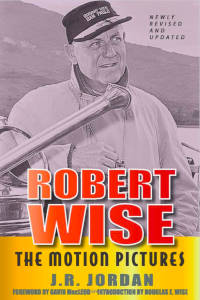
Title: Robert Wise: The motion pictures (2020 Revised and Updated edition)
Author: J. R. Jordan
Paperback: 506 pages
Publisher: BearManor Media (February 2020)
Language: English
ISBN-10: 1-62933-537-1
ISBN-13: 978-1-62933-537-7
Product Dimensions: 6 x 1.1 x 9 inches; 15,2 x 2,8 x 22,9 cm
Book Description from the publisher
(The same text also appears on the book back cover)
"Robert Wise remains one of the great architects of American movies of this last century; the steady, easy personality, hiding a will of steel that allowed him to guide his movies with a hand of knowledge, and authority, and soar in every single genre he undertook. With one of the most wide-ranging careers of any filmmaker ever, Joe Jordan's book more than does Robert Wise justice in critically assessing his incredibly versatile work, as well as honoring the man who quietly created some of the finest and most famous movies of all time." ~ C. Courtney Joyner, Author of 'The Westerners: Interviews with Actors, Directors, Writers, and Producers'.
"Meticulous research by Joe Jordan makes this a thorough study of director Robert Wise, which classic film fans will appreciate. Jordan examines the body of Wise's work in a film-by-film journey, his information woven neatly with interviews of participants providing the voices. They are the soundtrack, and Jordan's careful presentation of the material is the long tracking shot that lures us into a sudden, sharp, and breathtaking close-up, echoing the director's own careful craftsmanship." ~ Jacqueline T. Lynch, Author of 'Ann Blyth: Actress. Singer. Star.'
"With this extremely readable volume film historian Joe Jordan gives us a rigorous examination of Robert Wise's career and contributions to American cinema. Wise often goes underappreciated but Jordan does this pioneer justice. Jordan's prose is accessible and uncompromising at once. This book is a must read for anyone who appreciates the gift of cinema to humanity." ~ Tony Kashani, Author of 'Movies Change Lives: Pedagogy of Constructive Humanistic Transformation Through Cinema (Minding the Media)'.
About the author
Joe Jordan is a motion picture historian and has taught film appreciation courses for several years.
Book Description from Amazon
Robert Wise, the young editor of Citizen Kane, earned his directorial stripes at RKO, particularly with The Body Snatcher and The Set-Up, films of amazing quality and dark sensibility. Wise later found himself at Warner Brothers, MGM, and 20th Century Fox, consistently directing pictures of depth and versatility. The man behind the searing crime film, Odds Against Tomorrow, followed such success with the upbeat West Side Story. Wise guided the great, multi-character drama of Executive Suite and also turned his attention to warfare with The Sand Pebbles. He was the personification of the finest, old style "studio director" and ultimately became a two-time winner of the Academy Award for Best Director. Wise not only made films his way, he made them the right way, directing classics such as The Day the Earth Stood Still, The Sound of Music, and Star Trek: The Motion Picture. Joe Jordan's book, which includes over twenty interviews, presents a studious, solemn analysis of the complete Robert Wise canon.
'Ettington Park: Reputed to be the Most Haunted Hotel in England'

Title: Ettington Park: Reputed to be the Most Haunted Hotel in England
Author: John Richard Hodges
Paperback: 236 pages
Publisher: John Richard Hodges (May 2018)
Language: English
ISBN-10: 0-9931638-5-8
ISBN-13: 978-0-9931638-5-2
Product Dimensions: 17 x 1,8 x 24 cm
Full disclosure: I received a free signed copy of the book, sent by the author.
The book can be purchased for £20 at Ettington Park — if you are lucky enough to be staying at the hotel — or directly from the publisher (every book comes with the author's signature), on this page or from Amazon UK.
I had a great time reading this book, which is lavishly illustrated with lots of photos and reproductions of drawings. I'd particularly recommend it to anyone planning a trip to Ettington Park: it gives lots of ideas for places to explore. I'm sorry I didn't get it before my visit: then I would have thought to ask to see the cellars. The chapter on "The ghosts of Ettington Park" should be of particular interest to fans of the film. The author has been able to reproduce a lengthy account by a former night manager, Michael Kenny, who witnessed a number of unexplained occurrences. It's a real guide to the places to observe carefully if you hope to witness a phenomenon yourself. Apparently, the apparitions are rather benevolent, and so much the better.
About the author
John lives in Worcester, UK, and works as a part-time teacher and part-time writer.
Book Description
The story of Ettington Park, reputed to be the most haunted hotel in England. The book outlines the history of this amazing mansion and its link with the Shirley family, and its nearly 2,000-year history. Fascinating read for all ages interested in architecture and unusual houses and hotels in the UK.
Description from back cover
With the River Stour weaving its way through the estate, Ettington Park is a spectacular neo-Gothic mansion situated six miles from Stratford-upon-Avon in the picturesque Stour Valley.
The Shirleys, one of Warwickshire's oldest families, have owned Ettington for nearly 1,000 years. There is also archaeological evidence that there has been human habitation in the area for at least 2,000 years.
It is highly possible that a Roman farmstead once existed on the site of the Ettington Park mansion.
Today the building is a first-class hotel run by "Hand Picked Hotels" and has been described by the Automobile Association as "the most haunted hotel in the UK" — with 12 ghosts!
'Monster, She Wrote: The Women Who Pioneered Horror and Speculative Fiction'

Title: Monster, She Wrote — The Women Who Pioneered Horror and Speculative Fiction
Author: Lisa Kröger and Melanie R. Anderson
Hardcover: 320 pages
Publisher: Quirk Books (September 17, 2019)
Language: English
ISBN-10: 1-68369-138-5
ISBN-13: 978-1-68369-138-9
Product Dimensions: 5.56 x 0.99 x 8.27 inches; 14,10 × 2,50 × 21 cm
Book Description from the publisher
Meet the women writers who defied convention to craft some of literature's strangest tales, from Frankenstein to The Haunting of Hill House and beyond.
Frankenstein was just the beginning: horror stories and other weird fiction wouldn't exist without the women who created it. From Gothic ghost stories to psychological horror to science fiction, women have been primary architects of speculative literature of all sorts. And their own life stories are as intriguing as their fiction. Everyone knows about Mary Shelley, creator of Frankenstein, who was rumored to keep her late husband's heart in her desk drawer. But have you heard of Margaret “Mad Madge” Cavendish, who wrote a science-fiction epic 150 years earlier (and liked to wear topless gowns to the theater)? If you know the astounding work of Shirley Jackson, whose novel The Haunting of Hill House was reinvented as a Netflix series, then try the psychological hauntings of Violet Paget, who was openly involved in long-term romantic relationships with women in the Victorian era. You'll meet celebrated icons (Ann Radcliffe, V. C. Andrews), forgotten wordsmiths (Eli Colter, Ruby Jean Jensen), and today's vanguard (Helen Oyeyemi). Curated reading lists point you to their most spine-chilling tales.
Part biography, part reader's guide, the engaging write-ups and detailed reading lists will introduce you to more than a hundred authors and over two hundred of their mysterious and spooky novels, novellas, and stories.
About the Authors
Lisa Kröger holds a PhD in English. Her short fiction has appeared in Cemetery Dance magazine and Lost Highways: Dark Fictions from the Road (Crystal Lake Publishing, 2018). She co-hosts the Know Fear Podcast (knowfearcast.com).
Melanie R. Anderson is an assistant professor of English at Delta State University in Cleveland, MS. Her book Spectrality in the Novels of Toni Morrison (Tennessee Press, 2013) was a winner of the 2014 South Central MLA Book Prize. She co-hosts the Know Fear Podcast (knowfearcast.com).
Part Five: Haunting the House
- Dorothy Macardle: Chronicler of Pain and Loss
- Shirley Jackson: The Queen of Horror
- Daphne du Maurier: The Dame of Dread
- Toni Morrison: Haunted by History
- Elizabeth Engstrom: Monstrosity in the Mundane
'Shirley Jackson and Domesticity: Beyond the Haunted House'

Title: Shirley Jackson and Domesticity — Beyond the Haunted House
Author: Jill E. Anderson and Melanie R. Anderson
Hardcover: 272 pages
Publisher: Bloomsbury Academic USA (25 June 2020)
Language: English
ISBN-10: 1-5013-5664-X
ISBN-13: 978-1-5013-5664-3
Product Dimensions: 15,25 x 1,57 x 22,90 cm
Book Description from the publisher
Shirley Jackson and Domesticity takes on American horror writer Shirley Jackson's domestic narratives - those fictionalized in her novels and short stories as well as the ones captured in her memoirs - to explore the extraordinary and often supernatural ways domestic practices and the ecology of the home influence Jackson's storytelling.
Examining various areas of homemaking - child-rearing and reproduction, housekeeping, architecture and spatiality, the housewife mythos - through the theoretical frameworks of gothic, queer, gender, supernatural, humor, and architectural studies, this collection contextualizes Jackson's archive in a Cold War framework and assesses the impact of the work of a writer seeking to question the status quo of her time and culture.
'The Book of Horror'
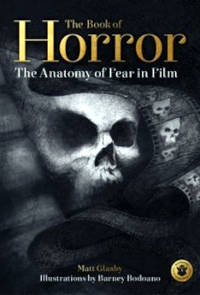
Title: The Book of Horror — The Anatomy of Fear in Film
Author: Matt Glasby
Hardcover: 176 pages
Publisher: Frances Lincoln Publishers Ltd (September 2020)
Language: English
ISBN-10: 0-7112-5178-9
ISBN-13: 978-0-7112-5178-6
Product Dimensions: 19,94 x 2,41 x 25,4 cm
Book Description from the publisher
"Horror," said legendary director John Carpenter, "is a reaction; it’s not a genre."
While it is unwise to argue with the master, perhaps it is more accurate to say that horror is a genre unlike any other — except comedy — because it depends upon a reaction.
Whether they deal with monsters, murderers or creeping madness, horror films are trying to scare us. As Professor Darryl Jones notes in Sleeping With the Lights On, even the word "horror", derived from the Latin horrere, signifies an involuntary response: to cause our hair to stand on end, to make us tremble or shudder.
This is why what constitutes a horror film is an issue of style not subject matter. Despite centering on a supernatural being, Casper is clearly not a horror film; yet Annabelle — about a toy doll — most certainly is. Equally, though they contain horrifying moments, the likes of Jaws, Alien and The Silence of the Lambs do not qualify because scaring us is not their primary objective.
Scare Tactics: Throughout the book, each of the seven scare tactics is represented by its own bespoke symbol. The symbols appear in the text to show that a particular scare tactic is relevant to a particular scene or aspect of the film.
They are also used in a summary infographic to illustrate how much each film uses each scare tactic overall. A second infographic charts the intensity and timings of the film’s most frightening moments.
About the author
Matt Glasby is an international film journalist, author and member of the London Critics' Circle. His work appears in GQ, Total Film and SFX among other publications, and he the associate editor of Vera magazine. He has written two books: Britpop Cinema: From Trainspotting To This Is England (Intellect, 2019) and A-Z Great Film Directors (Cassell, 2015).
Very short excerpts
Although it never reveals its ghosts, Hill House's assaults feel unending. At night, Nell and Theo hear a booming in the corridor outside their room, which builds until it seems as if someone is "knocking on the door with a cannonball". The camera pans around the room, nervously, catching the pair in an old patinated mirror, then showing them cowering from a high angle: their unseen assailant's point of view. When the door moves, Wise zooms in lightning fast on the handle, which turns with dreadful purpose.
In a later attack, the door actually bulges inward, its adornments, seen from below, making it look like a throttled human face. As a special effect it proved especially economical. "All I had was a strong prop man on the other side who would push it and move it," Wise told American Cinematographer. "That's all it was and it scared the hell out of everybody."
Before the shoot, sound editor Allan Sones and his crew decamped to a seventeenth-century manor house to record its creaks and groans, resulting in a soundtrack that terrified studio technicians. For the scenes in which the characters hear noises off-camera, a "pre-score" of voices — laughing, crying, screaming — was created to be played during shooting. It remains in the finished film.
'The Letters of Shirley Jackson'
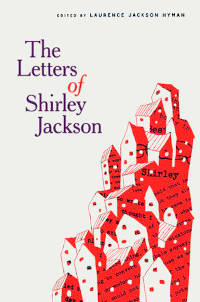
Title: The Letters of Shirley Jackson
Author: Shirley Jackson
Editor: Laurence Jackson Hyman
Hardcover: 672 pages
Publisher: Random House Group (July 2021)
Language: English
ISBN-10: 0-593-13464-8
ISBN-13: 978-0-593-13464-1
Product Dimensions: 6.38 x 9.52 x 1.6 inches; 16,2 x 24,18 x 4 cm
Also available in eBook (978-0-593-13466-5) and Audiobook (978-0-593-41214-5).
Book Description from the publisher
A bewitchingly brilliant collection of never-before-published letters from the renowned author of "The Lottery" and "The Haunting of Hill House."
Named one of the best books of the year by kirkus reviews.
"This biography-through-letters gives an intimate and warm voice to the imagination behind the treasury of uncanny tales that is Shirley Jackson's legacy." ~ Joyce Carol Oates
Shirley Jackson is one of the most important American authors of the last hundred years and among our greatest chroniclers of the female experience. This extraordinary compilation of personal correspondence has all the hallmarks of Jackson's beloved fiction: flashes of the uncanny in the domestic, sparks of horror in the quotidian, and the veins of humor that run through good times and bad.
Written over the course of nearly three decades, from Jackson's college years to six days before her early death at the age of forty-eight, these letters become the autobiography Shirley Jackson never wrote. As well as being a bestselling author, Jackson spent much of her adult life as a mother of four in Vermont, and the landscape here is often the everyday: raucous holidays and trips to the dentist, overdue taxes and frayed lines of Christmas lights, new dogs and new babies. But in recounting these events to family, friends, and colleagues, she turns them into remarkable stories: entertaining, revealing, and wise. At the same time, many of these letters provide fresh insight into the genesis and progress of Jackson's writing over nearly three decades.
About the author
Compiled and edited by her elder son, Laurence Jackson Hyman, in consultation with Jackson scholar Bernice M. Murphy and featuring Jackson's own witty line drawings, this intimate collection holds the beguiling prism of Shirley Jackson — writer and reader, mother and daughter, neighbor and wife — up to the light.
'Dancing on the edge'

Title: Dancing on the edge — A journey of living, loving and tumbling though Hollywood
Author: Russ Tamblyn (with Sarah Tomlinson)
Hardcover: 364 pages
Publisher: Blackstone Publishing (April 2024)
Language: English
ISBN-13: 979-8-21227331-2
Product Dimensions: 6.5 x 1.25 x 9.5 inches; 16,50 x 3,20 x 24,10 cm
Also available in paperback (979-8-87481268-3), Audiobook (979-8-21227618-4), Audio CD (979-8-21227613-9) and eBook (979-8-21227621-4).
Book Description from the publisher
A bold memoir of an extraordinary, singular life lived by one of the world's most beloved and acclaimed figures: Russ Tamblyn.
With more than eighty years as a celebrated artist and actor under his belt, Russ Tamblyn has earned a cherished name among cinephiles and pop culture fans alike, working with such legendary directors as Robert Wise, David Lynch, and Quentin Tarantino. He tumbled through his acclaimed starring role in the original West Side Story as an actor and acrobatic dancer, taught Elvis Presley some signature dance moves, and became an unlikely visionary in the counterculture movement of the '60s alongside peers and friends Ed Ruscha and Dennis Hopper.
Russ deftly guides readers through his star-studded life and his search for a deeper, more connected existence: attending school with Elizabeth Taylor, earning an Academy Award nomination for Peyton Place, dropping out of Hollywood at the height of his career to become a fine artist in Topanga Canyon, and forging a lifelong friendship with Neil Young. He shares the painful breakup of a twenty-year marriage and the joy of finding true love and inspiration as a husband, father, and mentor in his own right.
Perfect for old and new fans alike, Dancing on the Edge is an intimate and powerful story about the singular life of one of our most gifted storytellers, artists, and stars of the silver screen.
About the author
Russ Tamblyn, is an Academy Award-nominated actor, dancer, choreographer, director, and artist best known as Riff in the iconic 1961 film West Side Story and Dr. Jacoby in David Lynch's cult-classic television show, Twin Peaks, as well as for his contribution to the art, music, and counterculture movements of the 1960s. His eight-millimeter films and collage-and-assemblage art have appeared in numerous exhibitions, including at the Los Angeles Institute of Contemporary Art, the Los Angeles County Museum of Art, and the Getty. He lives in Los Angeles.
Very short excerpt
[...] On their list, he [Robert Wise] found Ettington Park, a formidable manor that turned out to be the perfect locale. Located several miles outside Stratford-upon-Avon, it was being used as a pub and inn. The grounds in back of the hall had a little graveyard next to a small chapel. It purported to have several ghosts that had been seen numerous times for more than a hundred years, including one known as Lady Emma. She normally appeared inside the hotel, where she would glide along the corridors at night and then vanish into the wall.
I wasn't exactly a believer in ghosts, but I really wanted to see one during the single night we filmed at the hotel. So I guess that did make me kind of a believer. When the light and noise from the all-night shoot kept me awake, I headed to the back of the inn, where the chapel and graves were. It was very dark. I could hardly see anything in front of me but walked very slowly on the dimly lit path until I sensed I was fairly close to the chapel. I stopped and turned to look back at the inn. Suddenly, I felt like someone had put a brick of ice on the back of my neck. The chill was so pronounced I stopped in my tracks and bent forward in state of fear. It was more than just mental; it felt physical, like someone pushing down on my shoulders with frozen hands. Somehow, I knew if I did turn around, I would see the specter. I reasoned with myself: That why I came out here in the first place! But now that I was faced with the prospect of an actual ghost, I was terrified and rushed back to the inn. Safe in my room, I felt a little embarrassed by how scared I had been, and I never told anyone about my weird experience that night. Ever since, I have wanted another chance to face a ghost, but it has never happened.
Homage
'The Grownup'
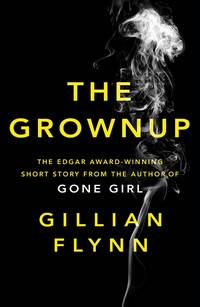
Title: The Grownup
Author: Gillian Flynn
Paperback: 64 pages
Publisher: Crown Publishers (November 2015)
Language: English
ISBN-10: 0-8041-8897-1
ISBN-13: 978-0-8041-8897-5
Product Dimensions: 4.7 x 0.5 x 7.3 inches; 12 x 1,2 x 18,5 cm
Book Description from Amazon
A canny young woman is struggling to survive by perpetrating various levels of mostly harmless fraud. On a rainy April morning, she is reading auras at Spiritual Palms when Susan Burke walks in. A keen observer of human behavior, our unnamed narrator immediately diagnoses beautiful, rich Susan as an unhappy woman eager to give her lovely life a drama injection. However, when the "psychic" visits the eerie Victorian home that has been the source of Susan's terror and grief, she realizes she may not have to pretend to believe in ghosts anymore. Miles, Susan's teenage stepson, doesn't help matters with his disturbing manner and grisly imagination. The three are soon locked in a chilling battle to discover where the evil truly lurks and what, if anything, can be done to escape it.
The Grownup, which originally appeared as What Do You Do? in George R. R. Martin's Rogues anthology, proves once again that Gillian Flynn is one of the world's most original and skilled voices in fiction.
About the author
Gillian Flynn is the author of the #1 New York Times bestseller Gone Girl and the New York Times bestsellers Dark Places and Sharp Objects. A former writer and critic for Entertainment Weekly, she lives in Chicago with her husband and children.
Very short excerpts — quoting "The Haunting of Hill House"
[...] The only thing I really knew about Mike was he loved books. He recommended books with the fervor I've always craved as an aspiring nerd: with urgency and camaraderie. You have to read this! Pretty soon we had our own private (occasionally sticky) book club. He was big into "Classic Stories of the Supernatural" and he wanted me to be too ("You are a psychic after all," he said with a smile). So that day we discussed the themes of loneliness and need in The Haunting of Hill House. [...]
[...] My favorite client. Every book I ever read with Mike over the past few years was here. The Woman in White, The Turn of the Screw, The Haunting of Hill House. I'd congratulated myself when I'd seen them — how clever I was to have read so many of these fancy-people library books. [...]

